Paul van Yperen's Blog, page 131
March 15, 2022
Der Schut (1964)
Der Schut/The Yellow One (Robert Siodmak, 1964) is the first film adaptation in the 1960s of the oriental novels by best-selling 19th-century German writer Karl May. These adventure novels are set in the Orient and the Middle East and feature Kara Ben Nemsi who travels throughout the Ottoman Empire, alongside his friend and servant Hadschi Halef Omar. In Der Schut, Lex Barker stars as Kara Ben Nemsi and Ralf Wolter plays Halef. German-born Hollywood director Robert Siodmak, famous for the Burt Lancaster classics The Killers (1946) and The Crimson Pirate (1952), directed the picture on location in Yugoslavia.
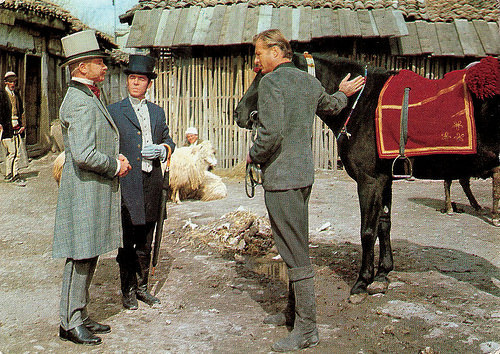
German postcard by Heinerle Karl-May-Postkarten, no. 2. Photo: CCC / Gloria. Dieter Borsche , Chris Howland and Lex Barker in Der Schut/The Yellow One (Robert Siodmak, 1964). Caption: "Mister Kara, so good that I meet you. Your friend Galingré was attacked and kidnapped by bandits of the Yellow One. A certain Nirwan visited me on board of my yacht and told me about it .'- 'In these circumstances, I can not travel with you to Egypt of course, Sir David, which will you understand. I will ride to Strumnitza where my kidnapped friend's wife lives ... I need to find the Yellow One'!"
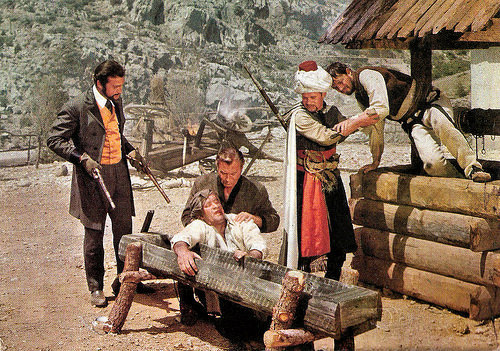
German postcard by Heinerle Karl-May-Postkarten, no. 7. Photo: CCC / Gloria. Publicity still for Der Schut/The Yellow One (Robert Siodmak, 1964). Caption: "Do not worry, my good man. We are friends of yours. My Sidi, the famous Kara Ben Nemsi, and I will do everything possible to catch these rogues, the Schut."
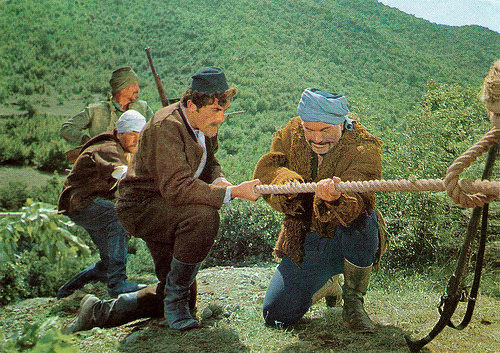
German postcard by Heinerle Karl-May-Postkarten, no. 9. Photo: CCC / Gloria. Renato Baldini in Der Schut/The Yellow One (Robert Siodmak, 1964). Caption: "'Barud, take my knife! '- 'Yes, now it gets better! If someone should like to persecute us, then he just needs to come across the bridge."
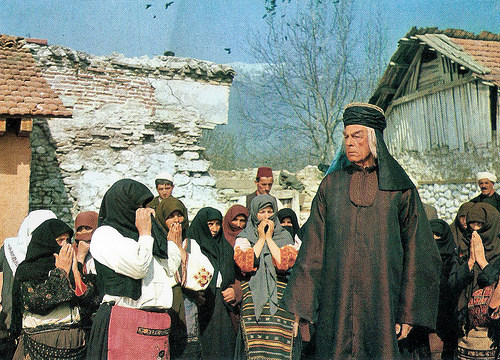
German postcard by Heinerle Karl-May-Postkarten, no. 13. Photo: CCC / Gloria. Friedrich von Ledebur in Der Schut/The Yellow One (Robert Siodmak, 1964). Caption: "I am so afraid of the Holy Mübarek, he will be angry that I speak to you, and his ravens will tell him what I told you ... That he warned the people for you ...!"
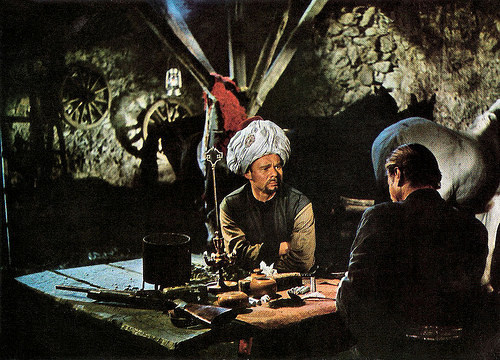
German postcard by Heinerle Karl-May-Postkarten, no. 15. Photo: CCC / Gloria. Ralf Wolter and Lex Barker in Der Schut/The Yellow One (Robert Siodmak, 1964). Caption: "In the evening at home Galingré: 'Halef, I will play a trick on the Mübarek. Therefore, you had to get me bismuth and mercury. From this, I'll make bullets that look like lead bullets but disintegrate during firing. Now I'll load the gun alternately with a bullet made of lead and a fake one ...'"
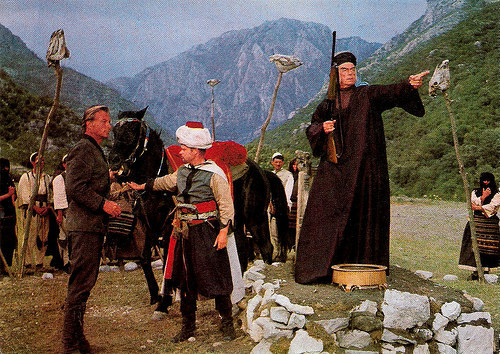
German postcard by Heinerle Karl-May-Postkarten, no. 16. Photo: CCC / Gloria. Lex Barker , Ralf Wolter and Friedrich von Ledebur in Der Schut/The Yellow One (Robert Siodmak, 1964). Caption: "The Holy Mübarek faces his opponent, Kara Ben Nemsi. "This blonde Giaur will be punished because he shot a sacred raven. It is the will of Allah!" - You lie, Mübarek. It is not God's will but yours. You're afraid of me because I am a greater magician than you. I want to prove it to you. Here is a gun that shoots more accurately and better than any other. If you can meet with a single bullet, then it should belong to you, Mübarek. Halef, show him the rifle and how to fire it."
Heroic Kara Ben Nemsi
The secretive 'Schut' or 'The Yellow One' ( Rik Battaglia ) is a bandit king who terrorises a whole region in the land of the Skipetars - modern Albanians, one of the few Balkan people who adopted the Turkish Muslim faith. He controls the land in the disguise of the wealthy Persian carpet merchant Nirwan.
The Schut holds an English aristocrat and a French merchant for a ransom, then he also abducts the beautiful Tschita ( Marie Versini ), Kara's friend Omar's fiancée. The corrupt police force does not take any action against him.
Heroic Kara Ben Nemsi, the Turkish-Arabic name means 'black(bearded) German' ( Lex Barker ) tries to find the Schut's hiding-place in the mountains and free the prisoners. But the Schut has many rogues and assassins under his command who make this search long and dangerous.
After unmasking the Mübarek, a local phony 'magician', and dealing with some other ruffians and corruption, Kara Ben Nemsi and Lord Lindsay ( Dieter Borsche ) with his butler Archie ( Chris Howland ) set out to finish The Schut off.
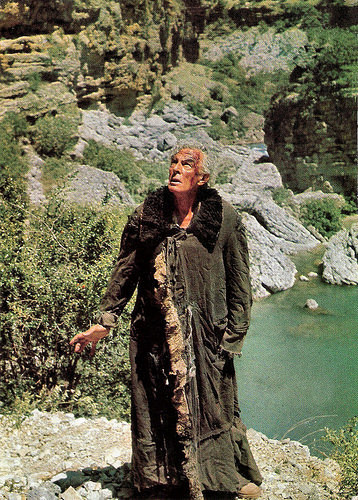
German postcard by Heinerle Karl-May-Postkarten, no. 17. Photo: CCC / Gloria. Friedrich von Ledebur in Der Schut/The Yellow One (Robert Siodmak, 1964). Caption: "Do you see what's behind the mask of this saint? Halif has torn down his coat and forth came the tattered dress of the supposedly lame and deaf-mute beggar Busra. He was always everywhere and nowhere - despite his ill legs. Not the Ravens have told the Mübarek everything, but he could hear himself what was being said about him."
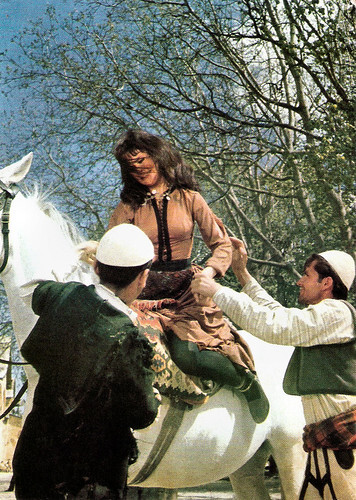
West-German postcard by Heinerle Karl-May-Postkarten, no. 20. Photo: CCC / Gloria-Verleih. Marie Versini in Der Schut/The Yellow One (Robert Siodmak, 1964). Caption: "Let go of me! If you don't want to help me, then at least let me ride away. Let me go, I want to leave!"
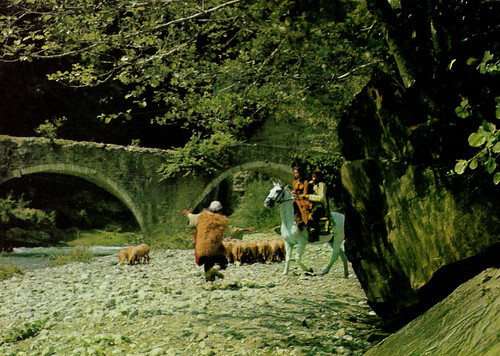
West-German postcard by Heinerle Karl-May-Postkarten, no. 22. Photo: CCC / Gloria-Verleih. Marie Versini in Der Schut/The Yellow One (Robert Siodmak, 1964). Caption: Manach returned to the hostel and dragged Chita on. "Hello, shepherd! I've got a pretty little bird that Schut has been waiting for. I'll take her to a cave now. In the meantime, hold my horse!"
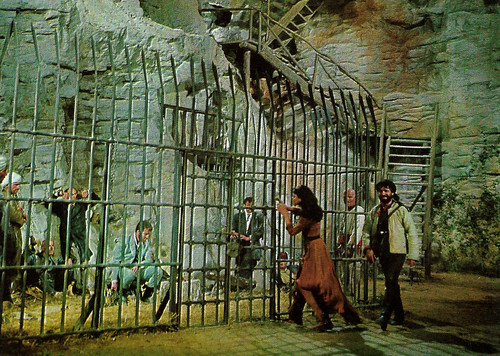
West-German postcard by Heinerle Karl-May-Postkarten, no. 24. Photo: CCC / Gloria-Verleih. Marie Versini in Der Schut/The Yellow One (Robert Siodmak, 1964). Caption: "You have a visitor, gentlemen! Here sit all those who have disobeyed the Schut. That one, in the grey suit, is Monsieur Galingré, a man with a lot of money, haha!"
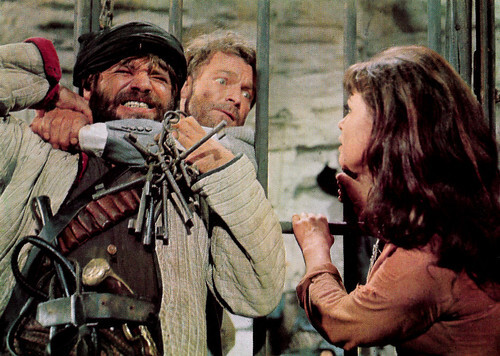
West-German postcard by Heinerle Karl-May-Postkarten, no. 25. Photo: CCC / Gloria-Verleih. Pierre Fromont and Marie Versini in Der Schut/The Yellow One (Robert Siodmak, 1964). Caption: "Monsieur Galingré - for God's sake what are you doing!" - "Don't mind me! Get out of here as fast as you can, or you'll be lost!" - "You'll pay for this, Frenchman, you scoundrel!"
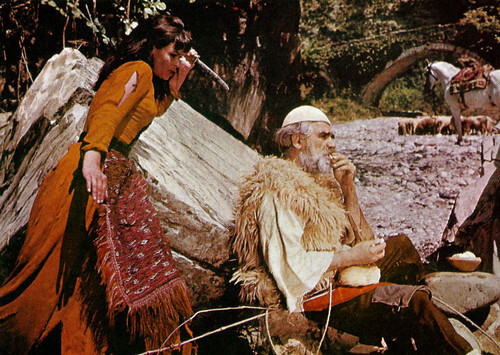
West-German postcard by Heinerle Karl-May-Postkarten, no. 26. Photo: CCC / Gloria-Verleih. Marie Versini in Der Schut/The Yellow One (Robert Siodmak, 1964). Caption: Chita, who escaped from prison as silently as a wildcat, is fighting for life and limb. Her unsuspecting guard is already a dead man.
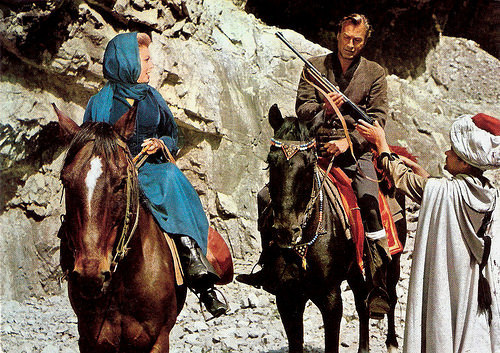
German postcard by Heinerle Karl-May-Postkarten, no. 29. Photo: CCC / Gloria. Marianne Hold and Lex Barker in Der Schut/The Yellow One (Robert Siodmak, 1964). Caption: "How glad I am that nothing happened to you, Mister Kara ( Lex Barker ). I heard the shots ...." - 'As you can see, everything went well with this Mübarek, Madame Galingré ( Marianne Hold ). Fine that you brought the horses. Omar, Halef, and I can immediately do on with the persecution of The Yellow One'."
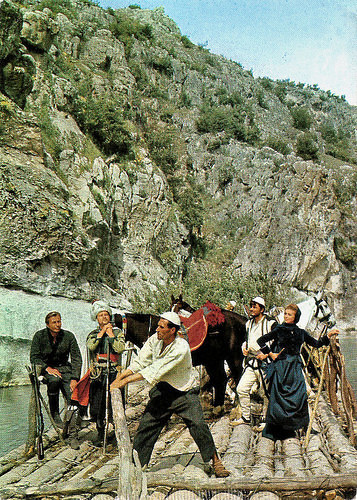
German postcard by Heinerle Karl-May-Postkarten, no. 31. Photo: CCC / Gloria. Lex Barker , Ralf Wolter and Marianne Hold in Der Schut/The Yellow One (Robert Siodmak, 1964). Caption: "The fully loaded raft. A good target for the bandits, who are hiding between the rocks."
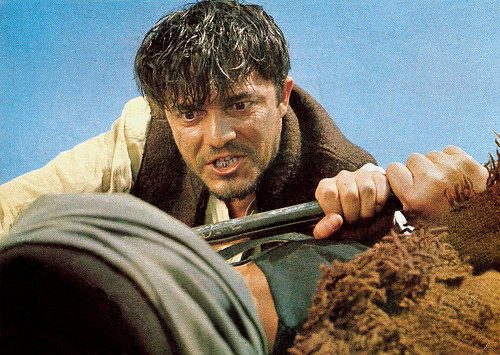
German postcard by Heinerle Karl-May-Postkarten, no. 36. Photo: CCC / Gloria. Dusan Janicijevic in Der Schut/The Yellow One (Robert Siodmak, 1964). Caption: "For the last time! Where is my bride Tschita? Where did you drag her?"
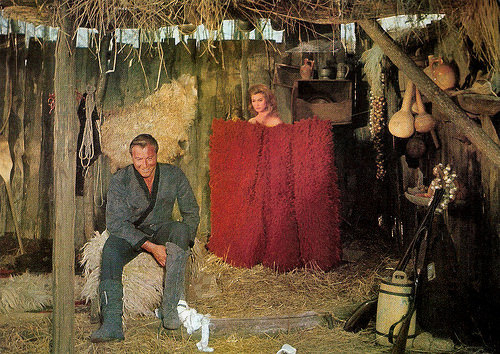
German postcard by Heinerle Karl-May-Postkarten, no. 37. Photo: CCC / Gloria. Lex Barker and Marianne Hold Der Schut/The Yellow One (Robert Siodmak, 1964). Caption: "A short break is inserted, so Madame Galingré can recover from the rigors of the raid. The next morning the search for the Yellow One will be continued."
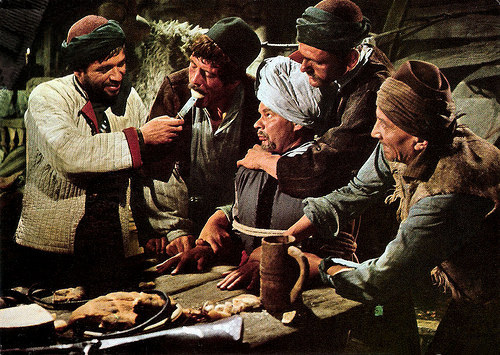
German postcard by Heinerle Karl-May-Postkarten, no. 39. Photo: CCC / Gloria. Ralf Wolter in Der Schut/The Yellow One (Robert Siodmak, 1964). Caption: "They have pulled Halef into the canyon lodge and tied him up there. 'Where is Kara holding on? Speak... or! '- But Halef remains silent and resists all threats and beatings."
Karl May's Oriental Cycle
Der Schut was not the first adaptation of the Oriental novels with Kara Ben Nemsi by Karl May. In 1920, May's friends Marie Luise Droop and her husband Adolf Droop among others founded in cooperation with the Karl May Press the production company Ustad-Film.
They produced three silent films: Auf den Trümmern des Paradieses/On the Brink of Paradise (Josef Stein, 1920), Die Todeskarawane/Caravan of Death (Josef Stein, 1920) and Die Teufelsanbeter/The Devil Worshippers (Marie Luise Droop, 1920), all starring Carl de Vogt as Kara Ben Nemsi. These three films are believed to be lost. Due to the low success, Ustad-Film went bankrupt in the following year.
The first sound film was Durch die Wüste/Through the Desert (J.A. Hübler-Kahla, 1936). Kara Ben Nemsi was played by Fred Raupach.
The German-Spanish Die Sklavenkarawane/Caravan of Slaves (Georg Marischka, Ramón Torrado, 1958) and its sequel Der Löwe von Babylon/The Lion of Babylon (Johannes Kai, Ramón Torrado, 1959) were the first colour films. In the first film, Kara Ben Nemsi was played by Viktor Staal and in the second by Helmuth Schneider . In both films, Halef was played by Georg Thomalla and Sir David Lindsay by Theo Lingen .
Famous is the Karl May film wave from 1962–1968, which was one of the most successful German film series ever. Most of these films were made separately by the two competitors Horst Wendlandt and Artur Brauner.
Most of the 17 films of this series were Westerns starring Pierre Brice as Winnetou, beginning with Der Schatz im Silbersee/The Treasure of the Silver Lake (Harald Reinl, 1962).
Three of the films were based on the Orient cycle. After Der Schut followed Durchs wilde Kurdistan/Wild Kurdistan (Franz Josef Gottlieb, 1965) and Im Reiche des silbernen Löwen/Kingdom of the Silver Lion (Franz Josef Gottlieb, 1965). In all three films, Lex Barker starred as Kara Ben Nemsi.
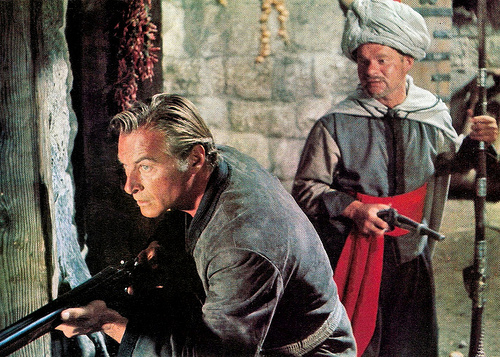
German postcard by Heinerle Karl-May-Postkarten, no. 40. Photo: CCC / Gloria. Lex Barker and Ralf Wolter in Der Schut/The Yellow One (Robert Siodmak, 1964). Caption: "Kara, who suddenly missed his faithful servant, has followed in his footsteps, and could free him in time from the clutches of the bandits. Kara now takes each bandit on the grain with his dreaded bear hunter."
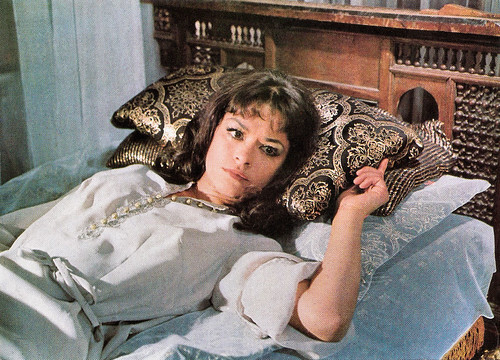
West-German postcard by Heinerle Karl-May-Postkarten, no. 41. Photo: CCC / Gloria-Verleih. Marie Versini in Der Schut/The Yellow One (Robert Siodmak, 1964). Caption: By force, the Schut wants to subdue his beautiful prey. Greed and boundless jealousy surround her in a golden cage. How can I get out of here?, thinks Chita.
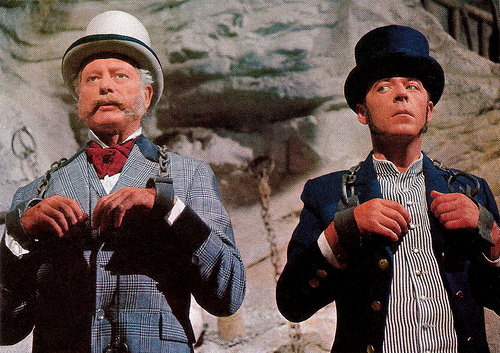
German postcard by Heinerle Karl-May-Postkarten, no. 43. Photo: CCC / Gloria. Dieter Borsche and Chris Howland in Der Schut/The Yellow One (Robert Siodmak, 1964). Caption: "'Archibald now what?', Sir Lindsay asks his butler, when The Shoot unexpectedly captures them in a cave, which is located beneath his palace."
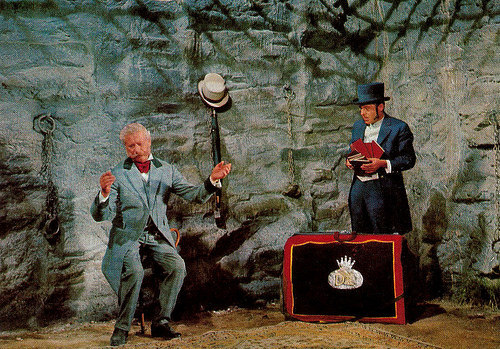
German postcard by Heinerle Karl-May-Postkarten, no. 44. Photo: CCC / Gloria. Dieter Borsche and Chris Howland in Der Schut/The Yellow One (Robert Siodmak, 1964). Caption: "The Lord and his servant won't be shaken by the situation. Archie has in his magical suitcase everything ready to make his Lord's stay in the cave as pleasant as possible."
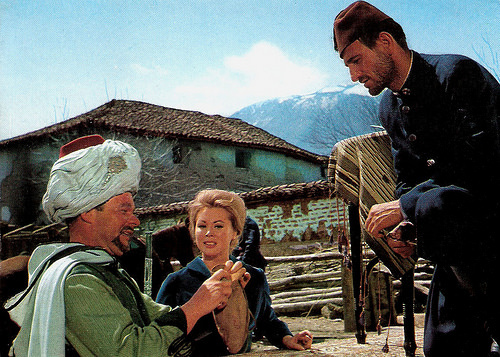
German postcard by Heinerle Karl-May-Postkarten, no. 46. Photo: CCC / Gloria. Ralf Wolter and Marianne Hold in Der Schut/The Yellow One (Robert Siodmak, 1964). Caption: "By a ruse and with the help of Turkish soldiers, the faithful servant Halef can free his beloved Lord, Kara Ben Nemsi, from the hands of the Yellow One, who has imprisoned him."
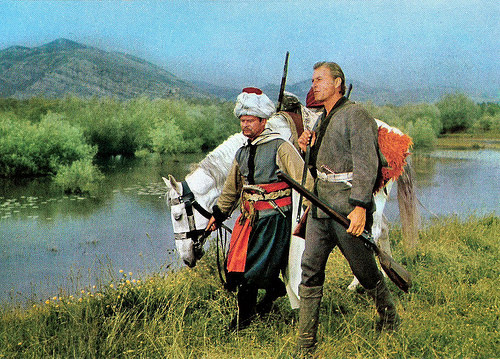
German postcard by Heinerle Karl-May-Postkarten, no. 48. Photo: CCC / Gloria. Ralf Wolter and Lex Barker in Der Schut/The Yellow One (Robert Siodmak, 1964). Caption: "The Farewell Bell Tolls. Kara wants to return to his homeland. Sad Halef says his beloved Lord "Good-bye". 'Sidi, we 'll meet again, when the son of Rih has seen the light of day!'"
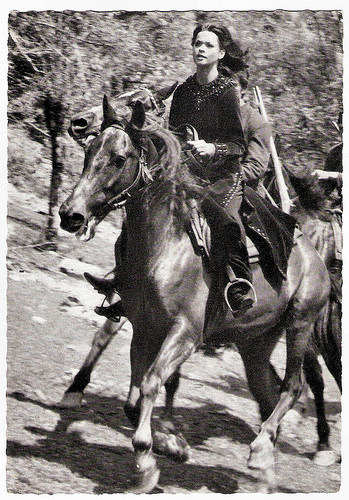
German postcard by Filmbilder-Vertrieb Ernst Freihoff, Essen, no. 921. Retail price: 10 Pfg. Photo: Gloria / Schnelle. Marie Versini as Tschita in Der Schut/The Yellow One (Robert Siodmak, 1964).
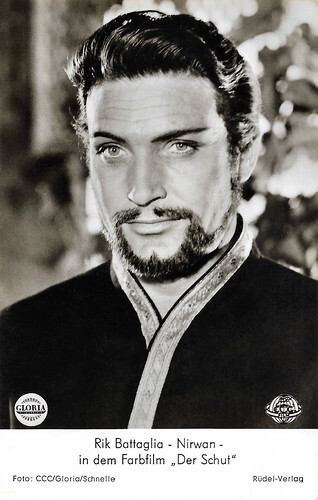
German postcard by Rüdel-Verlag. Photo: CCC / Gloria. Rik Battaglia in Der Schut/The Yellow One (Robert Siodmak, 1964).
Sources: Wikipedia and IMDb.

German postcard by Heinerle Karl-May-Postkarten, no. 2. Photo: CCC / Gloria. Dieter Borsche , Chris Howland and Lex Barker in Der Schut/The Yellow One (Robert Siodmak, 1964). Caption: "Mister Kara, so good that I meet you. Your friend Galingré was attacked and kidnapped by bandits of the Yellow One. A certain Nirwan visited me on board of my yacht and told me about it .'- 'In these circumstances, I can not travel with you to Egypt of course, Sir David, which will you understand. I will ride to Strumnitza where my kidnapped friend's wife lives ... I need to find the Yellow One'!"

German postcard by Heinerle Karl-May-Postkarten, no. 7. Photo: CCC / Gloria. Publicity still for Der Schut/The Yellow One (Robert Siodmak, 1964). Caption: "Do not worry, my good man. We are friends of yours. My Sidi, the famous Kara Ben Nemsi, and I will do everything possible to catch these rogues, the Schut."

German postcard by Heinerle Karl-May-Postkarten, no. 9. Photo: CCC / Gloria. Renato Baldini in Der Schut/The Yellow One (Robert Siodmak, 1964). Caption: "'Barud, take my knife! '- 'Yes, now it gets better! If someone should like to persecute us, then he just needs to come across the bridge."

German postcard by Heinerle Karl-May-Postkarten, no. 13. Photo: CCC / Gloria. Friedrich von Ledebur in Der Schut/The Yellow One (Robert Siodmak, 1964). Caption: "I am so afraid of the Holy Mübarek, he will be angry that I speak to you, and his ravens will tell him what I told you ... That he warned the people for you ...!"

German postcard by Heinerle Karl-May-Postkarten, no. 15. Photo: CCC / Gloria. Ralf Wolter and Lex Barker in Der Schut/The Yellow One (Robert Siodmak, 1964). Caption: "In the evening at home Galingré: 'Halef, I will play a trick on the Mübarek. Therefore, you had to get me bismuth and mercury. From this, I'll make bullets that look like lead bullets but disintegrate during firing. Now I'll load the gun alternately with a bullet made of lead and a fake one ...'"

German postcard by Heinerle Karl-May-Postkarten, no. 16. Photo: CCC / Gloria. Lex Barker , Ralf Wolter and Friedrich von Ledebur in Der Schut/The Yellow One (Robert Siodmak, 1964). Caption: "The Holy Mübarek faces his opponent, Kara Ben Nemsi. "This blonde Giaur will be punished because he shot a sacred raven. It is the will of Allah!" - You lie, Mübarek. It is not God's will but yours. You're afraid of me because I am a greater magician than you. I want to prove it to you. Here is a gun that shoots more accurately and better than any other. If you can meet with a single bullet, then it should belong to you, Mübarek. Halef, show him the rifle and how to fire it."
Heroic Kara Ben Nemsi
The secretive 'Schut' or 'The Yellow One' ( Rik Battaglia ) is a bandit king who terrorises a whole region in the land of the Skipetars - modern Albanians, one of the few Balkan people who adopted the Turkish Muslim faith. He controls the land in the disguise of the wealthy Persian carpet merchant Nirwan.
The Schut holds an English aristocrat and a French merchant for a ransom, then he also abducts the beautiful Tschita ( Marie Versini ), Kara's friend Omar's fiancée. The corrupt police force does not take any action against him.
Heroic Kara Ben Nemsi, the Turkish-Arabic name means 'black(bearded) German' ( Lex Barker ) tries to find the Schut's hiding-place in the mountains and free the prisoners. But the Schut has many rogues and assassins under his command who make this search long and dangerous.
After unmasking the Mübarek, a local phony 'magician', and dealing with some other ruffians and corruption, Kara Ben Nemsi and Lord Lindsay ( Dieter Borsche ) with his butler Archie ( Chris Howland ) set out to finish The Schut off.

German postcard by Heinerle Karl-May-Postkarten, no. 17. Photo: CCC / Gloria. Friedrich von Ledebur in Der Schut/The Yellow One (Robert Siodmak, 1964). Caption: "Do you see what's behind the mask of this saint? Halif has torn down his coat and forth came the tattered dress of the supposedly lame and deaf-mute beggar Busra. He was always everywhere and nowhere - despite his ill legs. Not the Ravens have told the Mübarek everything, but he could hear himself what was being said about him."

West-German postcard by Heinerle Karl-May-Postkarten, no. 20. Photo: CCC / Gloria-Verleih. Marie Versini in Der Schut/The Yellow One (Robert Siodmak, 1964). Caption: "Let go of me! If you don't want to help me, then at least let me ride away. Let me go, I want to leave!"

West-German postcard by Heinerle Karl-May-Postkarten, no. 22. Photo: CCC / Gloria-Verleih. Marie Versini in Der Schut/The Yellow One (Robert Siodmak, 1964). Caption: Manach returned to the hostel and dragged Chita on. "Hello, shepherd! I've got a pretty little bird that Schut has been waiting for. I'll take her to a cave now. In the meantime, hold my horse!"

West-German postcard by Heinerle Karl-May-Postkarten, no. 24. Photo: CCC / Gloria-Verleih. Marie Versini in Der Schut/The Yellow One (Robert Siodmak, 1964). Caption: "You have a visitor, gentlemen! Here sit all those who have disobeyed the Schut. That one, in the grey suit, is Monsieur Galingré, a man with a lot of money, haha!"

West-German postcard by Heinerle Karl-May-Postkarten, no. 25. Photo: CCC / Gloria-Verleih. Pierre Fromont and Marie Versini in Der Schut/The Yellow One (Robert Siodmak, 1964). Caption: "Monsieur Galingré - for God's sake what are you doing!" - "Don't mind me! Get out of here as fast as you can, or you'll be lost!" - "You'll pay for this, Frenchman, you scoundrel!"

West-German postcard by Heinerle Karl-May-Postkarten, no. 26. Photo: CCC / Gloria-Verleih. Marie Versini in Der Schut/The Yellow One (Robert Siodmak, 1964). Caption: Chita, who escaped from prison as silently as a wildcat, is fighting for life and limb. Her unsuspecting guard is already a dead man.

German postcard by Heinerle Karl-May-Postkarten, no. 29. Photo: CCC / Gloria. Marianne Hold and Lex Barker in Der Schut/The Yellow One (Robert Siodmak, 1964). Caption: "How glad I am that nothing happened to you, Mister Kara ( Lex Barker ). I heard the shots ...." - 'As you can see, everything went well with this Mübarek, Madame Galingré ( Marianne Hold ). Fine that you brought the horses. Omar, Halef, and I can immediately do on with the persecution of The Yellow One'."

German postcard by Heinerle Karl-May-Postkarten, no. 31. Photo: CCC / Gloria. Lex Barker , Ralf Wolter and Marianne Hold in Der Schut/The Yellow One (Robert Siodmak, 1964). Caption: "The fully loaded raft. A good target for the bandits, who are hiding between the rocks."

German postcard by Heinerle Karl-May-Postkarten, no. 36. Photo: CCC / Gloria. Dusan Janicijevic in Der Schut/The Yellow One (Robert Siodmak, 1964). Caption: "For the last time! Where is my bride Tschita? Where did you drag her?"

German postcard by Heinerle Karl-May-Postkarten, no. 37. Photo: CCC / Gloria. Lex Barker and Marianne Hold Der Schut/The Yellow One (Robert Siodmak, 1964). Caption: "A short break is inserted, so Madame Galingré can recover from the rigors of the raid. The next morning the search for the Yellow One will be continued."

German postcard by Heinerle Karl-May-Postkarten, no. 39. Photo: CCC / Gloria. Ralf Wolter in Der Schut/The Yellow One (Robert Siodmak, 1964). Caption: "They have pulled Halef into the canyon lodge and tied him up there. 'Where is Kara holding on? Speak... or! '- But Halef remains silent and resists all threats and beatings."
Karl May's Oriental Cycle
Der Schut was not the first adaptation of the Oriental novels with Kara Ben Nemsi by Karl May. In 1920, May's friends Marie Luise Droop and her husband Adolf Droop among others founded in cooperation with the Karl May Press the production company Ustad-Film.
They produced three silent films: Auf den Trümmern des Paradieses/On the Brink of Paradise (Josef Stein, 1920), Die Todeskarawane/Caravan of Death (Josef Stein, 1920) and Die Teufelsanbeter/The Devil Worshippers (Marie Luise Droop, 1920), all starring Carl de Vogt as Kara Ben Nemsi. These three films are believed to be lost. Due to the low success, Ustad-Film went bankrupt in the following year.
The first sound film was Durch die Wüste/Through the Desert (J.A. Hübler-Kahla, 1936). Kara Ben Nemsi was played by Fred Raupach.
The German-Spanish Die Sklavenkarawane/Caravan of Slaves (Georg Marischka, Ramón Torrado, 1958) and its sequel Der Löwe von Babylon/The Lion of Babylon (Johannes Kai, Ramón Torrado, 1959) were the first colour films. In the first film, Kara Ben Nemsi was played by Viktor Staal and in the second by Helmuth Schneider . In both films, Halef was played by Georg Thomalla and Sir David Lindsay by Theo Lingen .
Famous is the Karl May film wave from 1962–1968, which was one of the most successful German film series ever. Most of these films were made separately by the two competitors Horst Wendlandt and Artur Brauner.
Most of the 17 films of this series were Westerns starring Pierre Brice as Winnetou, beginning with Der Schatz im Silbersee/The Treasure of the Silver Lake (Harald Reinl, 1962).
Three of the films were based on the Orient cycle. After Der Schut followed Durchs wilde Kurdistan/Wild Kurdistan (Franz Josef Gottlieb, 1965) and Im Reiche des silbernen Löwen/Kingdom of the Silver Lion (Franz Josef Gottlieb, 1965). In all three films, Lex Barker starred as Kara Ben Nemsi.

German postcard by Heinerle Karl-May-Postkarten, no. 40. Photo: CCC / Gloria. Lex Barker and Ralf Wolter in Der Schut/The Yellow One (Robert Siodmak, 1964). Caption: "Kara, who suddenly missed his faithful servant, has followed in his footsteps, and could free him in time from the clutches of the bandits. Kara now takes each bandit on the grain with his dreaded bear hunter."

West-German postcard by Heinerle Karl-May-Postkarten, no. 41. Photo: CCC / Gloria-Verleih. Marie Versini in Der Schut/The Yellow One (Robert Siodmak, 1964). Caption: By force, the Schut wants to subdue his beautiful prey. Greed and boundless jealousy surround her in a golden cage. How can I get out of here?, thinks Chita.

German postcard by Heinerle Karl-May-Postkarten, no. 43. Photo: CCC / Gloria. Dieter Borsche and Chris Howland in Der Schut/The Yellow One (Robert Siodmak, 1964). Caption: "'Archibald now what?', Sir Lindsay asks his butler, when The Shoot unexpectedly captures them in a cave, which is located beneath his palace."

German postcard by Heinerle Karl-May-Postkarten, no. 44. Photo: CCC / Gloria. Dieter Borsche and Chris Howland in Der Schut/The Yellow One (Robert Siodmak, 1964). Caption: "The Lord and his servant won't be shaken by the situation. Archie has in his magical suitcase everything ready to make his Lord's stay in the cave as pleasant as possible."

German postcard by Heinerle Karl-May-Postkarten, no. 46. Photo: CCC / Gloria. Ralf Wolter and Marianne Hold in Der Schut/The Yellow One (Robert Siodmak, 1964). Caption: "By a ruse and with the help of Turkish soldiers, the faithful servant Halef can free his beloved Lord, Kara Ben Nemsi, from the hands of the Yellow One, who has imprisoned him."

German postcard by Heinerle Karl-May-Postkarten, no. 48. Photo: CCC / Gloria. Ralf Wolter and Lex Barker in Der Schut/The Yellow One (Robert Siodmak, 1964). Caption: "The Farewell Bell Tolls. Kara wants to return to his homeland. Sad Halef says his beloved Lord "Good-bye". 'Sidi, we 'll meet again, when the son of Rih has seen the light of day!'"

German postcard by Filmbilder-Vertrieb Ernst Freihoff, Essen, no. 921. Retail price: 10 Pfg. Photo: Gloria / Schnelle. Marie Versini as Tschita in Der Schut/The Yellow One (Robert Siodmak, 1964).

German postcard by Rüdel-Verlag. Photo: CCC / Gloria. Rik Battaglia in Der Schut/The Yellow One (Robert Siodmak, 1964).
Sources: Wikipedia and IMDb.
Published on March 15, 2022 23:00
March 14, 2022
Fabian
American singer and actor Fabian Forte (1943) a.k.a. Fabian is a former teen idol from the late 1950s to the mid-1960s who entertained audiences with his music, performances, and films. Eleven of his songs reached the Billboard Hot 100. 20th Century Fox had enjoyed success casting pop stars in films, such as Elvis Presley, and decided to do the same thing with Fabian. Until 1999, he starred in dozens of feature films, television movies, and series.
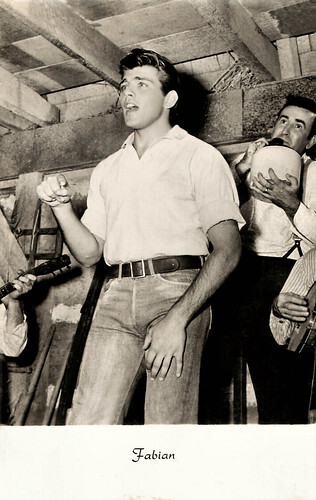
Dutch postcard, no. 1061.
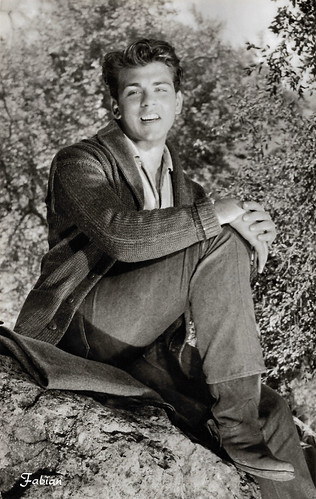
Dutch postcard by Uitgeverij Int. Filmpers, Amsterdam (I.F.P.), no. WPS 33 / 261. Photo: Chancellor. Caption: Read "Song Parade". More than 20 song texts every month.
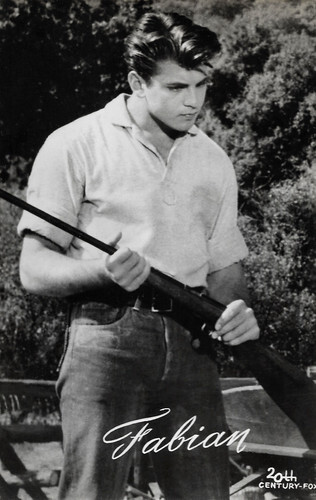
Dutch postcard by Uitg. Takken, Utrecht, no. AX 4600. Photo: 20th Century Fox. Fabian in Hound-Dog Man (Don Siegel, 1959).
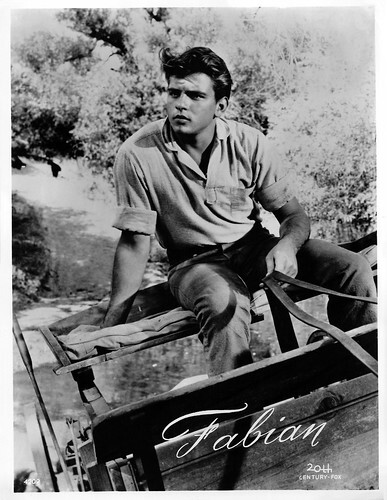
Big Dutch card. Photo: 20th Century Fox. Fabian in North to Alaska (Henry Hathaway, 1959).
The little girls at the hop went wild
Fabiano Anthony Forte, stage name Fabian, was born in Philadelphia, Pennsylvania, in 1943. He was the son of Josephine and Dominic Forte; his father was a Philadelphia police officer.
Fabian was discovered in 1957 by Bob Marcucci and Peter DeAngelis, the owners of Chancellor Records. At the time, record producers were looking to the South Philadelphia neighborhoods in search of teenage talents with good looks. Frankie Avalon, also from South Philadelphia, tipped them off about Fabian.
At 15, he won second prize as "The Promising Male Vocalist of 1958". His first local hit was 'Lilli Lou' in 1958. This helped Fabian meet Dick Clark, who agreed to try Fabian at one of Clark's record hops, where singers would perform to teenage audiences. Fabian lip-synched to a song and Clark wrote "the little girls at the hop went wild. They started screaming and yelling for this guy who didn't do a thing but stand there. I've never seen anything like it."
Clark told Marcucci: "you got a hit, he's a star. Now all you have to do is teach him to sing." Clark eventually put the young singer on American Bandstand where he sang 'I'm in Love'. From then he had a series of successes in a short time with songs by composers Doc Pomus and Mort Shuman, such as 'I'm a Man' (1958), 'Hound Dog Man' (1959), 'Turn Me Loose' (1959) and his biggest hit 'Tiger' (1959), which reached number 3 on the Billboard charts.
A few years later, he already had a dozen hits, eight albums, and three gold records to his name. His singing career more or less came to an end at the age of eighteen when he bought out his contract with Marcucci. It happened in the wake of the Payola scandal between 1959 and 1962. Forte testified before Congress that his recordings had been doctored electronically to "significantly improve his voice.
Nik Cohn later wrote that the record people had produced "a computer product" with Fabian: "He brought the basic requirements with him - an olive complexion, duck-tail hairdo and assembly-line face [...] They had him dressed up, had him learn how to talk real nice, had his voice trained. They made him really round and flawless like a billiard ball. There was only one catch: he couldn't sing ..."
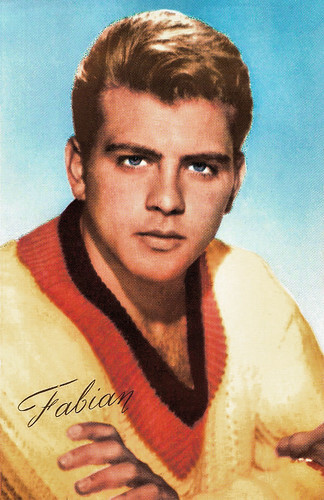
Vintage postcard.
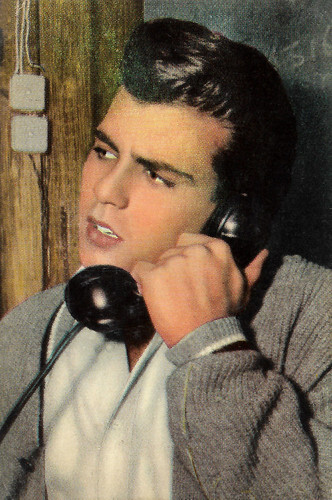
Belgian collectors card in The Twist Series, no. 2.
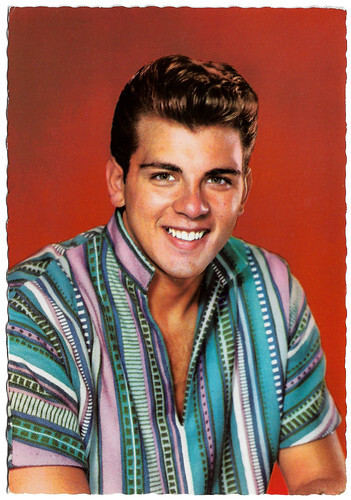
French postcard by E.D.U.G., no. 154.
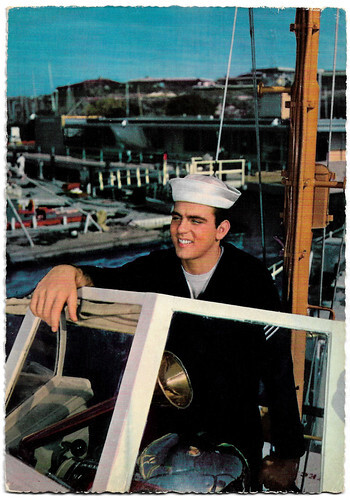
West-German postcard by Krüger. Photo: Terb Agency.
Posing nude for Playgirl
Fabian signed a deal with 20th Century Fox. The studio had enjoyed success casting teen idol pop stars in films, such as Elvis Presley and Pat Boone. They decided to do the same thing with Fabian. He played his first role in the film drama Hound-Dog Man (Don Siegel, 1959), with Stuart Whitman and Carol Lynley . The film was not a success, but the title song, sung by Fabian, became a hit in 1959.
The studio, however, tried again in two smaller roles, supporting a bigger star – the comedy High Time (Blake Edwards, 1959), with Bing Crosby, and the Western North to Alaska (Henry Hathaway, 1959), with John Wayne . Both films were popular, especially the latter, and in November 1960 his contract with the studio was amended with an increase in salary – it was now a seven-year deal with an option for two films a year.
Controversial was his role as a psychopathic killer in the episode A Lion Walks Among Us (Robert Altman, 1961) of the TV programme Bus Stop. The episode was extremely violent, leading other parties to refuse to broadcast it, and the programme was even discussed in the US Senate. However, the series was good for Fabian's acting career and saw him regarded with more respect. He later said this was his best performance.
Fabian appeared in Five Weeks in a Balloon (Irwin Allen, 1962) with Red Buttons and Barbara Eden. The film was loosely based on the 1863 novel of the same name by Jules Verne. He also played a suitor to James Stewart's daughter in the hit comedy Mr. Hobbs Takes a Holiday (Henry Koster, 1962) and a soldier in the star-studded war film The Longest Day (Andrew Marton, a.o., 1962).
Fabian had not become a film star but was in demand as an actor, appearing in episodes of series like The Virginian, Wagon Train, The Greatest Show on Earth, and The Eleventh Hour. In November 1965, he was contracted by American International Pictures. His first film for the company was alongside Beach Party stars Frankie Avalon and Annette Funicello in the stock car racing film Fireball 500 (William Asher, 1966). AIP then sent him to Italy to play a role originally intended for Avalon in Dr. Goldfoot and the Girl Bombs (Mario Bava, 1966), supporting Vincent Price .
Back in the United States, he made another stock car racing film for AIP, Thunder Alley (Richard Rush, 1967), opposite Funicello. His fourth movie for AIP was Maryjane (Maury Dexter, 1968), where Fabian played a school teacher fighting the evils of the marijuana trade. He returned to racing car dramas with The Wild Racers (Daniel Haller, 1968), partly financed by Roger Corman and shot in Europe. This was not a big hit on release but has developed a cult following. In his seventh and last film for AIP, A Bullet for Pretty Boy (Larry Buchanan, 1970), he played gangster Charles Arthur Floyd opposite Jocelyn (Jackie) Lane .
To raise his profile, he posed nude for Playgirl magazine. In 1973, he picked up singing again, only to quit temporarily in 1977 and return in 1981. He performed in the context of numerous revival shows, for example as a trio with Frankie Avalon and Bobby Rydell. However, he would not reach the popularity of his teenage years. Fabian has been married three times. His first marriage was to model Kathleen Regan in 1966. They had two children together, Christian and Julie, but they divorced in 1979. He married Kate Netter in 1980; they divorced in 1990. In 1998 he married American beauty queen Andrea Patrick. In 2002, Fabian received a star on the Hollywood Walk of Fame.
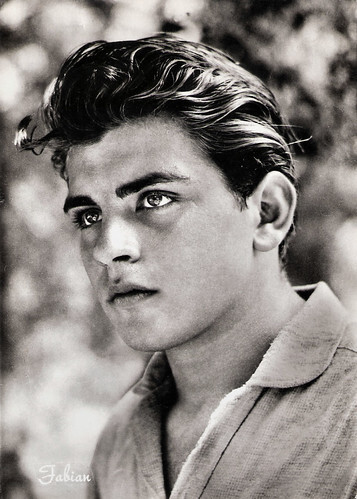
Italian postcard by Rotalfoto, no. 923. Sent by mail in 1963.
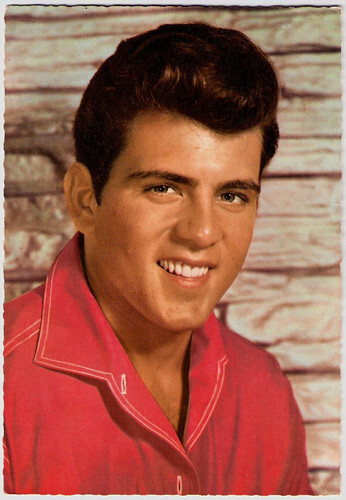
West-German postcard by ISV, no. A 98. Photo: 20th Century Fox.
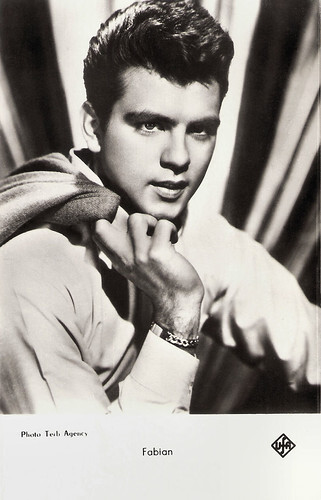
French postcard by Editions P.I., Paris, offered by Les Carbones Korès "Carboplane", no. FK 98 A. Editions P.I. was the French license holder for Universum Film AG (Ufa). Photo: Terb Agency / Ufa.
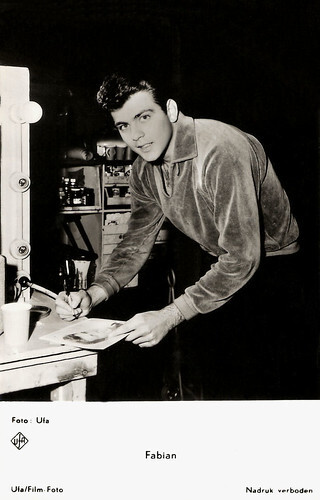
Dutch postcard. Photo: Ufa.
Sources: Wikipedia (Dutch and German) and .

Dutch postcard, no. 1061.

Dutch postcard by Uitgeverij Int. Filmpers, Amsterdam (I.F.P.), no. WPS 33 / 261. Photo: Chancellor. Caption: Read "Song Parade". More than 20 song texts every month.

Dutch postcard by Uitg. Takken, Utrecht, no. AX 4600. Photo: 20th Century Fox. Fabian in Hound-Dog Man (Don Siegel, 1959).

Big Dutch card. Photo: 20th Century Fox. Fabian in North to Alaska (Henry Hathaway, 1959).
The little girls at the hop went wild
Fabiano Anthony Forte, stage name Fabian, was born in Philadelphia, Pennsylvania, in 1943. He was the son of Josephine and Dominic Forte; his father was a Philadelphia police officer.
Fabian was discovered in 1957 by Bob Marcucci and Peter DeAngelis, the owners of Chancellor Records. At the time, record producers were looking to the South Philadelphia neighborhoods in search of teenage talents with good looks. Frankie Avalon, also from South Philadelphia, tipped them off about Fabian.
At 15, he won second prize as "The Promising Male Vocalist of 1958". His first local hit was 'Lilli Lou' in 1958. This helped Fabian meet Dick Clark, who agreed to try Fabian at one of Clark's record hops, where singers would perform to teenage audiences. Fabian lip-synched to a song and Clark wrote "the little girls at the hop went wild. They started screaming and yelling for this guy who didn't do a thing but stand there. I've never seen anything like it."
Clark told Marcucci: "you got a hit, he's a star. Now all you have to do is teach him to sing." Clark eventually put the young singer on American Bandstand where he sang 'I'm in Love'. From then he had a series of successes in a short time with songs by composers Doc Pomus and Mort Shuman, such as 'I'm a Man' (1958), 'Hound Dog Man' (1959), 'Turn Me Loose' (1959) and his biggest hit 'Tiger' (1959), which reached number 3 on the Billboard charts.
A few years later, he already had a dozen hits, eight albums, and three gold records to his name. His singing career more or less came to an end at the age of eighteen when he bought out his contract with Marcucci. It happened in the wake of the Payola scandal between 1959 and 1962. Forte testified before Congress that his recordings had been doctored electronically to "significantly improve his voice.
Nik Cohn later wrote that the record people had produced "a computer product" with Fabian: "He brought the basic requirements with him - an olive complexion, duck-tail hairdo and assembly-line face [...] They had him dressed up, had him learn how to talk real nice, had his voice trained. They made him really round and flawless like a billiard ball. There was only one catch: he couldn't sing ..."

Vintage postcard.

Belgian collectors card in The Twist Series, no. 2.

French postcard by E.D.U.G., no. 154.

West-German postcard by Krüger. Photo: Terb Agency.
Posing nude for Playgirl
Fabian signed a deal with 20th Century Fox. The studio had enjoyed success casting teen idol pop stars in films, such as Elvis Presley and Pat Boone. They decided to do the same thing with Fabian. He played his first role in the film drama Hound-Dog Man (Don Siegel, 1959), with Stuart Whitman and Carol Lynley . The film was not a success, but the title song, sung by Fabian, became a hit in 1959.
The studio, however, tried again in two smaller roles, supporting a bigger star – the comedy High Time (Blake Edwards, 1959), with Bing Crosby, and the Western North to Alaska (Henry Hathaway, 1959), with John Wayne . Both films were popular, especially the latter, and in November 1960 his contract with the studio was amended with an increase in salary – it was now a seven-year deal with an option for two films a year.
Controversial was his role as a psychopathic killer in the episode A Lion Walks Among Us (Robert Altman, 1961) of the TV programme Bus Stop. The episode was extremely violent, leading other parties to refuse to broadcast it, and the programme was even discussed in the US Senate. However, the series was good for Fabian's acting career and saw him regarded with more respect. He later said this was his best performance.
Fabian appeared in Five Weeks in a Balloon (Irwin Allen, 1962) with Red Buttons and Barbara Eden. The film was loosely based on the 1863 novel of the same name by Jules Verne. He also played a suitor to James Stewart's daughter in the hit comedy Mr. Hobbs Takes a Holiday (Henry Koster, 1962) and a soldier in the star-studded war film The Longest Day (Andrew Marton, a.o., 1962).
Fabian had not become a film star but was in demand as an actor, appearing in episodes of series like The Virginian, Wagon Train, The Greatest Show on Earth, and The Eleventh Hour. In November 1965, he was contracted by American International Pictures. His first film for the company was alongside Beach Party stars Frankie Avalon and Annette Funicello in the stock car racing film Fireball 500 (William Asher, 1966). AIP then sent him to Italy to play a role originally intended for Avalon in Dr. Goldfoot and the Girl Bombs (Mario Bava, 1966), supporting Vincent Price .
Back in the United States, he made another stock car racing film for AIP, Thunder Alley (Richard Rush, 1967), opposite Funicello. His fourth movie for AIP was Maryjane (Maury Dexter, 1968), where Fabian played a school teacher fighting the evils of the marijuana trade. He returned to racing car dramas with The Wild Racers (Daniel Haller, 1968), partly financed by Roger Corman and shot in Europe. This was not a big hit on release but has developed a cult following. In his seventh and last film for AIP, A Bullet for Pretty Boy (Larry Buchanan, 1970), he played gangster Charles Arthur Floyd opposite Jocelyn (Jackie) Lane .
To raise his profile, he posed nude for Playgirl magazine. In 1973, he picked up singing again, only to quit temporarily in 1977 and return in 1981. He performed in the context of numerous revival shows, for example as a trio with Frankie Avalon and Bobby Rydell. However, he would not reach the popularity of his teenage years. Fabian has been married three times. His first marriage was to model Kathleen Regan in 1966. They had two children together, Christian and Julie, but they divorced in 1979. He married Kate Netter in 1980; they divorced in 1990. In 1998 he married American beauty queen Andrea Patrick. In 2002, Fabian received a star on the Hollywood Walk of Fame.

Italian postcard by Rotalfoto, no. 923. Sent by mail in 1963.

West-German postcard by ISV, no. A 98. Photo: 20th Century Fox.

French postcard by Editions P.I., Paris, offered by Les Carbones Korès "Carboplane", no. FK 98 A. Editions P.I. was the French license holder for Universum Film AG (Ufa). Photo: Terb Agency / Ufa.

Dutch postcard. Photo: Ufa.
Sources: Wikipedia (Dutch and German) and .
Published on March 14, 2022 23:00
March 13, 2022
Sylvie Vartan
French pop singer Sylvie Vartan (1944) was one of the first rock girls in France. She was the diva of the yé-yé genre. With Johnny Hallyday, she formed France's Golden Couple of their generation, and they performed in several films, together and apart. With her slick stage shows, her sequined costumes, and her sheer professionalism she has become a national icon in France.
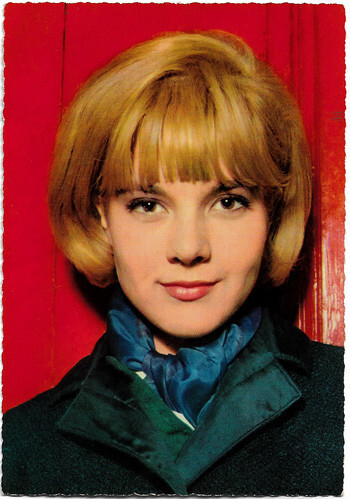
West-German postcard by Krüger, no. 902/267 Photo: Neuvecelle.
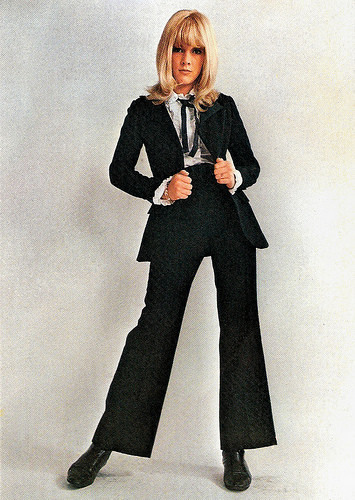
French postcard by E.D.U.G., no. 482. Photo: Jean Marie Perier.
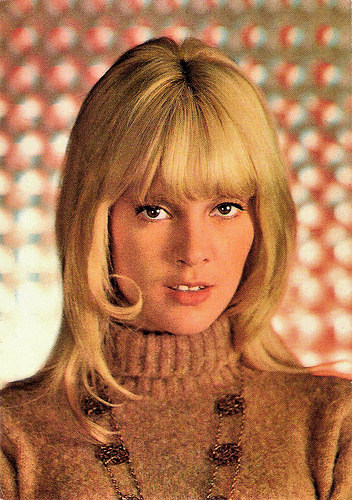
French postcard by E.D.U.G., no. 507. Photo: Sam Lévin.
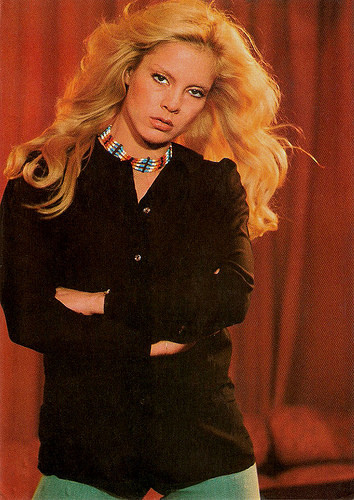
French postcard by Editions Lyna, Paris, no. 2051. Photo: Raymond Depardon / Gamma.
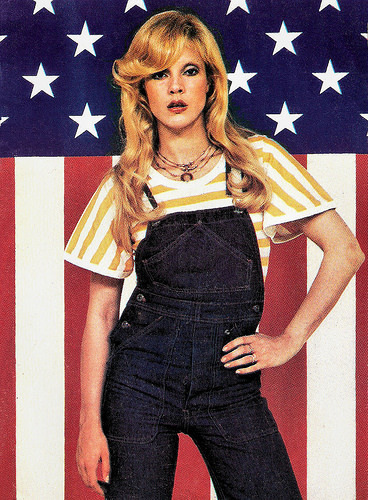
French promotion card by RCA.
The Twisting Schoolgirl
Sylvie Vartan was born in Iskretz near Sofia, Bulgaria. Her father, Georges Vartanian was a Bulgarian of Armenian descent. He worked as an attache at the French embassy in Sofia. Her mother, Illona Vartanian, was Hungarian.
In September 1944, when the Soviet Army occupied Bulgaria, the Vartan family house was nationalised and they moved to Sofia. A friend of father Georges offered Sylvie a role of a schoolgirl in his film Pod igoto/Under the Yoke (Dako Dakovski, 1952). The film was about Bulgarian rebels against the Turkish occupation. Being a part of the film had a lasting impression on her and made her dream of becoming an entertainer.
The family emigrated to Paris in December 1952. By the example of her brother, professional trumpeter and later artistic director at RCA records Eddie Vartan, teenage Sylvie's main interest was music. In 1961 Eddie offered Sylvie to record the song 'Panne d'essence' (Out of gas) with the French rocker Frankie Jordan. It was a surprise hit and provided her first appearance on French TV.
Journalists gave her the nickname "La lycéenne du twist". After "the Twisting Schoolgirl" had finished the Lycée Victor Hugo (Victor Hugo School), she signed a solo recording contract with RCA. Her first single 'Quand le film est triste', covering Sue Thompson's 'Sad movies' was a hit in December 1961.
Soon followed more hits like her version of 'The Loco-Motion' and 'Tous mes copains'. Six of her thirty-one songs released in 1962 became top 20 hits in Europe. A small part as a singer in Un clair de lune à Maubeuge/Moonlight in Maubeuge (Jean Chérasse, 1962) starring Claude Brasseur was her first film appearance as an adult.
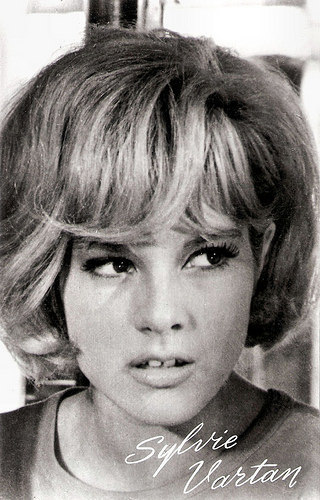
Dutch postcard by Muziek Parade, Hilversum, no. AX 5643.
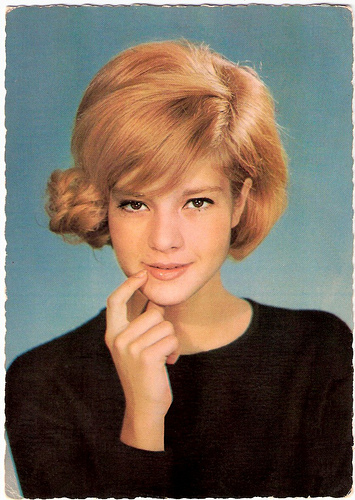
French postcard by E.D.U.G. Publicity card for RCA Victor. Photo: Sam Lévin.
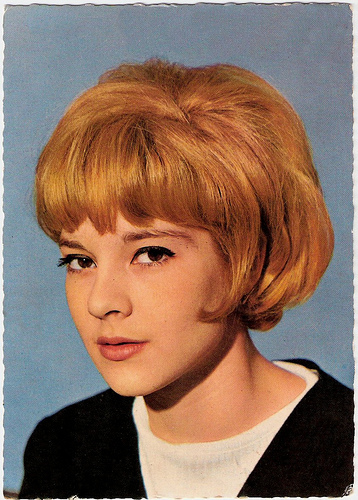
French postcard by Publistar, Marseille, no. 818. Photo: Spitzer.
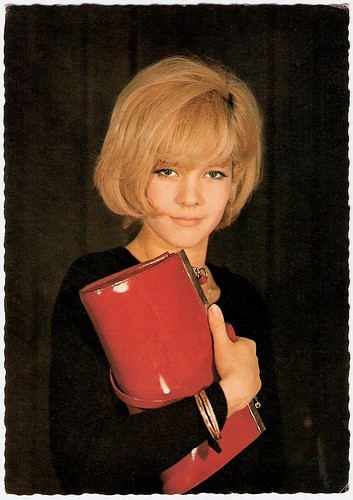
French postcard by Publistar, Marseille, no. 939. Photo: Patrick Bertrand.
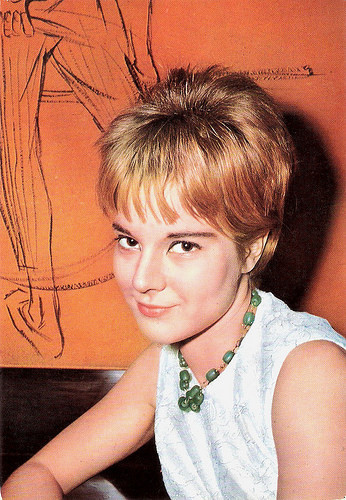
French postcard by Editions P.I., Paris, no. 1092. Photo: Anders.
Short Skirts, Barbarella Boots and the Beatles
In 1962 Sylvie Vartan met Jean-Philippe Smet, better known as Johnny Hallyday , during her second concert in the Olympia. In 1963, after announcing their engagement over the radio, the young couple performed to a noisy audience of 200,000 at La Nation square of Paris.
Sylvie and Johnny appeared together in the film D'où viens-tu, Johnny?/Where Are You From, Johnny? (Noël Howard, 1963). And that year she was voted top French singer in the first pole on the TV programme Salut les copains. The next year, she played a supporting role in the film Patate/Friend of the Family (Robert Thomas, 1964) opposite ; Jean Marais and Danielle Darrieux . Being accompanied by the film Cherchez l’idole/The Chase (Michel Boisrond, 1964) with Dany Saval , her song 'La plus belle pour aller danser' sold over a million copies in Japan.
In 1964 Sylvie shared the bill with the Beatles and Trini Lopez at the Olympia.
EFSP co-editor and Vartan fan Marlene Pilaete: "Bruno Coquatrix, Olympia’s owner, had decided to produce a show for teenagers. He chose the Beatles , Sylvie Vartan, and Trini Lopez to be the stars of his show. The show took place from the 16th of January to the 4th of February 1964, twice a day. In Coquatrix’s mind, the three stars were of equal importance and their billing on the programs and on Olympia’s marquee was identical. The same character size was used for the three. No name was in bigger letters than the others.
In the beginning, the order of appearance was this: first the Beatles , then Sylvie Vartan, then Trini Lopez. During the first performances, the Beatles were not badly received but their welcome was not as tremendous as it was in Great Britain. It was different from what they had experienced in their native country: there were no hysterical female fans shouting and crying.
But, as days went by, their success became more and more resounding. Coquatrix understood that the Beatles fans were not too happy to see their band sing a few songs and then be replaced by Sylvie Vartan. For Vartan, who was not yet twenty at the time, it was not easy to handle angry Beatles fans. So, Coquatrix decided to change the order of appearance after a few days: it became first Trini Lopez, then Sylvie Vartan, then the Beatles . But there was no change regarding the billing. The three names still appeared in the same size."
Sylvie made numerous US TV appearances and an international concert tour, including Canada, South America, and Japan. In 1965 Sylvie and Johnny were married in Loconville. They had a son David Michael Benjamin, known now as singer David Hallyday. In 1968 Sylvie suffered a traffic accident but was back on tour in August.
No longer a shy young yé-yé girl but a sexy dancer, more into cabaret than rock & roll. She appeared often on French and Italian TV, dressed in short skirts and Barbarella boots. In Italy, she had huge hits with 'Zum zum zum' in 1968 and 'Irrestibilmente' in 1969. She continued with intensive performing and recording.
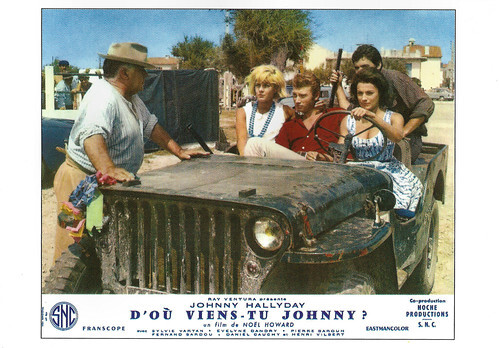
French postcard by Encyclopédie du Cinéma, no. EDC 552 Vis. 6. Photo: Johnny Hallyday and Sylvie Vartan in D'où viens-tu... Johnny?/Where Are You From, Johnny? (Noël Howard, 1963).
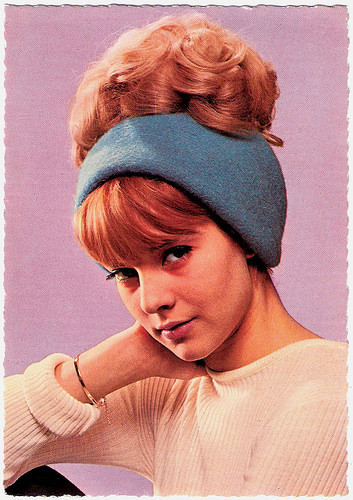
French postcard by E.D.U.G., no. 329. Photo: Sam Lévin / RCA Victor.
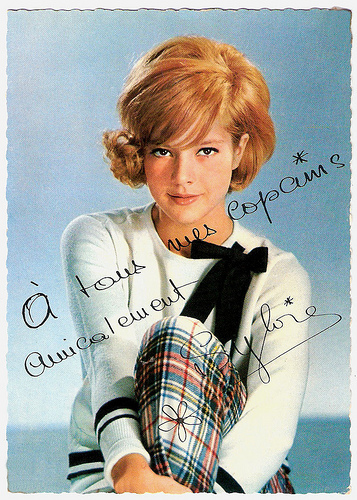
French postcard by E.D.U.G., no. 276. Offered by André. Photo: Sam Lévin.
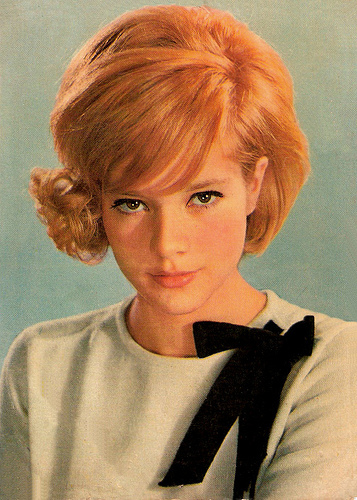
French postcard by E.D.U.G., no. 329. Photo: Sam Lévin / RCA Victor.
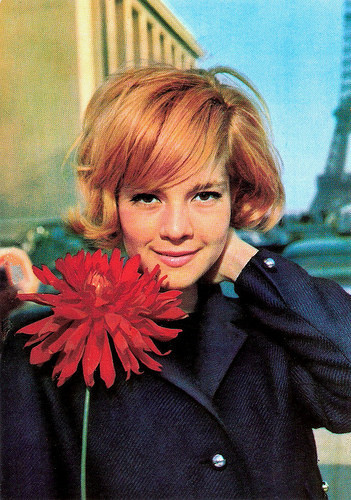
French postcard by Editions P.I., Paris, no. 1116. Photo: Kasparian.
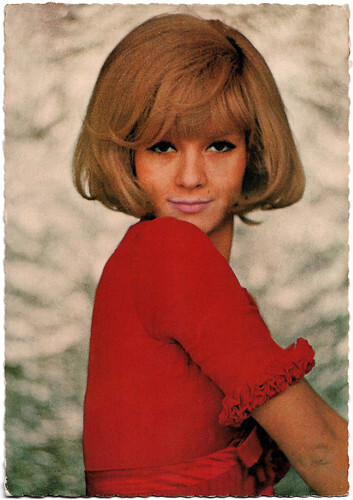
French postcard by PSG, no. 453 Photo: Philippe d'Argence / RCA Victor.
Going Disco
Sylvie Vartan returned on the screen opposite Mathieu Carrière and Orson Welles in the cult film Malpertuis/The Legend of Doom House (1971, Harry Kümel). She also appeared in two documentaries by Francois Reichenbach, J’ai tout donné/I’ve given everything (1971) and Mon Amie Sylvie/My Friend Sylvie (1972).
Musically, she had a hit in 1976 with the John Kongos' cover 'Qu'est-ce qui fait pleurer les blondes?', topping the French charts for several weeks. She went disco with a single called 'Disco Queen' in 1978. Marlene Pilaete: "I’ve bought that single at the time and I still have it. But, contrary to her colleague Sheila, Vartan never really warmed to disco and her next two singles, 'Solitude' and 'Fantaisie', were not disco. She came back to disco once with 'I don’t want the night to end' in 1979 and then completely gave up that style of music. She never really had her disco era."
In 1980, after several widely publicised disagreements, Sylvie and Johnny finally divorced. After releasing 'Love again' in duet with John Denver, a #85 single on Billboard Hot 100 in 1984, Vartan took a break in show business. In 1990 she gave a concert at the Palace of Culture of Sofia, opening and closing with a Bulgarian song. This was her first visit to the city after her emigration.
After her brother Eddie from a brain haemorrhage in 2001, she took another break in performing public. In the fall of 2004, she started recording and giving concerts of jazz ballads in French-speaking countries and Japan. Her last film appearances were in L’ange noir/The Black Angel (Jean-Claude Brisseau, 1994) with Michel Piccoli and Tchéky Karyo, and opposite Francis Huster in the TV film Mausolée pour une garce/Mausoleum for a Bitch (Arnaud Sélignac, 2001), adapted from a best-selling novel by Frédéric Dard.
Vartan celebrated her 60th birthday in style in 2004, publishing her autobiography, 'Entre ombre et lumière' (Between Shadow and Light), and releasing a brand new album, simply entitled 'Sylvie'. In the following years, several new albums and tours followed. In 2014 she returned to the screen in the French romantic comedy Tu veux ou tu veux pas/Sex, Love & Therapy (Tonie Marshall, 2014) starring Sophie Marceau and Patrick Bruel .
Since 1984, Sylvie Vartan is married to Italian-American producer Tony Scotti. They have adopted a young Bulgarian girl, Darina. Sylvie Vartan is an aunt to Eddie Vartan's son, actor Michael Vartan.

French postcard by E.D.U.G., no. 499 Photo: Jean-Marie Perier / RCA.
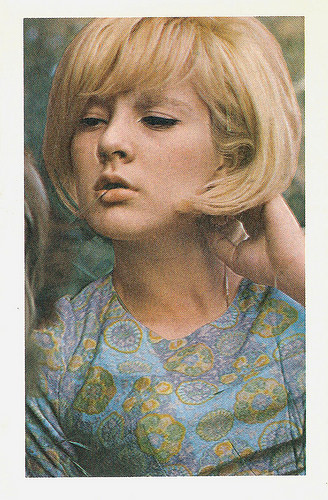
Vintage postcard.
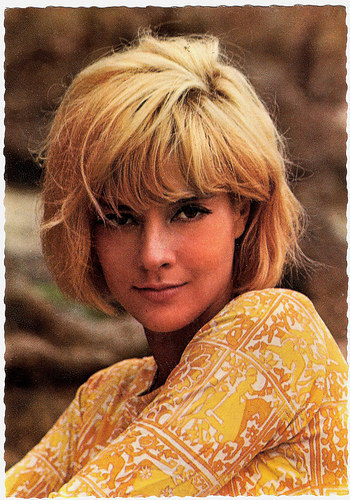
French postcard by E.D.U.G., no. 382. Photo: Philippe D'Argence.
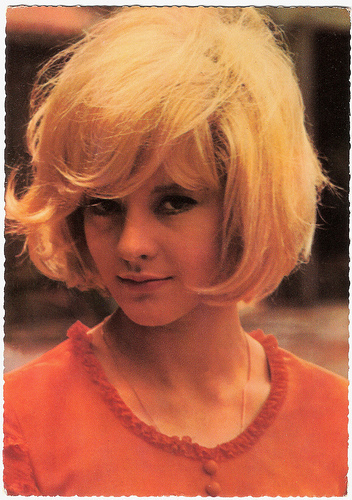
French postcard by PSG, no. 1034. Photo: Laurent Camil / RCA Victor.
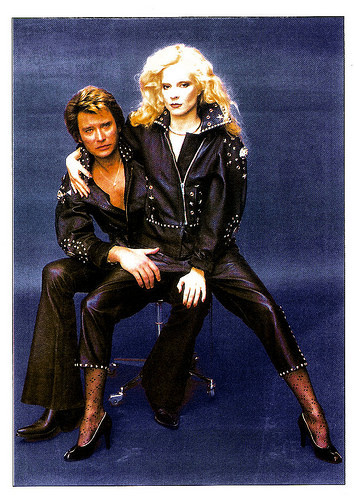
With Johnny Hallyday . French postcard by Carterie Artistique et Cinématographique, Pont du Casse, no. ST JH 13.
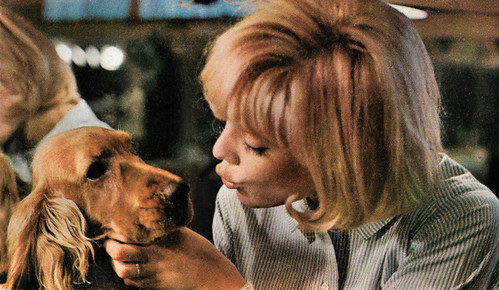
French postcard by PSG, offered by Corvisart, no. 1194 A. Photo: R. Kasparian / RCA.
Scopitone clip of Sylvie Vartan singing 'Est ce Que Tu Le Sais'. Source: Cheryl Lynn (YouTube).
Sylvie Vartan sings 'La plus belle pour aller danser' in Cherchez l'Idole (1964). Source: win081 (YouTube).
Trailer Malpertuis (1973). Source: Wim Baelus (YouTube).
Sylvie Vartan sings 'Déprime' in Cadence 3 (1983). Source: The Catrate (YouTube).
Sources: RFI Musique (French), Wikipedia, and .

West-German postcard by Krüger, no. 902/267 Photo: Neuvecelle.

French postcard by E.D.U.G., no. 482. Photo: Jean Marie Perier.

French postcard by E.D.U.G., no. 507. Photo: Sam Lévin.

French postcard by Editions Lyna, Paris, no. 2051. Photo: Raymond Depardon / Gamma.

French promotion card by RCA.
The Twisting Schoolgirl
Sylvie Vartan was born in Iskretz near Sofia, Bulgaria. Her father, Georges Vartanian was a Bulgarian of Armenian descent. He worked as an attache at the French embassy in Sofia. Her mother, Illona Vartanian, was Hungarian.
In September 1944, when the Soviet Army occupied Bulgaria, the Vartan family house was nationalised and they moved to Sofia. A friend of father Georges offered Sylvie a role of a schoolgirl in his film Pod igoto/Under the Yoke (Dako Dakovski, 1952). The film was about Bulgarian rebels against the Turkish occupation. Being a part of the film had a lasting impression on her and made her dream of becoming an entertainer.
The family emigrated to Paris in December 1952. By the example of her brother, professional trumpeter and later artistic director at RCA records Eddie Vartan, teenage Sylvie's main interest was music. In 1961 Eddie offered Sylvie to record the song 'Panne d'essence' (Out of gas) with the French rocker Frankie Jordan. It was a surprise hit and provided her first appearance on French TV.
Journalists gave her the nickname "La lycéenne du twist". After "the Twisting Schoolgirl" had finished the Lycée Victor Hugo (Victor Hugo School), she signed a solo recording contract with RCA. Her first single 'Quand le film est triste', covering Sue Thompson's 'Sad movies' was a hit in December 1961.
Soon followed more hits like her version of 'The Loco-Motion' and 'Tous mes copains'. Six of her thirty-one songs released in 1962 became top 20 hits in Europe. A small part as a singer in Un clair de lune à Maubeuge/Moonlight in Maubeuge (Jean Chérasse, 1962) starring Claude Brasseur was her first film appearance as an adult.

Dutch postcard by Muziek Parade, Hilversum, no. AX 5643.

French postcard by E.D.U.G. Publicity card for RCA Victor. Photo: Sam Lévin.

French postcard by Publistar, Marseille, no. 818. Photo: Spitzer.

French postcard by Publistar, Marseille, no. 939. Photo: Patrick Bertrand.

French postcard by Editions P.I., Paris, no. 1092. Photo: Anders.
Short Skirts, Barbarella Boots and the Beatles
In 1962 Sylvie Vartan met Jean-Philippe Smet, better known as Johnny Hallyday , during her second concert in the Olympia. In 1963, after announcing their engagement over the radio, the young couple performed to a noisy audience of 200,000 at La Nation square of Paris.
Sylvie and Johnny appeared together in the film D'où viens-tu, Johnny?/Where Are You From, Johnny? (Noël Howard, 1963). And that year she was voted top French singer in the first pole on the TV programme Salut les copains. The next year, she played a supporting role in the film Patate/Friend of the Family (Robert Thomas, 1964) opposite ; Jean Marais and Danielle Darrieux . Being accompanied by the film Cherchez l’idole/The Chase (Michel Boisrond, 1964) with Dany Saval , her song 'La plus belle pour aller danser' sold over a million copies in Japan.
In 1964 Sylvie shared the bill with the Beatles and Trini Lopez at the Olympia.
EFSP co-editor and Vartan fan Marlene Pilaete: "Bruno Coquatrix, Olympia’s owner, had decided to produce a show for teenagers. He chose the Beatles , Sylvie Vartan, and Trini Lopez to be the stars of his show. The show took place from the 16th of January to the 4th of February 1964, twice a day. In Coquatrix’s mind, the three stars were of equal importance and their billing on the programs and on Olympia’s marquee was identical. The same character size was used for the three. No name was in bigger letters than the others.
In the beginning, the order of appearance was this: first the Beatles , then Sylvie Vartan, then Trini Lopez. During the first performances, the Beatles were not badly received but their welcome was not as tremendous as it was in Great Britain. It was different from what they had experienced in their native country: there were no hysterical female fans shouting and crying.
But, as days went by, their success became more and more resounding. Coquatrix understood that the Beatles fans were not too happy to see their band sing a few songs and then be replaced by Sylvie Vartan. For Vartan, who was not yet twenty at the time, it was not easy to handle angry Beatles fans. So, Coquatrix decided to change the order of appearance after a few days: it became first Trini Lopez, then Sylvie Vartan, then the Beatles . But there was no change regarding the billing. The three names still appeared in the same size."
Sylvie made numerous US TV appearances and an international concert tour, including Canada, South America, and Japan. In 1965 Sylvie and Johnny were married in Loconville. They had a son David Michael Benjamin, known now as singer David Hallyday. In 1968 Sylvie suffered a traffic accident but was back on tour in August.
No longer a shy young yé-yé girl but a sexy dancer, more into cabaret than rock & roll. She appeared often on French and Italian TV, dressed in short skirts and Barbarella boots. In Italy, she had huge hits with 'Zum zum zum' in 1968 and 'Irrestibilmente' in 1969. She continued with intensive performing and recording.

French postcard by Encyclopédie du Cinéma, no. EDC 552 Vis. 6. Photo: Johnny Hallyday and Sylvie Vartan in D'où viens-tu... Johnny?/Where Are You From, Johnny? (Noël Howard, 1963).

French postcard by E.D.U.G., no. 329. Photo: Sam Lévin / RCA Victor.

French postcard by E.D.U.G., no. 276. Offered by André. Photo: Sam Lévin.

French postcard by E.D.U.G., no. 329. Photo: Sam Lévin / RCA Victor.

French postcard by Editions P.I., Paris, no. 1116. Photo: Kasparian.

French postcard by PSG, no. 453 Photo: Philippe d'Argence / RCA Victor.
Going Disco
Sylvie Vartan returned on the screen opposite Mathieu Carrière and Orson Welles in the cult film Malpertuis/The Legend of Doom House (1971, Harry Kümel). She also appeared in two documentaries by Francois Reichenbach, J’ai tout donné/I’ve given everything (1971) and Mon Amie Sylvie/My Friend Sylvie (1972).
Musically, she had a hit in 1976 with the John Kongos' cover 'Qu'est-ce qui fait pleurer les blondes?', topping the French charts for several weeks. She went disco with a single called 'Disco Queen' in 1978. Marlene Pilaete: "I’ve bought that single at the time and I still have it. But, contrary to her colleague Sheila, Vartan never really warmed to disco and her next two singles, 'Solitude' and 'Fantaisie', were not disco. She came back to disco once with 'I don’t want the night to end' in 1979 and then completely gave up that style of music. She never really had her disco era."
In 1980, after several widely publicised disagreements, Sylvie and Johnny finally divorced. After releasing 'Love again' in duet with John Denver, a #85 single on Billboard Hot 100 in 1984, Vartan took a break in show business. In 1990 she gave a concert at the Palace of Culture of Sofia, opening and closing with a Bulgarian song. This was her first visit to the city after her emigration.
After her brother Eddie from a brain haemorrhage in 2001, she took another break in performing public. In the fall of 2004, she started recording and giving concerts of jazz ballads in French-speaking countries and Japan. Her last film appearances were in L’ange noir/The Black Angel (Jean-Claude Brisseau, 1994) with Michel Piccoli and Tchéky Karyo, and opposite Francis Huster in the TV film Mausolée pour une garce/Mausoleum for a Bitch (Arnaud Sélignac, 2001), adapted from a best-selling novel by Frédéric Dard.
Vartan celebrated her 60th birthday in style in 2004, publishing her autobiography, 'Entre ombre et lumière' (Between Shadow and Light), and releasing a brand new album, simply entitled 'Sylvie'. In the following years, several new albums and tours followed. In 2014 she returned to the screen in the French romantic comedy Tu veux ou tu veux pas/Sex, Love & Therapy (Tonie Marshall, 2014) starring Sophie Marceau and Patrick Bruel .
Since 1984, Sylvie Vartan is married to Italian-American producer Tony Scotti. They have adopted a young Bulgarian girl, Darina. Sylvie Vartan is an aunt to Eddie Vartan's son, actor Michael Vartan.

French postcard by E.D.U.G., no. 499 Photo: Jean-Marie Perier / RCA.

Vintage postcard.

French postcard by E.D.U.G., no. 382. Photo: Philippe D'Argence.

French postcard by PSG, no. 1034. Photo: Laurent Camil / RCA Victor.

With Johnny Hallyday . French postcard by Carterie Artistique et Cinématographique, Pont du Casse, no. ST JH 13.

French postcard by PSG, offered by Corvisart, no. 1194 A. Photo: R. Kasparian / RCA.
Scopitone clip of Sylvie Vartan singing 'Est ce Que Tu Le Sais'. Source: Cheryl Lynn (YouTube).
Sylvie Vartan sings 'La plus belle pour aller danser' in Cherchez l'Idole (1964). Source: win081 (YouTube).
Trailer Malpertuis (1973). Source: Wim Baelus (YouTube).
Sylvie Vartan sings 'Déprime' in Cadence 3 (1983). Source: The Catrate (YouTube).
Sources: RFI Musique (French), Wikipedia, and .
Published on March 13, 2022 23:00
March 12, 2022
Jackie Coogan's 1924 European Tour
American actor Jackie Coogan (1914-1984) began as a child actor in silent films. He was Charlie Chaplin's irascible sidekick in The Kid (Charles Chaplin, 1921) and played the title role in Oliver Twist (Frank Lloyd, 1922). In 1924, the popular child star made a charity tour through Europe of which remarkably many postcards were published.
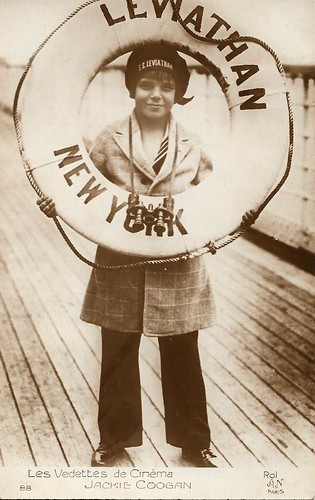
Jackie Coogan, on board of SS Leviathan in 1924. French postcard by A.N. in the Les Vedettes de Cinéma series, Paris, no. 88. Photo: Rol. On 4 November 1924, Jackie went back to the US on the SS Leviathan, after his European tour of September-October that year, visiting London, Paris, Rome, Athens, Budapest, Vienna, and Berlin. He had come with the same boat, wearing a cap from the boat during his tour.
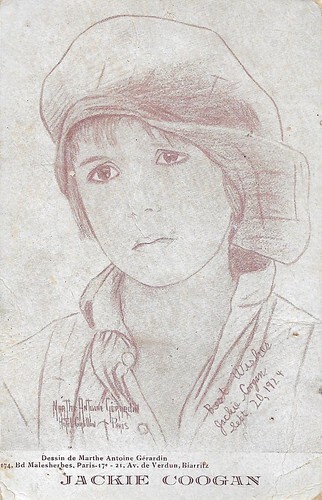
French postcard. Drawing of Jackie Coogan by Marthe Antoine Girardin, Paris. The inscription "Best wishes, Jackie Coogan, Sept. 20, 1924" refers to Coogan's European tour of that year. The cap worn sideways probably refers to Coogan's film Daddy (E. Mason Hopper, 1923).
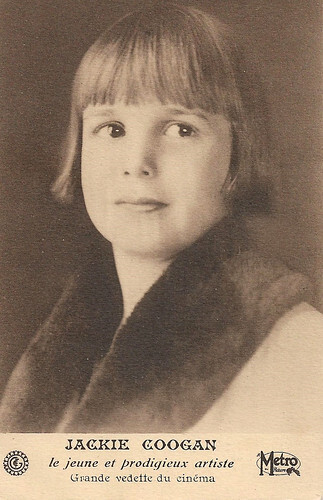
French postcard. Photo: Metro Pictures / Gaumont. The card refers to Coogan's visit to Geneva, during his 1924 European tour, and promotes his film Long Live the King (Victor Schertzinger, 1923) at the Colysée cinema. October 1924 Coogan celebrated his 10th birthday at Hotel Beau Rivage in Geneva.
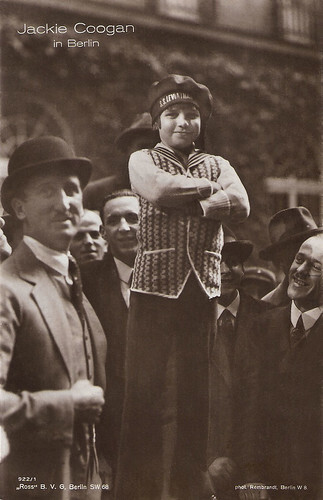
German postcard by Ross Verlag, Berlin, 922/1. Photo: Rembrandt, Berlin. The photo was taken in Berlin during Coogan's European tour in 1924. The man at the left is Coogan's father, John Henry Coogan Jr.
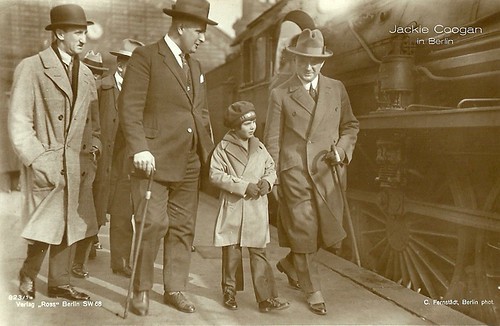
Jackie Coogan in Berlin. The man at the far left is Coogan's father. German postcard by Ross Verlag, Berlin, no. 923/1. Photo: C. Fernstädt, Berlin.
Using his status for a humanitarian cause
According to Wikipedia, Jackie Coogan toured across the United States and Europe in 1924 on a "Children's Crusade", working with Near East Relief (NER). The tour was part of his fundraising drive, which provided more than $1 million in clothing, food, and other contributions (worth more than $13 million in 2012 dollars), funds raised for Armenian and Greek Genocide Orphans.
In addition, the tour promoted Coogan's film A Boy of Flanders (Victor Schertzinger, 1924), which, oddly enough, takes place in the Netherlands and not in Belgium of which Flanders is a part. Coogan was also dressed up in a typical Volendamer (Dutch) folkloristic outfit. In The Netherlands, the film was therefore rebaptised 'Een Hollandsche jongen' (A Dutch Boy).
According to the newspapers, September 1924 Coogan docked in Southampton with the SS Leviathan and then visited London, Paris, Rome, and Athens. Coogan was accompanied by his father Jack, his tutor Mrs. Kora Newell, and his manager and future stepfather, Arthur Bernstein. His mother stayed home, as she was expecting her second son. After ten days of holidays early October in Semmering (Austria), the trip continued to Budapest, Vienna, and Berlin. Attempts to have him visit Amsterdam as well failed.
After a return to Paris, he took the ship back to the US on 4 November, as he had to work on the film sets again. Huge crowds attended Coogan's visits, reaching its climax in October 1924 in Athens, according to his biographer Diana Serra Cary, when he handed over the bills of lading for the relief cargo in presence of Greek and American dignitaries and some 7000 orphans in the care of Near East Relief. Coogan was awarded with the Silver Cross of the Order of St. George. Way before TV or internet, the media coverage of the tour in printed press, film magazines and newsreels was huge. The Ross Verlag postcards on Coogan's Berlin visit are clearly part of this.
Coogan was honored by officials in the United States, Greece, and Rome, where he had an audience with Pope Pius XI. He also had a 15-minute meeting with Benito Mussolini, who gave him an autographed photo inscribed "Al Piccolo Grande" (To the Little Great One). There were demonstrations against his visit to Vienna in October 1924 because some people on the far right believed he was Jewish. He was in fact of Irish Catholic descent.
Coogan may well have been the first star using his status for a humanitarian cause. After a return to Paris, Jackie Coogan and his father took the ship back to the US on 4 November, as he had to work from 28 October on the film sets again.
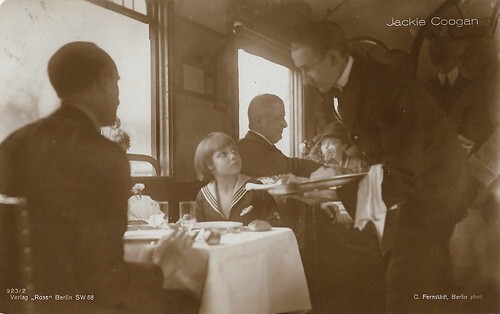
Jackie Coogan and his father travelling to Berlin. German postcard by Ross Verlag, Berlin, no. 923/2. Photo: C. Fernstädt, Berlin.
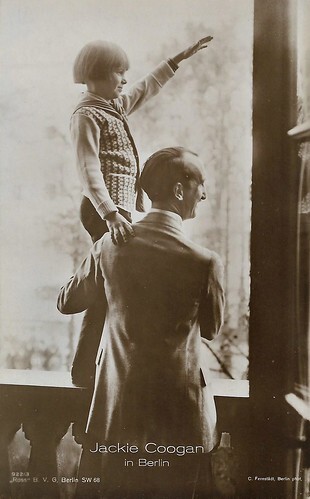
Held by his father, Jackie Coogan waves to his fans from the balcony of the Hotel Adlon in Berlin, October 1924. German postcard by Ross Verlag, Berlin, no. 923/3. Photo: C. Fernstädt, Berlin.
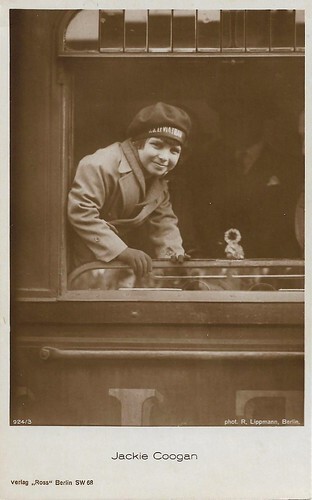
Part of the 1924 charity tour of Jackie Coogan through Europe. German postcard by Ross Verlag, Berlin, no. 924/3. Photo: C. Fernstädt, Berlin.
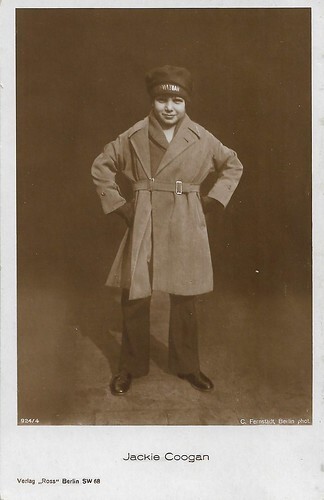
Part of the 1924 charity tour of Jackie Coogan through Europe. Mark the cap from the ocean liner Leviathan with which he traveled to and from Europe. German postcard by Ross Verlag, Berlin, no. 924/4. Photo: C. Fernstädt, Berlin.
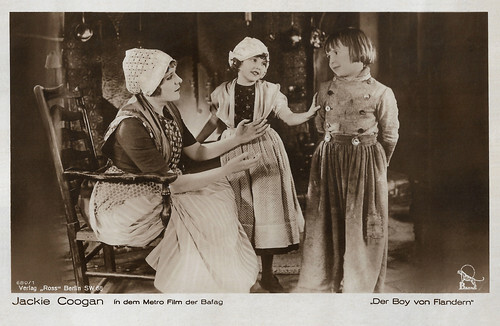
German postcard by Ross Verlag, no. 680/1, 1919-1924. Photo: Bafag / MGM. Jackie Coogan in A Boy of Flanders (Victor Schertzinger, 1924), based on the novel by Ouida. The girl is Jeanne "Jean" Carpenter, who plays Alios Cogez, while the woman may be Nell Craig, who plays her mother, Marie Cogez.
Sources: : Pinkylovejoy, Diana Serra Cary (Jackie Coogan: The World's Boy King: A Biography of Hollywood's Legendary Child Star), Wikipedia and .

Jackie Coogan, on board of SS Leviathan in 1924. French postcard by A.N. in the Les Vedettes de Cinéma series, Paris, no. 88. Photo: Rol. On 4 November 1924, Jackie went back to the US on the SS Leviathan, after his European tour of September-October that year, visiting London, Paris, Rome, Athens, Budapest, Vienna, and Berlin. He had come with the same boat, wearing a cap from the boat during his tour.

French postcard. Drawing of Jackie Coogan by Marthe Antoine Girardin, Paris. The inscription "Best wishes, Jackie Coogan, Sept. 20, 1924" refers to Coogan's European tour of that year. The cap worn sideways probably refers to Coogan's film Daddy (E. Mason Hopper, 1923).

French postcard. Photo: Metro Pictures / Gaumont. The card refers to Coogan's visit to Geneva, during his 1924 European tour, and promotes his film Long Live the King (Victor Schertzinger, 1923) at the Colysée cinema. October 1924 Coogan celebrated his 10th birthday at Hotel Beau Rivage in Geneva.

German postcard by Ross Verlag, Berlin, 922/1. Photo: Rembrandt, Berlin. The photo was taken in Berlin during Coogan's European tour in 1924. The man at the left is Coogan's father, John Henry Coogan Jr.

Jackie Coogan in Berlin. The man at the far left is Coogan's father. German postcard by Ross Verlag, Berlin, no. 923/1. Photo: C. Fernstädt, Berlin.
Using his status for a humanitarian cause
According to Wikipedia, Jackie Coogan toured across the United States and Europe in 1924 on a "Children's Crusade", working with Near East Relief (NER). The tour was part of his fundraising drive, which provided more than $1 million in clothing, food, and other contributions (worth more than $13 million in 2012 dollars), funds raised for Armenian and Greek Genocide Orphans.
In addition, the tour promoted Coogan's film A Boy of Flanders (Victor Schertzinger, 1924), which, oddly enough, takes place in the Netherlands and not in Belgium of which Flanders is a part. Coogan was also dressed up in a typical Volendamer (Dutch) folkloristic outfit. In The Netherlands, the film was therefore rebaptised 'Een Hollandsche jongen' (A Dutch Boy).
According to the newspapers, September 1924 Coogan docked in Southampton with the SS Leviathan and then visited London, Paris, Rome, and Athens. Coogan was accompanied by his father Jack, his tutor Mrs. Kora Newell, and his manager and future stepfather, Arthur Bernstein. His mother stayed home, as she was expecting her second son. After ten days of holidays early October in Semmering (Austria), the trip continued to Budapest, Vienna, and Berlin. Attempts to have him visit Amsterdam as well failed.
After a return to Paris, he took the ship back to the US on 4 November, as he had to work on the film sets again. Huge crowds attended Coogan's visits, reaching its climax in October 1924 in Athens, according to his biographer Diana Serra Cary, when he handed over the bills of lading for the relief cargo in presence of Greek and American dignitaries and some 7000 orphans in the care of Near East Relief. Coogan was awarded with the Silver Cross of the Order of St. George. Way before TV or internet, the media coverage of the tour in printed press, film magazines and newsreels was huge. The Ross Verlag postcards on Coogan's Berlin visit are clearly part of this.
Coogan was honored by officials in the United States, Greece, and Rome, where he had an audience with Pope Pius XI. He also had a 15-minute meeting with Benito Mussolini, who gave him an autographed photo inscribed "Al Piccolo Grande" (To the Little Great One). There were demonstrations against his visit to Vienna in October 1924 because some people on the far right believed he was Jewish. He was in fact of Irish Catholic descent.
Coogan may well have been the first star using his status for a humanitarian cause. After a return to Paris, Jackie Coogan and his father took the ship back to the US on 4 November, as he had to work from 28 October on the film sets again.

Jackie Coogan and his father travelling to Berlin. German postcard by Ross Verlag, Berlin, no. 923/2. Photo: C. Fernstädt, Berlin.

Held by his father, Jackie Coogan waves to his fans from the balcony of the Hotel Adlon in Berlin, October 1924. German postcard by Ross Verlag, Berlin, no. 923/3. Photo: C. Fernstädt, Berlin.

Part of the 1924 charity tour of Jackie Coogan through Europe. German postcard by Ross Verlag, Berlin, no. 924/3. Photo: C. Fernstädt, Berlin.

Part of the 1924 charity tour of Jackie Coogan through Europe. Mark the cap from the ocean liner Leviathan with which he traveled to and from Europe. German postcard by Ross Verlag, Berlin, no. 924/4. Photo: C. Fernstädt, Berlin.

German postcard by Ross Verlag, no. 680/1, 1919-1924. Photo: Bafag / MGM. Jackie Coogan in A Boy of Flanders (Victor Schertzinger, 1924), based on the novel by Ouida. The girl is Jeanne "Jean" Carpenter, who plays Alios Cogez, while the woman may be Nell Craig, who plays her mother, Marie Cogez.
Sources: : Pinkylovejoy, Diana Serra Cary (Jackie Coogan: The World's Boy King: A Biography of Hollywood's Legendary Child Star), Wikipedia and .
Published on March 12, 2022 22:00
March 11, 2022
La Collectionneuse: Mirror, Mirror, Part 2
The use of mirrors has become established in films. It developed as a device in the European silent cinema in the 1910s to distinguish the new medium from theatre and to connect film more with painting. Mirrors are often used for visual dialogues between off-screen and on-screen characters and for creating excitement and voyeurism in films. Last week, Ivo Blom selected postcards in which the mirror is an important and intriguing device in the picture. Today, Marlene Pilaete presents her interesting selection of 15 actresses and mirrors. Marlene: ""Here is a selection of my own “mirror” film star cards. I hope you’ll enjoy them."
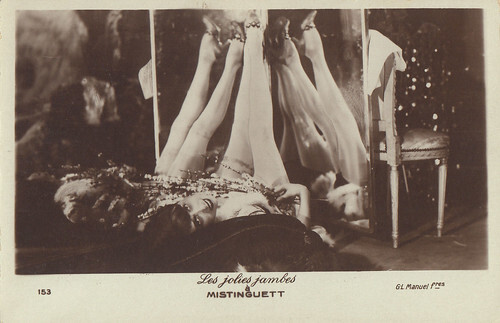
French postcard, no. 153. Photo: G.L. Manuel Frères. Caption: “Les jolies jambes de Mistinguett ” (“Mistinguett’s pretty legs”).
French actress and singer Mistinguett (1875-1956) captivated Paris with her risqué routines. She went on to become the most popular French entertainer of her time and the highest-paid female entertainer in the world. She appeared more than 60 times in the cinema.
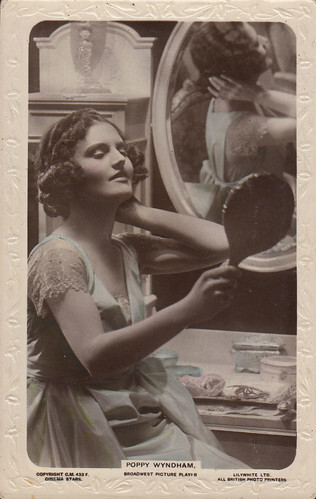
British postcard by Lilywhite Ltd., no. C.M. 433 F.
Poppy Wyndham (1893-1928) starred in several British pictures in 1919 and 1920. She then turned to interior design before developing a passion for flying. An aviation pioneer, she died while trying to cross the Atlantic by plane in 1928.
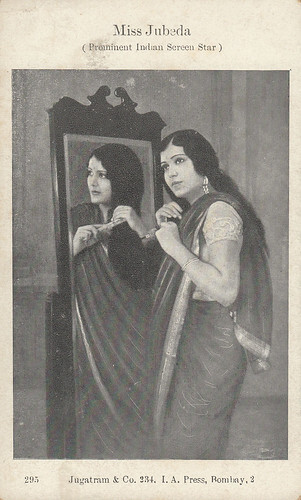
Indian postcard by Jugatram & Co., Bombay, no. 295. Caption: Miss Jubeda, prominent Indian screen star.
Zubeida (1911-1988) was a major Indian film star from 1924 to the mid-1930s. She notably was the heroine of Alam Ara/The Light of the World (Ardeshir Irani, 1931), the first Indian talkie.
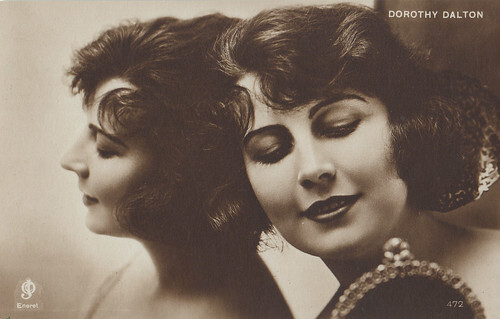
Danish postcard by J. Chr. Olsens Kunstforlag, Eneret, no. 472.
Dorothy Dalton was an American actress of the silent screen, at Kay-Bee, Thomas Ince Corp, and Famous Players/ Paramount. In the early 1920s she was a huge film star.
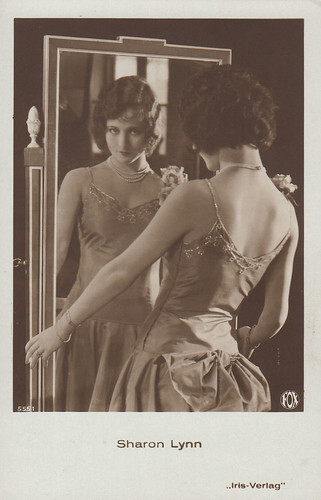
Austrian postcard by Iris Verlag, no. 5551. Photo: Fox.
Brunette, petite American actress Sharon Lynn (1901-1963) was featured in several Fox movies from 1928 to 1930, including musicals such as Fox Movietone Follies of 1929 (1929), Happy Days (1929) and Let’s Go Places (1930). However, her most famous role is certainly the evil saloon singer Lola Marcel in Way Out West (1937) with Laurel and Hardy.
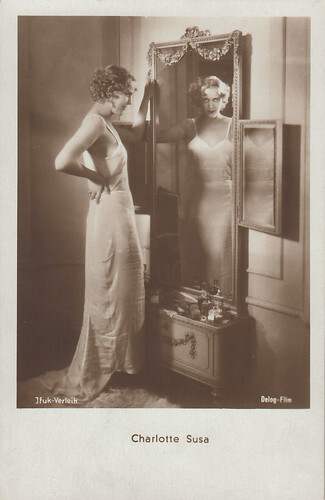
Austrian postcard by Iris Verlag, no. 5999. Photo: Ifuk Verleih / Delog Film.
Blond, German actress Charlotte Susa (1898-1967), was a major operetta star of the German-speaking world, and also a popular femme fatale of the German silent and early sound film.
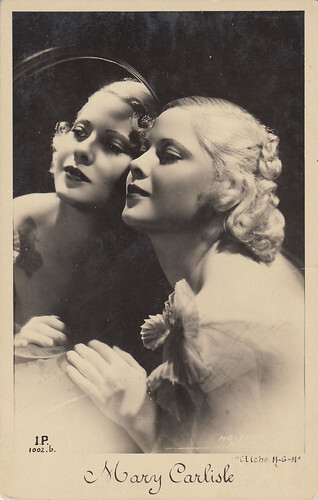
Postcard by I.P., no. 1002b. Photo: MGM.
Mary Carlisle (1914-2018) was one of the 1930’s cutest Hollywood blondes. She was featured in about 40 movies from 1933 to 1939. She was Bing Crosby’s co-star in College Humor (1933), Double or Nothing (1937) and Doctor Rhythm (1938).
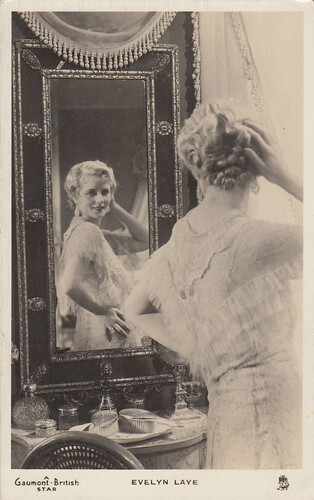
British postcard by Raphael Tuck & Sons, no. 10. Photo: Gaumont-British.
Evelyn Laye (1900–1996) was one of England's most popular stars of musical revue and operetta during the 1920s. She did a few screen appearances in both London and Hollywood, including in the classic musical Evensong (1934).
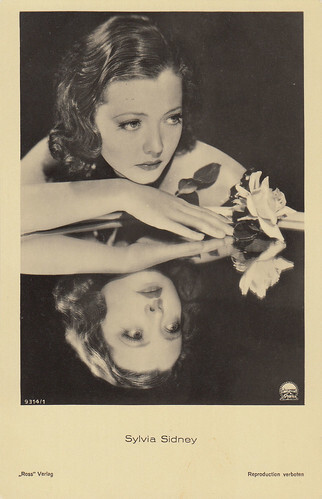
German postcard by Ross Verlag, no. 9314/1, 1935-1936. Photo: Paramount.
Sylvia Sidney (1910-1999) was an American stage, screen, and film actress whose career spanned over 70 years. She rose to prominence in dozens of leading roles in the 1930s, such as An American Tragedy (1931), City Streets (1931), Alfred Hitchcock's Sabotage (1936), and Fritz Lang's Fury (1936) and You Only Live Once (1937). She later gained attention for her role as Juno, a caseworker in the afterlife, in Tim Burton's film Beetlejuice (1988), and she was nominated for the Oscar for Best Supporting Actress for Summer Wishes, Winter Dreams (1973).
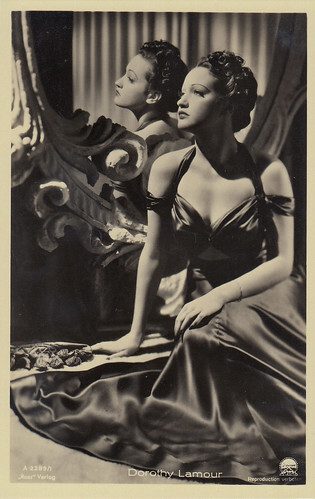
German postcard by Ross Verlag, no. A 2289/1, 1939-1940. Photo: Paramount.
American actress and singer Dorothy Lamour (1914-1996) is best remembered for appearing in the Road to... comedies, starring Bing Crosby and Bob Hope. During World War II, Lamour was among the most popular pin-up girls among American servicemen.
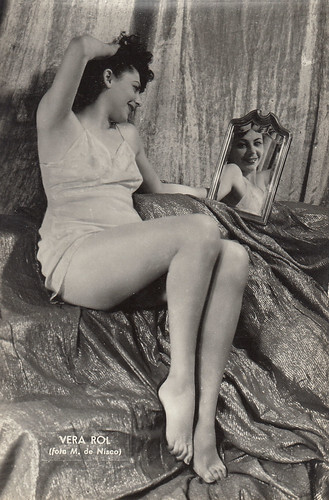
Italian postcard. Photo: M. de Nisco.
A popular revue performer, Vera Rol (1920-1973) had leading roles in two Italian films in the second part of the 1940s: Malaspina (1947) and Nennella (1948).
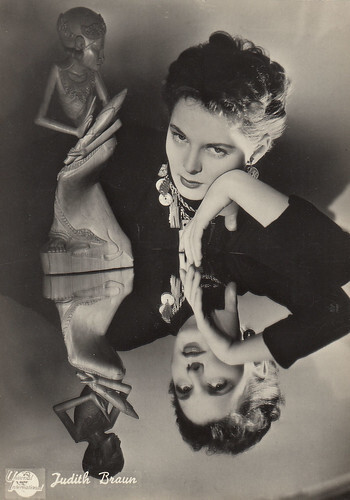
Italian postcard by Bromofoto, Milano, no. 436.
American actress Judith Braun (1930) had the leading female role, as a Red Cross worker, in Universal’s Redball Express (1952), a movie about military truck drivers during Second World War. However, she quickly turned to television and was featured in several TV series until 1962, including Perry Mason and Wanted : Dead or Alive.
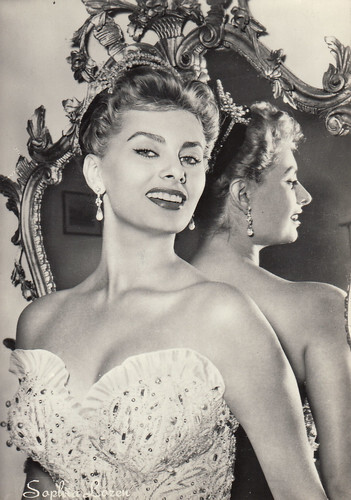
Italian postcard by Rotalfoto, Milano, no. 490.
Sophia Loren (1934) rose to fame in post-war Italy as a voluptuous sex goddess. Soon after, she became one of the most successful stars of the 20th Century, who won an Oscar for her mother role in La ciociara/Two Women (Vittorio De Sica, 1960).
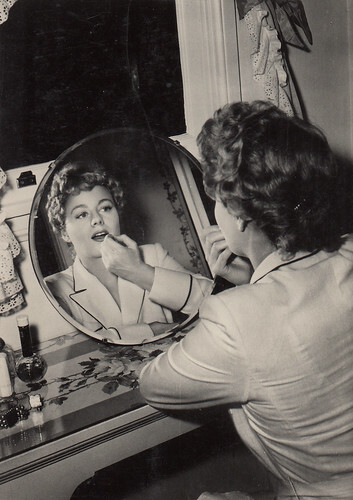
Italian postcard by Rotalfoto, Milano, no. 51/14.
American actress Shelley Winters (1920-2006) appeared in dozens of films, as well as on stage and television. She was a major film presence for six decades, and turned herself from a Blonde Bombshell into a widely-respected actress who won two Oscars, for The Diary of Anne Frank (1959) and A Patch of Blue (1965). Less known, Winters also appeared in several European films, including Alfie (1966) and Roman Polanski's Le Locataire (1976).
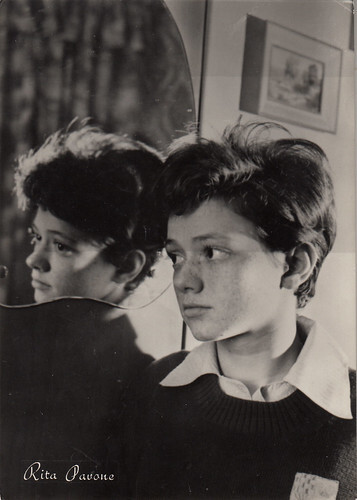
Italian postcard by Rotalfoto, Milano, no. 1034.
Rita Pavone (1945) was one of the biggest teenage stars in Europe during the 1960s, and one of the few Italian pop stars to gain a foothold in the American market. Pavone also starred in several 'Musicarellos'.
See more posts by Marlene Pilaete in our special section La Collectionneuse.

French postcard, no. 153. Photo: G.L. Manuel Frères. Caption: “Les jolies jambes de Mistinguett ” (“Mistinguett’s pretty legs”).
French actress and singer Mistinguett (1875-1956) captivated Paris with her risqué routines. She went on to become the most popular French entertainer of her time and the highest-paid female entertainer in the world. She appeared more than 60 times in the cinema.

British postcard by Lilywhite Ltd., no. C.M. 433 F.
Poppy Wyndham (1893-1928) starred in several British pictures in 1919 and 1920. She then turned to interior design before developing a passion for flying. An aviation pioneer, she died while trying to cross the Atlantic by plane in 1928.

Indian postcard by Jugatram & Co., Bombay, no. 295. Caption: Miss Jubeda, prominent Indian screen star.
Zubeida (1911-1988) was a major Indian film star from 1924 to the mid-1930s. She notably was the heroine of Alam Ara/The Light of the World (Ardeshir Irani, 1931), the first Indian talkie.

Danish postcard by J. Chr. Olsens Kunstforlag, Eneret, no. 472.
Dorothy Dalton was an American actress of the silent screen, at Kay-Bee, Thomas Ince Corp, and Famous Players/ Paramount. In the early 1920s she was a huge film star.

Austrian postcard by Iris Verlag, no. 5551. Photo: Fox.
Brunette, petite American actress Sharon Lynn (1901-1963) was featured in several Fox movies from 1928 to 1930, including musicals such as Fox Movietone Follies of 1929 (1929), Happy Days (1929) and Let’s Go Places (1930). However, her most famous role is certainly the evil saloon singer Lola Marcel in Way Out West (1937) with Laurel and Hardy.

Austrian postcard by Iris Verlag, no. 5999. Photo: Ifuk Verleih / Delog Film.
Blond, German actress Charlotte Susa (1898-1967), was a major operetta star of the German-speaking world, and also a popular femme fatale of the German silent and early sound film.

Postcard by I.P., no. 1002b. Photo: MGM.
Mary Carlisle (1914-2018) was one of the 1930’s cutest Hollywood blondes. She was featured in about 40 movies from 1933 to 1939. She was Bing Crosby’s co-star in College Humor (1933), Double or Nothing (1937) and Doctor Rhythm (1938).

British postcard by Raphael Tuck & Sons, no. 10. Photo: Gaumont-British.
Evelyn Laye (1900–1996) was one of England's most popular stars of musical revue and operetta during the 1920s. She did a few screen appearances in both London and Hollywood, including in the classic musical Evensong (1934).

German postcard by Ross Verlag, no. 9314/1, 1935-1936. Photo: Paramount.
Sylvia Sidney (1910-1999) was an American stage, screen, and film actress whose career spanned over 70 years. She rose to prominence in dozens of leading roles in the 1930s, such as An American Tragedy (1931), City Streets (1931), Alfred Hitchcock's Sabotage (1936), and Fritz Lang's Fury (1936) and You Only Live Once (1937). She later gained attention for her role as Juno, a caseworker in the afterlife, in Tim Burton's film Beetlejuice (1988), and she was nominated for the Oscar for Best Supporting Actress for Summer Wishes, Winter Dreams (1973).

German postcard by Ross Verlag, no. A 2289/1, 1939-1940. Photo: Paramount.
American actress and singer Dorothy Lamour (1914-1996) is best remembered for appearing in the Road to... comedies, starring Bing Crosby and Bob Hope. During World War II, Lamour was among the most popular pin-up girls among American servicemen.

Italian postcard. Photo: M. de Nisco.
A popular revue performer, Vera Rol (1920-1973) had leading roles in two Italian films in the second part of the 1940s: Malaspina (1947) and Nennella (1948).

Italian postcard by Bromofoto, Milano, no. 436.
American actress Judith Braun (1930) had the leading female role, as a Red Cross worker, in Universal’s Redball Express (1952), a movie about military truck drivers during Second World War. However, she quickly turned to television and was featured in several TV series until 1962, including Perry Mason and Wanted : Dead or Alive.

Italian postcard by Rotalfoto, Milano, no. 490.
Sophia Loren (1934) rose to fame in post-war Italy as a voluptuous sex goddess. Soon after, she became one of the most successful stars of the 20th Century, who won an Oscar for her mother role in La ciociara/Two Women (Vittorio De Sica, 1960).

Italian postcard by Rotalfoto, Milano, no. 51/14.
American actress Shelley Winters (1920-2006) appeared in dozens of films, as well as on stage and television. She was a major film presence for six decades, and turned herself from a Blonde Bombshell into a widely-respected actress who won two Oscars, for The Diary of Anne Frank (1959) and A Patch of Blue (1965). Less known, Winters also appeared in several European films, including Alfie (1966) and Roman Polanski's Le Locataire (1976).

Italian postcard by Rotalfoto, Milano, no. 1034.
Rita Pavone (1945) was one of the biggest teenage stars in Europe during the 1960s, and one of the few Italian pop stars to gain a foothold in the American market. Pavone also starred in several 'Musicarellos'.
See more posts by Marlene Pilaete in our special section La Collectionneuse.
Published on March 11, 2022 22:00
March 10, 2022
Dale Evans
American actress, singer, and songwriter Dale Evans (1912-2001) was nicknamed 'the Queen of the West'. She was the third wife of Roy Rogers. Alongside her husband, she appeared in numerous musical Westerns of the 1940s and in The Roy Rogers Show (1951-1957) on TV.
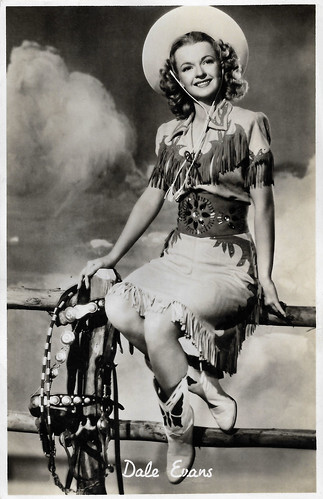
Belgian postcard by Nieuwe Merksemsche Chocolaterie S.P.R.L., Merksem (Antwerp). Photo: Republic Pictures.
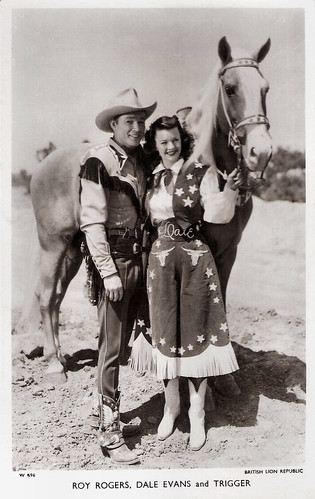
British postcard in the Picturegoer Series, London, no. W. 596. Photo: British Lion Republic. Roy Rogers , Dale Evans, and Trigger.
A productive career as a jazz, swing, and big band singer
Dale Evans was born Frances Octavia Smith in 1912 in Uvalde, Texas, to Bettie Sue Wood and T. Hillman Smith. She had a tumultuous early life. She spent a lot of time living with her uncle, Dr. L.D. Massey MD FACP, an internal medicine physician, in Osceola, Arkansas.
At age 14, she eloped with and married Thomas F. Fox, with whom she had one son, Thomas F. Fox Jr., when she was 15. A year later, abandoned by her husband, she found herself in Memphis, Tennessee, a single parent pursuing a career in music. She landed a job with local radio stations (WMC and WREC), singing and playing the piano.
Divorced in 1929, she began her career singing at radio station WHAS where she was employed as a secretary. She took the name Dale Evans after the station manager suggested it because he believed she could promote her singing career with a short pleasant-sounding name that announcers and disc jockeys could easily pronounce.
Evans had a productive career as a jazz, swing, and big band singer that led to a screen test and contract with 20th Century Fox studios in 1942. She gained exposure on radio as the featured singer for a time on the Edgar Bergen/Charlie McCarthy show.
Throughout this early period, Evans went through two additional failed marriages, first with August Wayne Johns from 1929 to 1935; then with accompanist and arranger Robert Dale Butts from 1937 to 1946. Neither marriage produced children.
During her time at 20th Century Fox, the studio promoted her as the unmarried supporter of her teenage 'brother' Tommy, actually her son Tom Fox, Jr., a deception that continued through her divorce from Butts in 1946 and her development as a cowgirl co-star to Roy Rogers at Republic Studios.
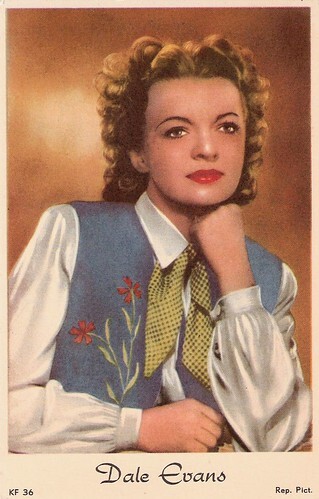
Vintage postcard, no KF 36. Photo: Republic Pictures.
Two icons of American pop culture
At 20th Century Fox, Dale Evans did not get good parts. She was barely visible in her film debut Orchestra Wives (Archie Mayo, 1942) She had to settle for leading roles at Republic Studios, a 'B' factory. She wasn't keen on Westerns, but Westerns were what she got.
In 1944, she was cast as leading lady to rising cowboy star Roy Rogers in Cowboy and the Senorita (Joseph Kane, 1944). She and Rogers clicked and she became his steady on-screen companion in such films as The Yellow Rose of Texas (Joseph Kane, 1944), Don't Fence Me In (John English, 1945), and My Pal Trigger (Frank McDonald, 1946). The two would become icons of American pop culture.
In 1946, Rogers' wife died and Evans' marriage to Butts ended about the same time. Roy and Dale married on New Year's Eve 1947 at the Flying L Ranch in Davis, Oklahoma, where they had earlier filmed the film Home in Oklahoma (William Witney, 1946). The marriage was Rogers' third and Evans' fourth but it was successful; the two were a team on- and off-screen from 1946 until Rogers' death in 1998.
Shortly after the wedding, Evans ended the deception regarding her son Tommy. Roy had an adopted daughter, Cheryl, and two biological children, Linda and Roy Jr. (Dusty), from his second marriage. Together they had one child, Robin Elizabeth, who died of complications of Down syndrome shortly before her second birthday.
Their marriage was dogged by tragedy, including the loss of three children before adulthood. In 1965, son John David died at the age of 18 while in the army and stationed in Germany. Daughter Debbie, originally named In Ai Lee, who was of Korean and Puerto Rican ancestry, died in a bus crash in 1964. Her life inspired Dale Evans to write her bestseller 'Angel Unaware'.
Evans was very influential in changing public perceptions of children with developmental disabilities and served as a role model for many parents. After she wrote 'Angel Unaware', a group then known as the 'Oklahoma County Council for Mentally Retarded Children' adopted its better-known name 'Dale Rogers Training Center' in her honour. She went on to write a number of religious and inspirational books, and she and Roy appeared many times with Billy Graham in Crusades all over the country, singing gospel songs and giving their testimony. Evans and Rogers adopted four other children: Mimi, Dodie, Sandy, and Debbie.
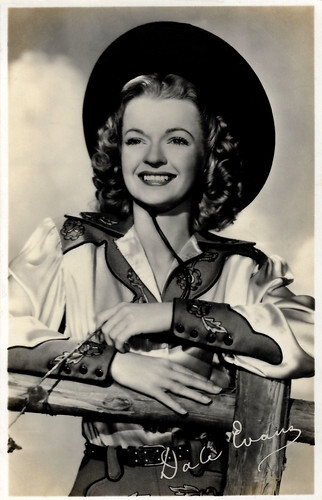
British Real Photograph postcard. Photo: Republic Pictures. Caption: Greetings from Dale Evans.
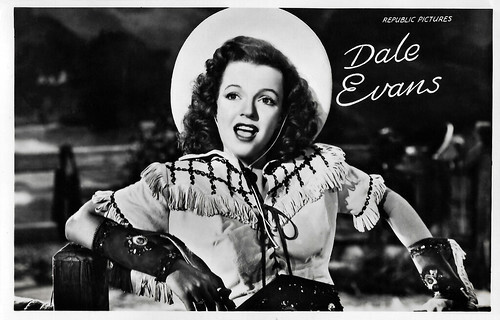
Vintage postcard, no. 3498. Photo: Republic Pictures.
Happy Trails
From 1951-1957, Dale Evans and Roy Rogers starred in the highly-successful television series The Roy Rogers Show, in which they continued their cowboy and cowgirl roles, with her riding her trusty buckskin horse, Buttermilk. Alice Van-Springsteen served as a double for both Evans and Gail Davis, the actress who starred in the syndicated series Annie Oakley, often performing such tasks as tipping over wagons and jumping railroad tracks.
In addition to her successful TV shows, more than 30 films, and some 200 songs, Evans wrote the well-known song 'Happy Trails'. In later episodes of the program, she was outspoken in her Christianity, telling people that God would assist them with their troubles and imploring adults and children to turn to Him for guidance.
In late 1962, the couple co-hosted a comedy-western-variety program, The Roy Rogers and Dale Evans Show, which aired on ABC. It was canceled after three months, losing in the ratings to the first season of The Jackie Gleason Show. The couple's headquarters became The Roy Rogers-Dale Evans Museum in Victorville, California near their Apple Valley home which chronicled their lives.
In the 1970s, Evans recorded several solo albums of religious music. In 1976, Roy and Dale were inducted into the Hall of Great Western Performers of the National Cowboy and Western Heritage Museum. During the 1980s, the couple introduced their films weekly on the former The Nashville Network. In the 1990s, Evans hosted her own religious television program, A Date with Dale.
Dale Evans died of congestive heart failure in 2001, at the age of 88, in Apple Valley, California. She is interred at Sunset Hills Memorial Park in Apple Valley, next to Roy Rogers . Following Dale's death, the Roy Rogers and Dale Evans Museum moved to Branson, Missouri. Dale Evans was awarded 2 Stars on the Hollywood Walk of Fame for Radio at 6638 Hollywood Boulevard and for Television at 1737 Vine Street in Hollywood, California.
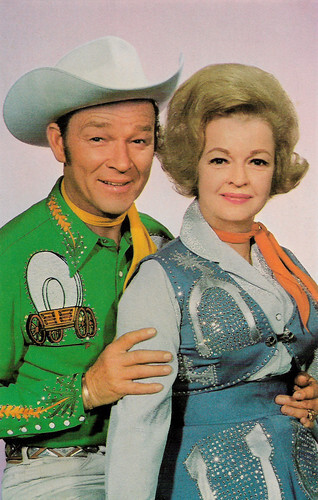
American postcard by Mike Roberts, Berkeley / Inland Distributing Co., Lancaster, CA, for the Roy Rogers and Dale Evans Museum, Victorville, Calif., no C27256. Caption: Roy and Dale.
Sources: Hal Erickson (AllMovie), (IMDb), Donald Greyfield (Find A Grave), Wikipedia, and .

Belgian postcard by Nieuwe Merksemsche Chocolaterie S.P.R.L., Merksem (Antwerp). Photo: Republic Pictures.

British postcard in the Picturegoer Series, London, no. W. 596. Photo: British Lion Republic. Roy Rogers , Dale Evans, and Trigger.
A productive career as a jazz, swing, and big band singer
Dale Evans was born Frances Octavia Smith in 1912 in Uvalde, Texas, to Bettie Sue Wood and T. Hillman Smith. She had a tumultuous early life. She spent a lot of time living with her uncle, Dr. L.D. Massey MD FACP, an internal medicine physician, in Osceola, Arkansas.
At age 14, she eloped with and married Thomas F. Fox, with whom she had one son, Thomas F. Fox Jr., when she was 15. A year later, abandoned by her husband, she found herself in Memphis, Tennessee, a single parent pursuing a career in music. She landed a job with local radio stations (WMC and WREC), singing and playing the piano.
Divorced in 1929, she began her career singing at radio station WHAS where she was employed as a secretary. She took the name Dale Evans after the station manager suggested it because he believed she could promote her singing career with a short pleasant-sounding name that announcers and disc jockeys could easily pronounce.
Evans had a productive career as a jazz, swing, and big band singer that led to a screen test and contract with 20th Century Fox studios in 1942. She gained exposure on radio as the featured singer for a time on the Edgar Bergen/Charlie McCarthy show.
Throughout this early period, Evans went through two additional failed marriages, first with August Wayne Johns from 1929 to 1935; then with accompanist and arranger Robert Dale Butts from 1937 to 1946. Neither marriage produced children.
During her time at 20th Century Fox, the studio promoted her as the unmarried supporter of her teenage 'brother' Tommy, actually her son Tom Fox, Jr., a deception that continued through her divorce from Butts in 1946 and her development as a cowgirl co-star to Roy Rogers at Republic Studios.

Vintage postcard, no KF 36. Photo: Republic Pictures.
Two icons of American pop culture
At 20th Century Fox, Dale Evans did not get good parts. She was barely visible in her film debut Orchestra Wives (Archie Mayo, 1942) She had to settle for leading roles at Republic Studios, a 'B' factory. She wasn't keen on Westerns, but Westerns were what she got.
In 1944, she was cast as leading lady to rising cowboy star Roy Rogers in Cowboy and the Senorita (Joseph Kane, 1944). She and Rogers clicked and she became his steady on-screen companion in such films as The Yellow Rose of Texas (Joseph Kane, 1944), Don't Fence Me In (John English, 1945), and My Pal Trigger (Frank McDonald, 1946). The two would become icons of American pop culture.
In 1946, Rogers' wife died and Evans' marriage to Butts ended about the same time. Roy and Dale married on New Year's Eve 1947 at the Flying L Ranch in Davis, Oklahoma, where they had earlier filmed the film Home in Oklahoma (William Witney, 1946). The marriage was Rogers' third and Evans' fourth but it was successful; the two were a team on- and off-screen from 1946 until Rogers' death in 1998.
Shortly after the wedding, Evans ended the deception regarding her son Tommy. Roy had an adopted daughter, Cheryl, and two biological children, Linda and Roy Jr. (Dusty), from his second marriage. Together they had one child, Robin Elizabeth, who died of complications of Down syndrome shortly before her second birthday.
Their marriage was dogged by tragedy, including the loss of three children before adulthood. In 1965, son John David died at the age of 18 while in the army and stationed in Germany. Daughter Debbie, originally named In Ai Lee, who was of Korean and Puerto Rican ancestry, died in a bus crash in 1964. Her life inspired Dale Evans to write her bestseller 'Angel Unaware'.
Evans was very influential in changing public perceptions of children with developmental disabilities and served as a role model for many parents. After she wrote 'Angel Unaware', a group then known as the 'Oklahoma County Council for Mentally Retarded Children' adopted its better-known name 'Dale Rogers Training Center' in her honour. She went on to write a number of religious and inspirational books, and she and Roy appeared many times with Billy Graham in Crusades all over the country, singing gospel songs and giving their testimony. Evans and Rogers adopted four other children: Mimi, Dodie, Sandy, and Debbie.

British Real Photograph postcard. Photo: Republic Pictures. Caption: Greetings from Dale Evans.

Vintage postcard, no. 3498. Photo: Republic Pictures.
Happy Trails
From 1951-1957, Dale Evans and Roy Rogers starred in the highly-successful television series The Roy Rogers Show, in which they continued their cowboy and cowgirl roles, with her riding her trusty buckskin horse, Buttermilk. Alice Van-Springsteen served as a double for both Evans and Gail Davis, the actress who starred in the syndicated series Annie Oakley, often performing such tasks as tipping over wagons and jumping railroad tracks.
In addition to her successful TV shows, more than 30 films, and some 200 songs, Evans wrote the well-known song 'Happy Trails'. In later episodes of the program, she was outspoken in her Christianity, telling people that God would assist them with their troubles and imploring adults and children to turn to Him for guidance.
In late 1962, the couple co-hosted a comedy-western-variety program, The Roy Rogers and Dale Evans Show, which aired on ABC. It was canceled after three months, losing in the ratings to the first season of The Jackie Gleason Show. The couple's headquarters became The Roy Rogers-Dale Evans Museum in Victorville, California near their Apple Valley home which chronicled their lives.
In the 1970s, Evans recorded several solo albums of religious music. In 1976, Roy and Dale were inducted into the Hall of Great Western Performers of the National Cowboy and Western Heritage Museum. During the 1980s, the couple introduced their films weekly on the former The Nashville Network. In the 1990s, Evans hosted her own religious television program, A Date with Dale.
Dale Evans died of congestive heart failure in 2001, at the age of 88, in Apple Valley, California. She is interred at Sunset Hills Memorial Park in Apple Valley, next to Roy Rogers . Following Dale's death, the Roy Rogers and Dale Evans Museum moved to Branson, Missouri. Dale Evans was awarded 2 Stars on the Hollywood Walk of Fame for Radio at 6638 Hollywood Boulevard and for Television at 1737 Vine Street in Hollywood, California.

American postcard by Mike Roberts, Berkeley / Inland Distributing Co., Lancaster, CA, for the Roy Rogers and Dale Evans Museum, Victorville, Calif., no C27256. Caption: Roy and Dale.
Sources: Hal Erickson (AllMovie), (IMDb), Donald Greyfield (Find A Grave), Wikipedia, and .
Published on March 10, 2022 22:00
March 9, 2022
Maurice Costello
Maurice Costello (1877-1950) was a prominent American vaudeville actor of the late 1890s and early 1900s. Later, he became a famous matinee idol and director at The Vitagraph Co. of America.
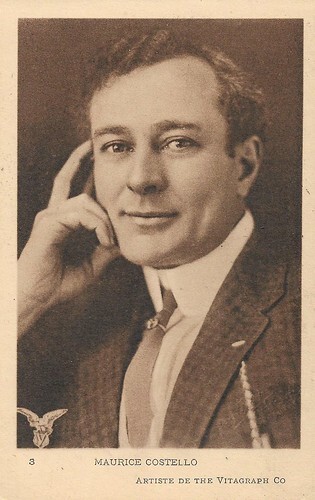
French postcard, probably issued by Vitagraph's subsidiary in Paris, no. 3. Photo: Vitagraph.
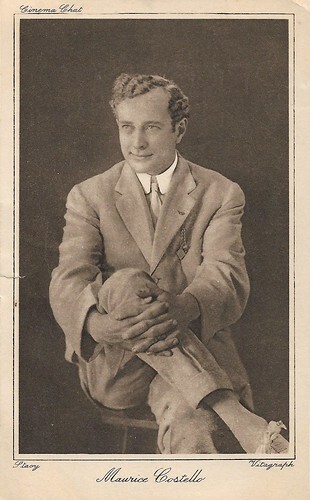
British Postcard by Cinema Chat. Photo: Stacy.
The father of screen acting
Maurice George Costello was born in 1877 in Pittsburgh, Pennsylvania to Irish immigrants Ellen (née Fitzgerald) and Thomas Costello. His father Thomas died while repairing a blast furnace at Andrew Carnegie's Union Iron Mill when Maurice was just five months old. He had a strongly Irish upbringing, living with his mother, her Irish brother, and many Irish immigrant boarders.
After various jobs as messenger, office boy, and the like, Costello made his stage debut in local Pittsburgh vaudeville in 1894 singing Irish songs like 'Here Lies the Mick That Threw the Brick (He'll Never Throw Another).' Finding some success in the theatre, he toured on stage in 'Scotland Yard', 'The Kentucky Feud', and 'The Cowboy and the Lady'. While appearing in the latter play he married Mae Altshuk in 1902. It would prove to be a stormy union.
Though some sources claim he started at Edison in 1905, most sources agree that Costello made his film debut in 1908 at the company Vitagraph. At first, he specialised in Shakespearean roles, and in his first year he starred in adaptations of Richard III (J. Stuart Blackton, William V. Ranous, 1908), Antony and Cleopatra (J. Stuart Blackton, Charles Kent, 1908), Julius Caesar (J. Stuart Blackton, William V. Ranous, 1908), The Merchant of Venice (J. Stuart Blackton, 1908), King Lear (J. Stuart Blackton, William V. Ranous, 1909), and A Midsummer Night's Dream (Charles Kent, J. Stuart Blackton, 1909).
He then broadened his range to take in contemporary melodrama and sophisticated comedy. Nicknamed "Dimples" by his colleagues, Costello was adored by early filmgoers. Quickly he became one of its leading men players, opposite actresses such as first Florence Turner, and later on Clara Kimball Young, Norma Talmadge , and Lilian Walker. Among his male co-actors were William V. Ranous, Leo Delaney, Charles Eldridge, Tom Powers, and Van Dyke Brooke. He won the cinema's first-ever popularity poll, conducted by Motion Picture Story magazine in 1912, with more than 400,000 votes cast in his favour, but the results are rather suspect, however, since the magazine was owned by Vitagraph.
Costello was notorious for his refusal to help build sets, insisting that he was "hired as an actor and nothing else", despite the common practice of the time. However, Costello proved to be a popular player and he was among the first actors to receive on-screen credit beginning in 1911. From this and his role as the creator of the first known school of screen acting, Costello is sometimes credited as "the father of screen acting".
In 1909, Costello discovered Moe Howard of the Three Stooges, who, as a teenager, ran errands and got lunches for the actors at the Vitagraph Studios at no charge. This impressed Costello who brought him in and introduced him to other leading actors of the day. Moe then gained small parts in many of the Vitagraph movies, under the name Harry Howard, ;but most of these were destroyed by a fire that swept the studios in 1910.
On the Desmet Playlist of the Dutch EYE Filmmuseum, you can find several of Costello's shorts for Vitagraph, such as Lulu's Doctor (1912) also with little Dolores Costello , The Picture Idol (1912), It All Came Out in the Wash (1912), When Persistency and Obstinacy Meet (1912), A Vitagraph Romance (1912), Mrs. 'Enry 'Awkins (1912), The Days of Terror (1912), Aunty's Romance (1912), The Meeting of the Ways (1912), also with Dolores and Helene Costello, The Lonely Princess (1913) shot in Venice, Italy, and Delayed Proposals (1913). Some are in tinted versions.
With Mae Costello (née Altschuk),he had two daughters, Dolores (born in 1905), and Helene (born in 1903) would, as children, act in his films. On 23 November 1913, Costello was arrested for beating his wife. Costello admitted that he had beaten his wife while intoxicated. Mae Costello requested that the charges be dropped to disorderly conduct, and Costello was given six months probation by Magistrate Geisner of the Coney Island Police Court. Costello's domestic troubles wreaked havoc with his public approval.
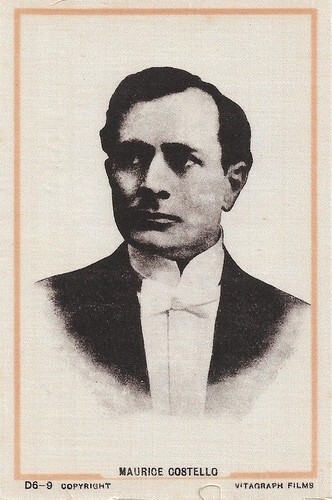
British postcard in the Novelty Series, no. D6-9. Photo: Vitagraph Films.
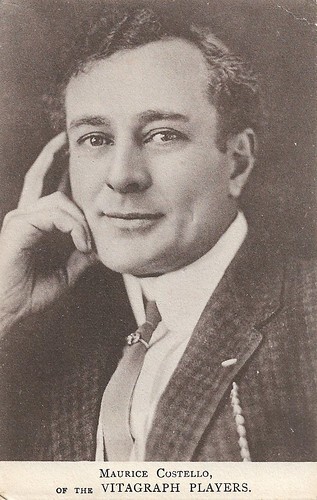
British postcard, editor unknown. Caption: Maurice Costello, of the Vitagraph Players.
Playing second fiddle and finally bit parts
With Robert Gaillard, Maurice Costello co-directed many films at Vitagraph, as of 1910, both shorts and features. Among some of his best-known pictures are Les Miserables (3 parts, 1909), A Tale of Two Cities (William Humphrey, 1911), For Love and Glory (Van Dyke Brooke, 1911), The Golden Pathway (1913), and Iron and Steel (Maurice Costello, Robert Gaillard, 1914).
The Man Who Couldn't Beat God (Maurice Costello, Robert Gaillard, 1915) was Costello's last film direction. He suffered a nervous breakdown and was absent from the screen for a year. When he returned, he seemed suddenly aged. He starred in the Erbograph-Consolidated serial The Crimson Stain Mystery (1916), but the bad publicity had already done its damage. Costello and his wife reconciled for a time. After another absence between 1916 and 1919, Costello returned to the screen and to Vitagraph, but now only as an actor, opposite actresses such as Corinne Griffith .
His last film for Vitagraph was probably The Tower of Jewels (Tom Terriss, 1920). In the 1920s Costello worked for various small production companies but also several times for Paramount, often playing second fiddle to the male and female star, e.g. as Armand's father in Fred Niblo's Camille (1926), starring Norma Talmadge and Gilbert Roland . He continued to act in the silent film until 1928.
In 1925 he attempted a comeback in vaudeville with a dramatic sketch called 'The Battle'. The act opened in Staten Island, but it stirred little interest. In 1928 he tried another dramatic sketch, 'The Pay Off'. This opened in Tacoma, Washington, and again did nothing to revive his career.
In 1927, he and Mae divorced. He was strongly opposed to the marriage of daughter Dolores Costello to John Barrymore. Maurice knew of Barrymore's history of womanising and heavy drinking and was strongly put off by the fact that Barrymore was closer in age to him than his daughter, and he frequently begged his daughter not to go through with it, saying that it would not last. She went against his wishes and married Barrymore anyway.
Like a lot of other silent screen stars, Costello had found the transition to 'talkies' extremely difficult, and his leading man status was over when sound set in. Between 1928 and 1934 Maurice Costello was away from the film sets. Apart from incidental bit parts in the mid-1930s, he did a whole range of uncredited parts in American films since then. Costello suffered a cerebral hemorrhage in 1932 while eating in a Beverly Hills drug store, but the stroke was minor and he recovered fully. He came out of retirement to take a small role in Hollywood Boulevard (Robert Florey, 1936) and also did some radio work.
By the late 1930s, his career had declined to the point where he was reduced to taking unbilled work as a background extra for a day or two at a few dollars a day. By 1939 he was so broke that he had to sue his daughters for financial support. In 1939, he married thirty-year-old Ruth Reeves, an operator at the Central Casting Agency. Robert S. Birchard at Hollywood Heritage: "In 1941 the second Mrs. Costello sought a Tijuana divorce claiming that Costello was "unreasonably and insanely jealous" and that he threatened her with a .22 rifle."
From 1946 to the end of his life Maurice Costello lived in retirement as a resident of the Motion Picture Country House in Los Angeles. In 1950 Costello died at the age of 73 there, due to a heart problem. His descendants include two daughters, actresses Dolores Costello and Helene Costello, a grandson, actor John Drew Barrymore, and a great-granddaughter, film actress Drew Barrymore.
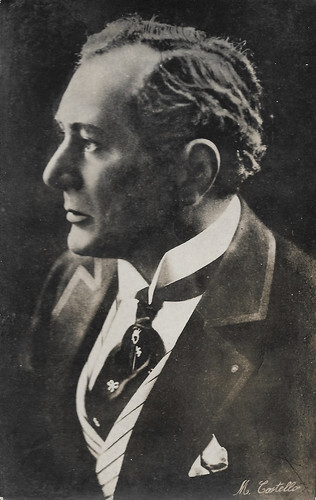
Spanish postcard by PH.
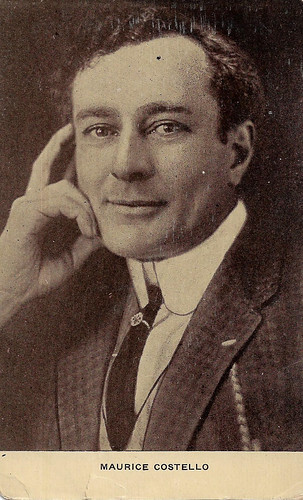
American postcard by Kraus Mfg. Co., New York. Photo: Vitagraph.
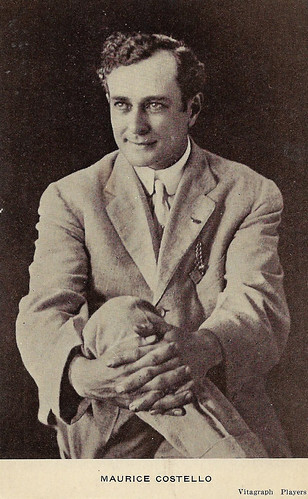
American postcard by Kraus Mfg. Co., New York. Photo: Vitagraph Players.
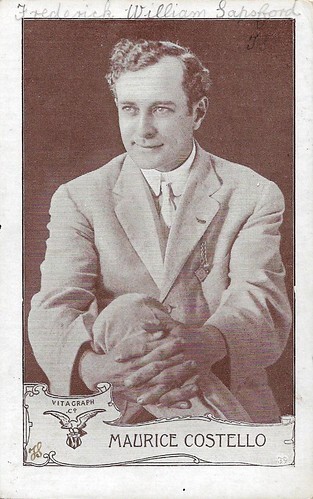
American postcard by Vitagraph Co., no. 39. The name written on the card is not Costello's original name.
Sources: Robert S. Birchard (Hollywood Heritage - WaybackMachine), Bobb Edwards (Find A Grave), Wikipedia, and .

French postcard, probably issued by Vitagraph's subsidiary in Paris, no. 3. Photo: Vitagraph.

British Postcard by Cinema Chat. Photo: Stacy.
The father of screen acting
Maurice George Costello was born in 1877 in Pittsburgh, Pennsylvania to Irish immigrants Ellen (née Fitzgerald) and Thomas Costello. His father Thomas died while repairing a blast furnace at Andrew Carnegie's Union Iron Mill when Maurice was just five months old. He had a strongly Irish upbringing, living with his mother, her Irish brother, and many Irish immigrant boarders.
After various jobs as messenger, office boy, and the like, Costello made his stage debut in local Pittsburgh vaudeville in 1894 singing Irish songs like 'Here Lies the Mick That Threw the Brick (He'll Never Throw Another).' Finding some success in the theatre, he toured on stage in 'Scotland Yard', 'The Kentucky Feud', and 'The Cowboy and the Lady'. While appearing in the latter play he married Mae Altshuk in 1902. It would prove to be a stormy union.
Though some sources claim he started at Edison in 1905, most sources agree that Costello made his film debut in 1908 at the company Vitagraph. At first, he specialised in Shakespearean roles, and in his first year he starred in adaptations of Richard III (J. Stuart Blackton, William V. Ranous, 1908), Antony and Cleopatra (J. Stuart Blackton, Charles Kent, 1908), Julius Caesar (J. Stuart Blackton, William V. Ranous, 1908), The Merchant of Venice (J. Stuart Blackton, 1908), King Lear (J. Stuart Blackton, William V. Ranous, 1909), and A Midsummer Night's Dream (Charles Kent, J. Stuart Blackton, 1909).
He then broadened his range to take in contemporary melodrama and sophisticated comedy. Nicknamed "Dimples" by his colleagues, Costello was adored by early filmgoers. Quickly he became one of its leading men players, opposite actresses such as first Florence Turner, and later on Clara Kimball Young, Norma Talmadge , and Lilian Walker. Among his male co-actors were William V. Ranous, Leo Delaney, Charles Eldridge, Tom Powers, and Van Dyke Brooke. He won the cinema's first-ever popularity poll, conducted by Motion Picture Story magazine in 1912, with more than 400,000 votes cast in his favour, but the results are rather suspect, however, since the magazine was owned by Vitagraph.
Costello was notorious for his refusal to help build sets, insisting that he was "hired as an actor and nothing else", despite the common practice of the time. However, Costello proved to be a popular player and he was among the first actors to receive on-screen credit beginning in 1911. From this and his role as the creator of the first known school of screen acting, Costello is sometimes credited as "the father of screen acting".
In 1909, Costello discovered Moe Howard of the Three Stooges, who, as a teenager, ran errands and got lunches for the actors at the Vitagraph Studios at no charge. This impressed Costello who brought him in and introduced him to other leading actors of the day. Moe then gained small parts in many of the Vitagraph movies, under the name Harry Howard, ;but most of these were destroyed by a fire that swept the studios in 1910.
On the Desmet Playlist of the Dutch EYE Filmmuseum, you can find several of Costello's shorts for Vitagraph, such as Lulu's Doctor (1912) also with little Dolores Costello , The Picture Idol (1912), It All Came Out in the Wash (1912), When Persistency and Obstinacy Meet (1912), A Vitagraph Romance (1912), Mrs. 'Enry 'Awkins (1912), The Days of Terror (1912), Aunty's Romance (1912), The Meeting of the Ways (1912), also with Dolores and Helene Costello, The Lonely Princess (1913) shot in Venice, Italy, and Delayed Proposals (1913). Some are in tinted versions.
With Mae Costello (née Altschuk),he had two daughters, Dolores (born in 1905), and Helene (born in 1903) would, as children, act in his films. On 23 November 1913, Costello was arrested for beating his wife. Costello admitted that he had beaten his wife while intoxicated. Mae Costello requested that the charges be dropped to disorderly conduct, and Costello was given six months probation by Magistrate Geisner of the Coney Island Police Court. Costello's domestic troubles wreaked havoc with his public approval.

British postcard in the Novelty Series, no. D6-9. Photo: Vitagraph Films.

British postcard, editor unknown. Caption: Maurice Costello, of the Vitagraph Players.
Playing second fiddle and finally bit parts
With Robert Gaillard, Maurice Costello co-directed many films at Vitagraph, as of 1910, both shorts and features. Among some of his best-known pictures are Les Miserables (3 parts, 1909), A Tale of Two Cities (William Humphrey, 1911), For Love and Glory (Van Dyke Brooke, 1911), The Golden Pathway (1913), and Iron and Steel (Maurice Costello, Robert Gaillard, 1914).
The Man Who Couldn't Beat God (Maurice Costello, Robert Gaillard, 1915) was Costello's last film direction. He suffered a nervous breakdown and was absent from the screen for a year. When he returned, he seemed suddenly aged. He starred in the Erbograph-Consolidated serial The Crimson Stain Mystery (1916), but the bad publicity had already done its damage. Costello and his wife reconciled for a time. After another absence between 1916 and 1919, Costello returned to the screen and to Vitagraph, but now only as an actor, opposite actresses such as Corinne Griffith .
His last film for Vitagraph was probably The Tower of Jewels (Tom Terriss, 1920). In the 1920s Costello worked for various small production companies but also several times for Paramount, often playing second fiddle to the male and female star, e.g. as Armand's father in Fred Niblo's Camille (1926), starring Norma Talmadge and Gilbert Roland . He continued to act in the silent film until 1928.
In 1925 he attempted a comeback in vaudeville with a dramatic sketch called 'The Battle'. The act opened in Staten Island, but it stirred little interest. In 1928 he tried another dramatic sketch, 'The Pay Off'. This opened in Tacoma, Washington, and again did nothing to revive his career.
In 1927, he and Mae divorced. He was strongly opposed to the marriage of daughter Dolores Costello to John Barrymore. Maurice knew of Barrymore's history of womanising and heavy drinking and was strongly put off by the fact that Barrymore was closer in age to him than his daughter, and he frequently begged his daughter not to go through with it, saying that it would not last. She went against his wishes and married Barrymore anyway.
Like a lot of other silent screen stars, Costello had found the transition to 'talkies' extremely difficult, and his leading man status was over when sound set in. Between 1928 and 1934 Maurice Costello was away from the film sets. Apart from incidental bit parts in the mid-1930s, he did a whole range of uncredited parts in American films since then. Costello suffered a cerebral hemorrhage in 1932 while eating in a Beverly Hills drug store, but the stroke was minor and he recovered fully. He came out of retirement to take a small role in Hollywood Boulevard (Robert Florey, 1936) and also did some radio work.
By the late 1930s, his career had declined to the point where he was reduced to taking unbilled work as a background extra for a day or two at a few dollars a day. By 1939 he was so broke that he had to sue his daughters for financial support. In 1939, he married thirty-year-old Ruth Reeves, an operator at the Central Casting Agency. Robert S. Birchard at Hollywood Heritage: "In 1941 the second Mrs. Costello sought a Tijuana divorce claiming that Costello was "unreasonably and insanely jealous" and that he threatened her with a .22 rifle."
From 1946 to the end of his life Maurice Costello lived in retirement as a resident of the Motion Picture Country House in Los Angeles. In 1950 Costello died at the age of 73 there, due to a heart problem. His descendants include two daughters, actresses Dolores Costello and Helene Costello, a grandson, actor John Drew Barrymore, and a great-granddaughter, film actress Drew Barrymore.

Spanish postcard by PH.

American postcard by Kraus Mfg. Co., New York. Photo: Vitagraph.

American postcard by Kraus Mfg. Co., New York. Photo: Vitagraph Players.

American postcard by Vitagraph Co., no. 39. The name written on the card is not Costello's original name.
Sources: Robert S. Birchard (Hollywood Heritage - WaybackMachine), Bobb Edwards (Find A Grave), Wikipedia, and .
Published on March 09, 2022 22:00
March 7, 2022
Erna Morena
It's International Women’s Day! EFSP celebrates one of the most unusual stars of silent German cinema. Erna Morena (1885-1962) had a star appeal as later Greta Garbo had. Although her name is now largely forgotten, Morena appeared in about 120 films during five decades. She had an enormous career in the German silent cinema of the 1910s and 1920s as both an actress, producer, and screenwriter, and until the mid-1930s she was regularly performing in German sound films.
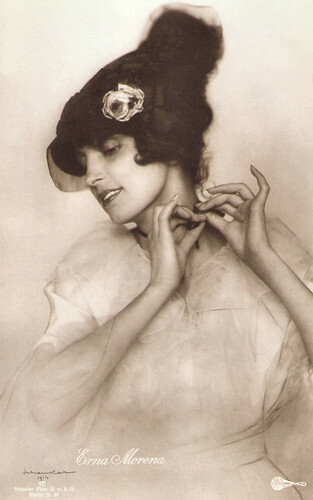
German postcard by Messter Film GmbH. Photo: Schenker, 1914.
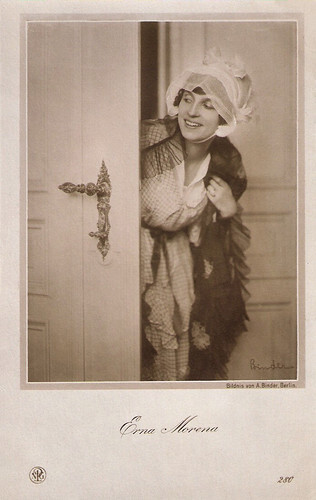
German postcard by NPG, no. 280. Photo: A. (Alex) Binder, Berlin.
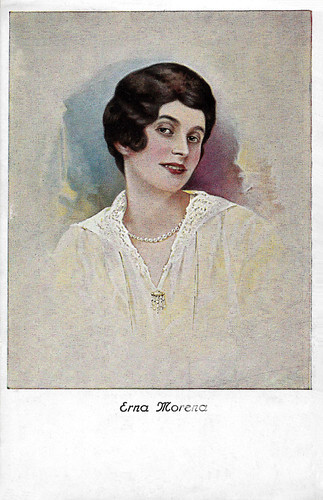
German postcard in the Moderne Künstler series by MMB, no. 463. Photo: F.J. Wesselsky.

German postcard by Photochemie, Berlin, no. K. 1740. Photo: Alex Binder, Berlin.
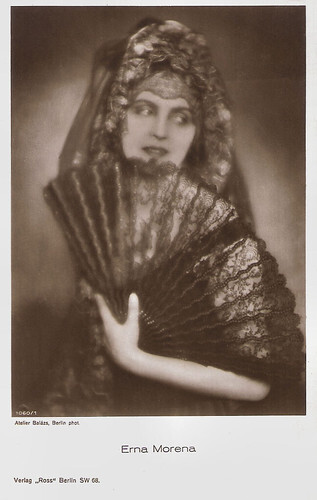
German postcard by Ross Verlag, no. 1060/1, 1927-1928. Photo: Atelier Balázs, Berlin.
Bewildered by her subtle performance
Erna Morena was born Ernestine Maria Fuchs in a bourgeois family in Wörth am Main, Germany, in 1885. At the age of 17, she went to München (Munich) to attend the Kunstgewerbeschule (art school). Later, she spent six months in Paris, until finally at the end of the first decade she moved to Berlin and worked there as a nurse.
In 1910, Morena started her acting career at the Schauspielschule des Deutschen Theaters (the acting school of the German Theatre) and swiftly got an engagement at the Ensemble Max Reinhardt.
She made her film debut in 1913. Her first film was Sphynx/The Sphinx (Eugen Illés, 1913), and she went on to play in several more dramas by Eugen Illés for the Duskes company.
In 1914, she moved to the Messter Film company, where she appeared with Emil Jannings and Theodoor Loos in Arme Eva/Poor Eva (Robert Wiene, 1914) and with Hella Moja in Die weiße Rose/The White Rose (Franz Hofer, 1915).
From 1915 to 1921 she was married to editor and stage author Wilhelm Herzog, who had also invented her stage name, Erna Morena. All her Messter-films were distributed under the trademark of 'Erna Morena Film Serie', rivalling the series of Asta Nielsen and Henny Porten .
Around 1917 she moved to PAGU, where she starred in an adaptation of Franz Wedekind's play 'Lulu' (Alexander Antalffy, 1917) opposite Harry Liedtke and Emil Jannings , and in Paul Leni's Prima Vera (Paul Leni, 1917), based on Alexandre Dumas, fils' 'La Dame aux camélias' (Camille). Critics were bewildered by her subtle performance.
Morena also dabbled as a producer: in 1918 she founded Erna Morena Film GmbH in Berlin, supported by some friends as partners. She produced films like Colomba (Arzén von Cserépy, 1918) with Werner Krauss , and Die 999. Nacht/The 999th Night (Fred Sauer, 1920) with Hans Albers . Because of the economic crisis after the German November Revolution of 1918-1919, she had to stop producing after two years.
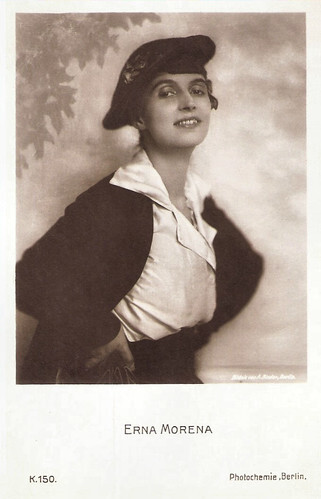
German postcard by Photochemie, Berlin, no. K. 150. Photo: Alex Binder, Berlin.
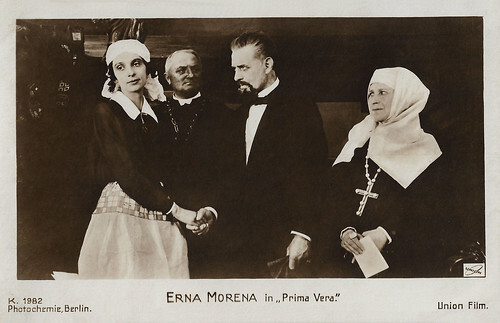
German postcard by Photochemie, Berlin, no. K. 1982. Photo: Union Film. Erna Morena in Prima Vera (Paul Leni, 1917).
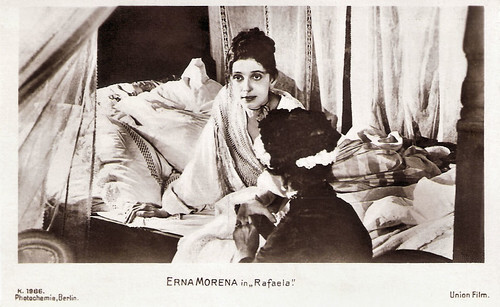
German postcard by Photochemie, Berlin, no. K. 1986. Photo: Union-Film. Erna Morena in Rafaela/Wer weiss? (Arsen von Cserépy, 1917).
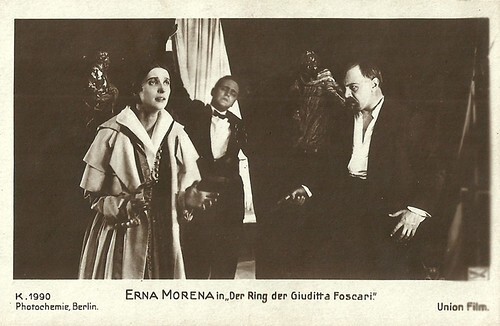
German postcard by Photochemie, Berlin, no. K. 1990. Photo: Union Film. Erna Morena, Emil Jannings and Harry Liedtke in Der Ring der Giuditta Foscari (Alfred Halm, 1917).
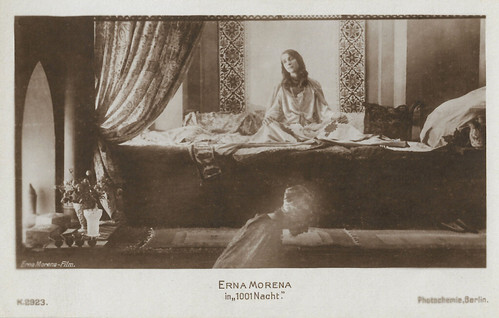
German postcard by Photochemie, no. K. 2923. Photo: Erna Morena-Film. Erna Morena in Die 999. Nacht/The 999th night (Fred Sauer, 1920).
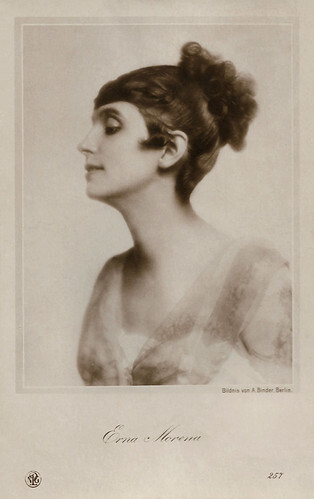
German postcard by NPG, no. 257. Photo: Alex Binder, Berlin.
Her long neck and dark looks
Erna Morena was one of the most unusual stars of silent German cinema. Dark-haired, tall, and with distinctive facial features, she had a star appeal as later Greta Garbo had.
Morena was most successful with her films by director Richard Oswald in the late 1910s and early 1920s, such as Das Tagebuch einer Verlorenen/Diary of a Lost Woman (Richard Oswald, 1918) a forerunner of the version by Georg Wilhelm Pabst, and the horror film Nachtgestalten/Figures of the Night (1920) starring Paul Wegener .
She also starred in some classic Expressionist films including Nerven/Nerves (Robert Reinert, 1919), Von morgens bis Mitternacht/From Morn to Midnight (Karl Heinz Martin, 1920) with Ernst Deutsch , and Der Gang in die Nacht/The Dark Road (F.W. Murnau, 1921) with Olaf Fönss and Conrad Veidt .
With her long neck and dark looks she often played exotic beauties, as in Die Lieblingsfrau des Maharadscha, 3./The Favourite Wife of the Maharajah (Max Mack, 1921), and Das Indische Grabmal, 1. and 2./The Indian Tomb (Joe May, 1921), but also regal beauties in historical dramas as Fridericus Rex 1., 2., 3. and 4. (Arzén von Cserépy, 1922-1923) with Otto Gebühr , Wallenstein 1. and 2. (Rolf Randolf, 1925), Bismarck 1. and 2. (Ernst Wendt, 1925), and Das Schicksal derer von Habsburg/The destiny of the Habsburgs (Rolf Raffé, 1928) in which she played Empress Elisabeth - Sissi.
Of course there were also contemporary set stories like Der Berg des Schicksals/The Mountain of Destiny (Arnold Fanck, 1924) with Luis Trenker , the film that inspired Leni Riefenstahl to pursue a career in film; Mutter und Kind/Mother and Child (Carl Froehlich, 1924); Man spielt nicht mit Liebe/One Does Not Play with Love (G.W. Pabst, 1926) starring Werner Krauss and Lili Damita ; Grand Hotel (Johannes Guter, 1927) with a script by Bela Balazs, and Somnambul/The Somnambulist (Adolf Trotz, 1929) with Fritz Kortner .
She also played in one Dutch film, De bruut/The brute (1922) directed by Theo Frenkel, who had an active career in Germany in the 1920s, and in the French film Le fauteuil 47/ Chair no. 47 (Gaston Ravel, 1926) with Dolly Davis .

German postcard in the Film Sterne series by Rotophot, no. 529/2. Photo: Richard Oswald-Film. Erna Morena in Das Tagebuch einer Verlorenen/The Diary of a Lost Woman (Richard Oswald, 1918), based on the homonymous novel (1905) by Margarete Böhme. In 1929, G.W. Pabst would film another adaptation, starring Louise Brooks, while already in 1912 an earlier adaptation by Fritz Bernhardt had taken place.
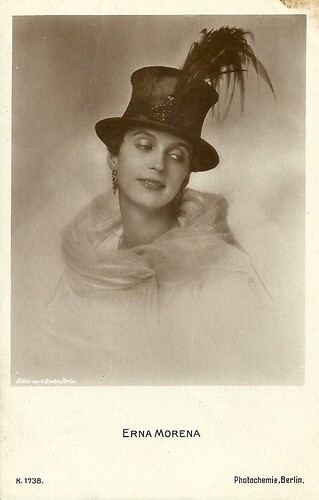
German postcard by Photochemie, no. K. 1738. Photo: Alex Binder, Berlin.
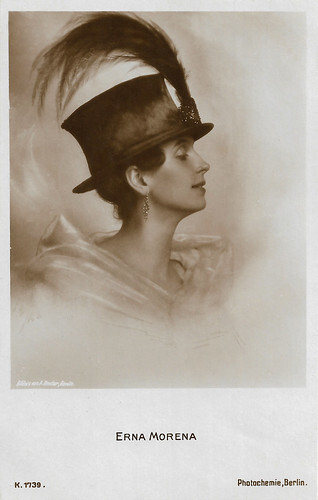
German postcard by Photochemie, no. K. 1739. Photo: Alex Binder, Berlin.
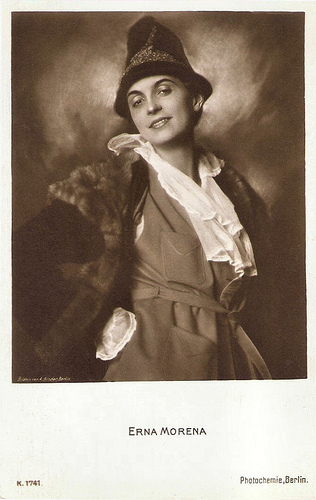
German postcard by Photochemie, no. K. 1741. Photo: Alex Binder, Berlin.
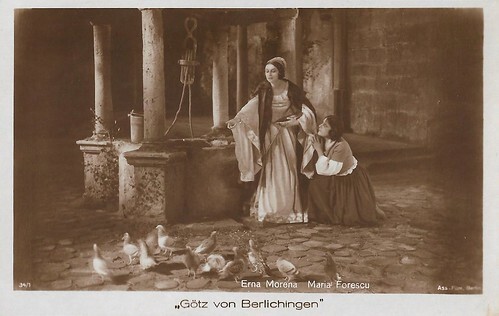
German postcard by Ross Verlag, Berlin, no. 34/1. Photo: Ass-Film, Berlin. Erna Morena and Maria Forescu in the German silent film Götz von Berlichingen zubenannt mit der eisernen Hand (Hubert Moest, 1925), an adaptation of Goethe's historical play set in medieval times. Morena played the countess Ravenstein and Forescu a farmer's wife.
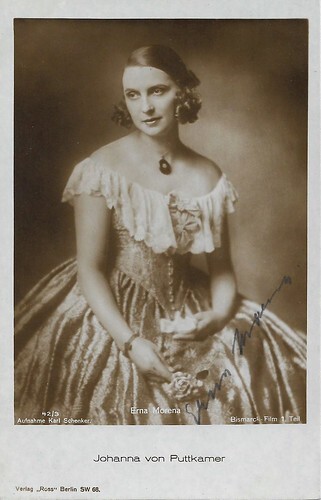
German postcard by Ross Verlag, no. 42/3. Photo: Karl Schenker / Bismarck-Film. Erna Morena as Johanna von Bismarck, née Puttkamer in the German biopic Bismarck, Teil. 1 (Ernst Wendt, 1925). Signed by Erna Morena.
Her heydays were over
Erna Morena seems to have made the passage to sound cinema quite smoothly as there was no big arrest in her number of film roles.
Still, from the young star and protagonist of the films of the late-1910s and early 1920s she had to be satisfied now with playing mothers, secondary roles. Her heydays were over.
Among her more interesting films of this period are Das Lied der Nationen/The Song of the Nations (Rudolf Meinert, 1931) with Camilla Horn , Eine Nacht im Paradies/A Night in Paradise (Carl Lamac, 1932) starring Anny Ondra, Drei Kaiserjäger/Three Imperial Light Infantrymen (Franz Hofer, Robert Land, 1933), and the operetta Abschiedswalzer/Farewell Waltz (Géza von Bolváry, 1934).
In the mid-1930s, she opened a pension for artists in München (Munich), and only returned to the film set for small parts in a handful of films, including the notorious Jud Süss ( Veit Harlan , 1940).
After the war, she appeared in only one film, Veit Harlan 's Unsterbliche Geliebte/Eternal Beloved (1951), an emblematic title as the film meant Morena's goodbye.
One decade later, Erna Morena died in München, in 1962. Between 1913 and 1951 she had appeared in about 120 films. She had a daughter, Eva-Maria Herzog.
In 2006 filmmakers Bettina Neuhaus and Natasja Giebels made a poetic film portrait about the life story and personality of Erna Morena, Schwarzer Schwan/Black Swan.
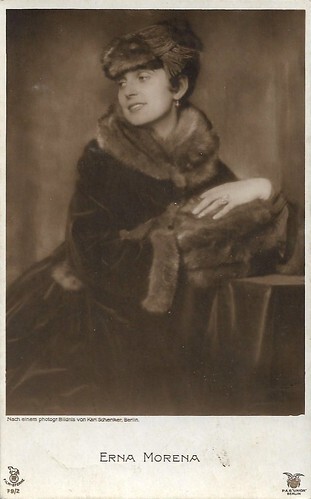
German postcard in the Film Sterne Series by Rotophot, no. 79/2. Photo: Karl Schenker, Berlin / P.A.G. Union.
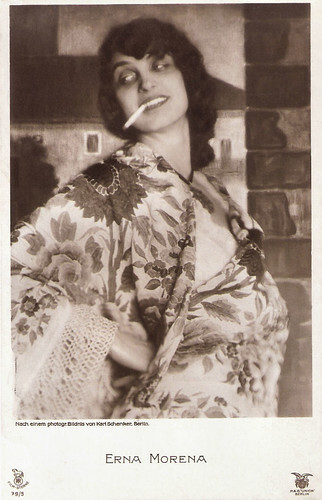
German postcard in the Film Sterne Series by Rotophot, no. 79/5. Photo: Karl Schenker, Berlin / P.A.G. Union. Collection: Didier Hanson.
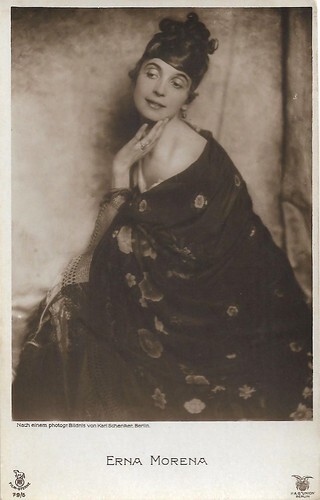
German postcard in the Film Sterne Series by Rotophot, no. 79/6. Photo: Karl Schenker, Berlin / P.A.G. Union.
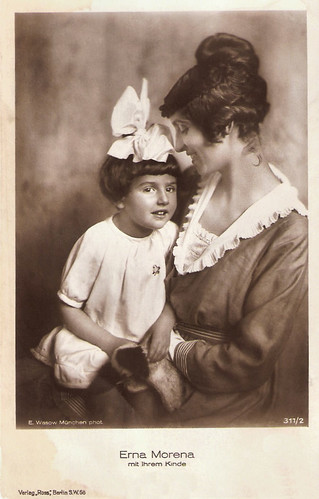
German postcard by Ross Verlag, Berlin, no. 311/2, 1919-1924. Photo: Wasow, München (Munich). Erna Morena and her daughter.
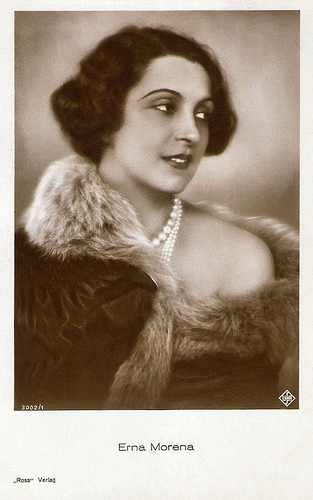
German postcard by Ross Verlag, no. 3002/1, 1928-1929. Photo: Ufa.
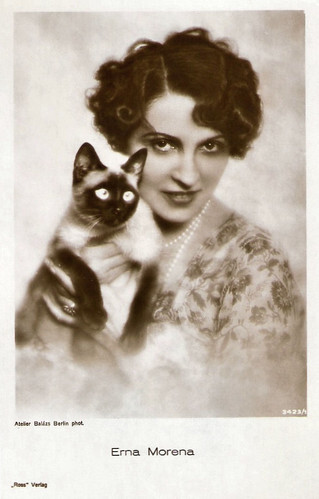
German postcard by Ross Verlag, no. 3423/1, 1928-1929. Photo: Atelier Balázs, Berlin.
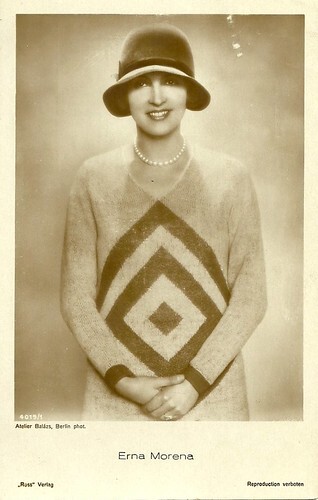
German postcard by Ross Verlag, no. 4019/1, 1929-1930. Photo: Atelier Balazs, Berlin.
Sources: Thomas Staedeli (Cyranos), Filmportal.de, Wikipedia (German), and .

German postcard by Messter Film GmbH. Photo: Schenker, 1914.

German postcard by NPG, no. 280. Photo: A. (Alex) Binder, Berlin.

German postcard in the Moderne Künstler series by MMB, no. 463. Photo: F.J. Wesselsky.

German postcard by Photochemie, Berlin, no. K. 1740. Photo: Alex Binder, Berlin.

German postcard by Ross Verlag, no. 1060/1, 1927-1928. Photo: Atelier Balázs, Berlin.
Bewildered by her subtle performance
Erna Morena was born Ernestine Maria Fuchs in a bourgeois family in Wörth am Main, Germany, in 1885. At the age of 17, she went to München (Munich) to attend the Kunstgewerbeschule (art school). Later, she spent six months in Paris, until finally at the end of the first decade she moved to Berlin and worked there as a nurse.
In 1910, Morena started her acting career at the Schauspielschule des Deutschen Theaters (the acting school of the German Theatre) and swiftly got an engagement at the Ensemble Max Reinhardt.
She made her film debut in 1913. Her first film was Sphynx/The Sphinx (Eugen Illés, 1913), and she went on to play in several more dramas by Eugen Illés for the Duskes company.
In 1914, she moved to the Messter Film company, where she appeared with Emil Jannings and Theodoor Loos in Arme Eva/Poor Eva (Robert Wiene, 1914) and with Hella Moja in Die weiße Rose/The White Rose (Franz Hofer, 1915).
From 1915 to 1921 she was married to editor and stage author Wilhelm Herzog, who had also invented her stage name, Erna Morena. All her Messter-films were distributed under the trademark of 'Erna Morena Film Serie', rivalling the series of Asta Nielsen and Henny Porten .
Around 1917 she moved to PAGU, where she starred in an adaptation of Franz Wedekind's play 'Lulu' (Alexander Antalffy, 1917) opposite Harry Liedtke and Emil Jannings , and in Paul Leni's Prima Vera (Paul Leni, 1917), based on Alexandre Dumas, fils' 'La Dame aux camélias' (Camille). Critics were bewildered by her subtle performance.
Morena also dabbled as a producer: in 1918 she founded Erna Morena Film GmbH in Berlin, supported by some friends as partners. She produced films like Colomba (Arzén von Cserépy, 1918) with Werner Krauss , and Die 999. Nacht/The 999th Night (Fred Sauer, 1920) with Hans Albers . Because of the economic crisis after the German November Revolution of 1918-1919, she had to stop producing after two years.

German postcard by Photochemie, Berlin, no. K. 150. Photo: Alex Binder, Berlin.

German postcard by Photochemie, Berlin, no. K. 1982. Photo: Union Film. Erna Morena in Prima Vera (Paul Leni, 1917).

German postcard by Photochemie, Berlin, no. K. 1986. Photo: Union-Film. Erna Morena in Rafaela/Wer weiss? (Arsen von Cserépy, 1917).

German postcard by Photochemie, Berlin, no. K. 1990. Photo: Union Film. Erna Morena, Emil Jannings and Harry Liedtke in Der Ring der Giuditta Foscari (Alfred Halm, 1917).

German postcard by Photochemie, no. K. 2923. Photo: Erna Morena-Film. Erna Morena in Die 999. Nacht/The 999th night (Fred Sauer, 1920).

German postcard by NPG, no. 257. Photo: Alex Binder, Berlin.
Her long neck and dark looks
Erna Morena was one of the most unusual stars of silent German cinema. Dark-haired, tall, and with distinctive facial features, she had a star appeal as later Greta Garbo had.
Morena was most successful with her films by director Richard Oswald in the late 1910s and early 1920s, such as Das Tagebuch einer Verlorenen/Diary of a Lost Woman (Richard Oswald, 1918) a forerunner of the version by Georg Wilhelm Pabst, and the horror film Nachtgestalten/Figures of the Night (1920) starring Paul Wegener .
She also starred in some classic Expressionist films including Nerven/Nerves (Robert Reinert, 1919), Von morgens bis Mitternacht/From Morn to Midnight (Karl Heinz Martin, 1920) with Ernst Deutsch , and Der Gang in die Nacht/The Dark Road (F.W. Murnau, 1921) with Olaf Fönss and Conrad Veidt .
With her long neck and dark looks she often played exotic beauties, as in Die Lieblingsfrau des Maharadscha, 3./The Favourite Wife of the Maharajah (Max Mack, 1921), and Das Indische Grabmal, 1. and 2./The Indian Tomb (Joe May, 1921), but also regal beauties in historical dramas as Fridericus Rex 1., 2., 3. and 4. (Arzén von Cserépy, 1922-1923) with Otto Gebühr , Wallenstein 1. and 2. (Rolf Randolf, 1925), Bismarck 1. and 2. (Ernst Wendt, 1925), and Das Schicksal derer von Habsburg/The destiny of the Habsburgs (Rolf Raffé, 1928) in which she played Empress Elisabeth - Sissi.
Of course there were also contemporary set stories like Der Berg des Schicksals/The Mountain of Destiny (Arnold Fanck, 1924) with Luis Trenker , the film that inspired Leni Riefenstahl to pursue a career in film; Mutter und Kind/Mother and Child (Carl Froehlich, 1924); Man spielt nicht mit Liebe/One Does Not Play with Love (G.W. Pabst, 1926) starring Werner Krauss and Lili Damita ; Grand Hotel (Johannes Guter, 1927) with a script by Bela Balazs, and Somnambul/The Somnambulist (Adolf Trotz, 1929) with Fritz Kortner .
She also played in one Dutch film, De bruut/The brute (1922) directed by Theo Frenkel, who had an active career in Germany in the 1920s, and in the French film Le fauteuil 47/ Chair no. 47 (Gaston Ravel, 1926) with Dolly Davis .

German postcard in the Film Sterne series by Rotophot, no. 529/2. Photo: Richard Oswald-Film. Erna Morena in Das Tagebuch einer Verlorenen/The Diary of a Lost Woman (Richard Oswald, 1918), based on the homonymous novel (1905) by Margarete Böhme. In 1929, G.W. Pabst would film another adaptation, starring Louise Brooks, while already in 1912 an earlier adaptation by Fritz Bernhardt had taken place.

German postcard by Photochemie, no. K. 1738. Photo: Alex Binder, Berlin.

German postcard by Photochemie, no. K. 1739. Photo: Alex Binder, Berlin.

German postcard by Photochemie, no. K. 1741. Photo: Alex Binder, Berlin.

German postcard by Ross Verlag, Berlin, no. 34/1. Photo: Ass-Film, Berlin. Erna Morena and Maria Forescu in the German silent film Götz von Berlichingen zubenannt mit der eisernen Hand (Hubert Moest, 1925), an adaptation of Goethe's historical play set in medieval times. Morena played the countess Ravenstein and Forescu a farmer's wife.

German postcard by Ross Verlag, no. 42/3. Photo: Karl Schenker / Bismarck-Film. Erna Morena as Johanna von Bismarck, née Puttkamer in the German biopic Bismarck, Teil. 1 (Ernst Wendt, 1925). Signed by Erna Morena.
Her heydays were over
Erna Morena seems to have made the passage to sound cinema quite smoothly as there was no big arrest in her number of film roles.
Still, from the young star and protagonist of the films of the late-1910s and early 1920s she had to be satisfied now with playing mothers, secondary roles. Her heydays were over.
Among her more interesting films of this period are Das Lied der Nationen/The Song of the Nations (Rudolf Meinert, 1931) with Camilla Horn , Eine Nacht im Paradies/A Night in Paradise (Carl Lamac, 1932) starring Anny Ondra, Drei Kaiserjäger/Three Imperial Light Infantrymen (Franz Hofer, Robert Land, 1933), and the operetta Abschiedswalzer/Farewell Waltz (Géza von Bolváry, 1934).
In the mid-1930s, she opened a pension for artists in München (Munich), and only returned to the film set for small parts in a handful of films, including the notorious Jud Süss ( Veit Harlan , 1940).
After the war, she appeared in only one film, Veit Harlan 's Unsterbliche Geliebte/Eternal Beloved (1951), an emblematic title as the film meant Morena's goodbye.
One decade later, Erna Morena died in München, in 1962. Between 1913 and 1951 she had appeared in about 120 films. She had a daughter, Eva-Maria Herzog.
In 2006 filmmakers Bettina Neuhaus and Natasja Giebels made a poetic film portrait about the life story and personality of Erna Morena, Schwarzer Schwan/Black Swan.

German postcard in the Film Sterne Series by Rotophot, no. 79/2. Photo: Karl Schenker, Berlin / P.A.G. Union.

German postcard in the Film Sterne Series by Rotophot, no. 79/5. Photo: Karl Schenker, Berlin / P.A.G. Union. Collection: Didier Hanson.

German postcard in the Film Sterne Series by Rotophot, no. 79/6. Photo: Karl Schenker, Berlin / P.A.G. Union.

German postcard by Ross Verlag, Berlin, no. 311/2, 1919-1924. Photo: Wasow, München (Munich). Erna Morena and her daughter.

German postcard by Ross Verlag, no. 3002/1, 1928-1929. Photo: Ufa.

German postcard by Ross Verlag, no. 3423/1, 1928-1929. Photo: Atelier Balázs, Berlin.

German postcard by Ross Verlag, no. 4019/1, 1929-1930. Photo: Atelier Balazs, Berlin.
Sources: Thomas Staedeli (Cyranos), Filmportal.de, Wikipedia (German), and .
Published on March 07, 2022 22:00
March 6, 2022
Ricky Nelson
American singer Ricky Nelson (1940-1985) was one of the first teenage stars in America. He started his career in his parents' television series The Adventures of Ozzie & Harriet. In the late 1950s, he had such hits as 'Hello Mary Lou' and he starred in the Western Rio Bravo (1959) with John Wayne.
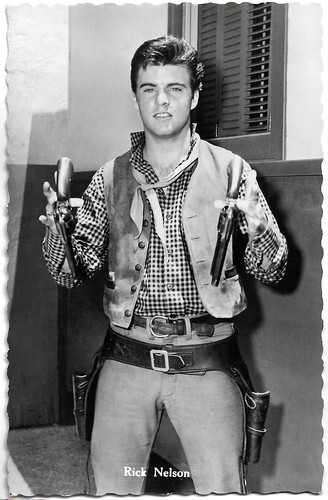
Dutch postcard, no. 961. Ricky Nelson in Rio Bravo (Howard Hawks, 1959).
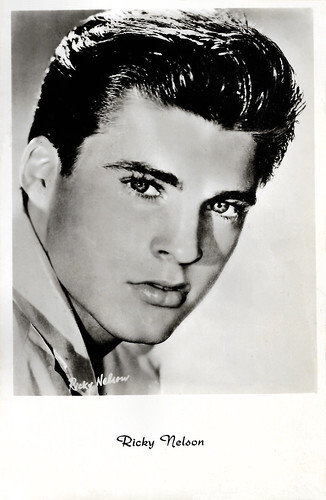
Dutch postcard by Gebr. Spanjersberg N.V., Rotterdam, no. 5229.
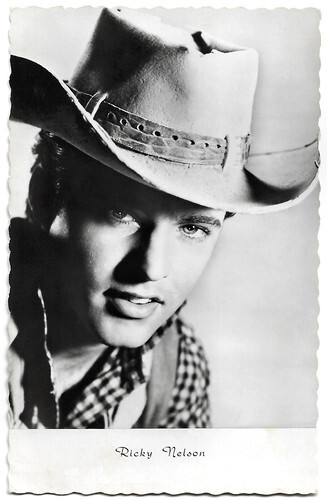
Dutch postcard by N.V. v. h. Weenenk & Snel, Baarn. Ricky Nelson in Rio Bravo (Howard Hawks, 1959).
One of the first teenage stars in America
Eric Hilliard 'Ricky' Nelson was born in Teaneck, New Jersey, in 1940. His father, Ozzie Nelson, was a bandleader, and his mother, Harriet Hilliard, was a singer in his father's band.
As a child, Ricky and his older brother David performed in their parents' radio show (1940-1952), in the film Here Come the Nelsons (Frederick De Cordova, 1959), and in the television series 'The Adventures of Ozzie & Harriet' (1952-1966). All episodes of the series were written by Ozzie Nelson, who also directed and often incorporated Ricky's actual songs into the shows.
Ricky became one of the first teenage stars in America when his rock and roll career took off in 1957. His first single, which he wanted to impress his girlfriend with, was released in April 1957 by the Verve record company and had 'I'm Walkin' (originally by Fats Domino) as its B-side.
Nelson's cover version rose to #4 on the best-selling charts and reached #17 on the Billboard Hot 100. The A-side, featuring the song 'Teenager's Romance', was even more successful and rose to #2 on the best-selling charts and #8 on the Billboard Hot 100, respectively. His appearance with the songs on his parents' television show played no small part in the rapid success of his first record.
In the following years, he became extremely popular with well-known hits like 'Hello Mary Lou', 'Travelin' Man' and 'Poor Little Fool'. During the late 1950s and early 1960s, he had 29 Top 40 hits, and only Elvis Presley and Pat Boone sold more records in the United States. Compared to his success in the US, his international success remained rather modest. His most successful song in Europe was 'Hello Mary Lou'(1961).
Ricky Nelson also worked as an actor. In 1959, he starred in the film Rio Bravo (Howard Hawks, 1959) with John Wayne and Dean Martin, and he performed the songs 'My Rifle, My Pony and Me' and 'Cindy, Cindy'. He was nominated for a Golden Globe for Best Newcomer for his performance in the film. Alongside Jack Lemmon, Nelson starred in the comedy The Wackiest Ship In The Army (Richard Murphy, 1960).
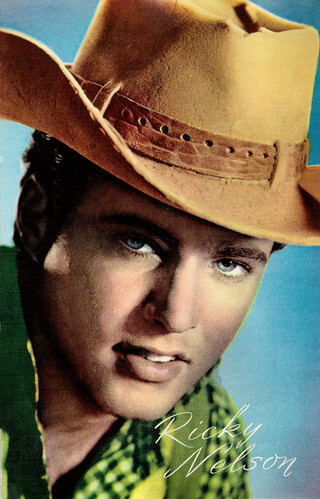
Vintage postcard. Ricky Nelson in Rio Bravo (Howard Hawks, 1959).
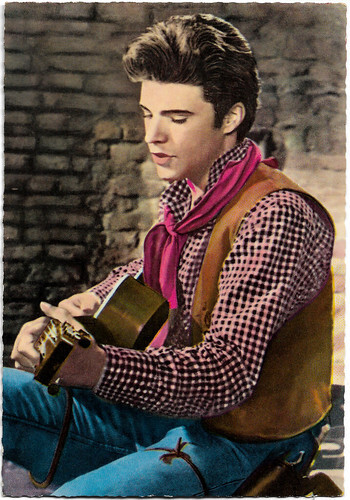
West-German postcard by ISV, no. H 44. Ricky Nelson in Rio Bravo (Howard Hawks, 1959).
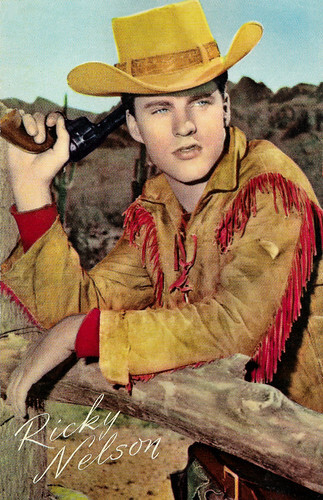
Vintage postcard. Ricky Nelson in Rio Bravo (Howard Hawks, 1959).
The first video clip ever made
With the release of the LP 'Rick is 21', Nelson dropped the "y" from his name and released under the name 'Rick Nelson' from September 1961. He made a promo clip for the hit 'Travelin' Man' (1961), which is considered the first video clip ever made. The promo clip consists of images of places that are sung about in the song.
In 1963 he signed a 20-year contract with Decca Records, but after 'For You' (1964) he had no more major hits. The 'British Invasion' of the English beat groups also meant a career break for him, as for many other teenage idols. In 1966, the last episode of the TV series 'The Adventures Of Ozzie And Harriet' ran, leaving him without an important mainstay of his success.
Nelson changed his musical style and went from Rock and Roll more into country music. His fans did not appreciate this very much. He took on two more roles in TV Westerns also starring his wife Kristin Harmon, The Over-The-Hill-Gang (Richard Murphy, 1969) starring Walter Brennan, and The Resurrection of Bronco Billy (James R. Rokos, 1970) starring Johnny Crawford.
Nelson wrote the song 'Garden Party' (1972), in response to the unwillingness of the public to grant him a new repertoire. The song promptly became a hit, Two years later, another modest success followed with 'Windfall'. In the 1970s and 1980s, he fell into oblivion, until 1985, when he successfully participated in a series of golden oldie concerts in England. This led to a similar tour in the southern United States.
During this tour, on New Year's Eve 1985, he died in a plane crash in Texas. His girlfriend Helen Blair and all the members of the Stone Canyon Band died with him. He was 45 years old. From 1963 to 1981, Nelson was married to Kristin Harmon, the older sister of actor Mark Harmon. Their twin sons, Gunnar and Matthew, later formed the pop group Nelson, which had a number one hit in America in 1990 with '(Can't live without your) love and affection'. Their daughter, Tracy Nelson, starred in the series Father Dowling Mysteries. Ricky Nelson was buried at Forest Lawn Memorial Park in Hollywood.
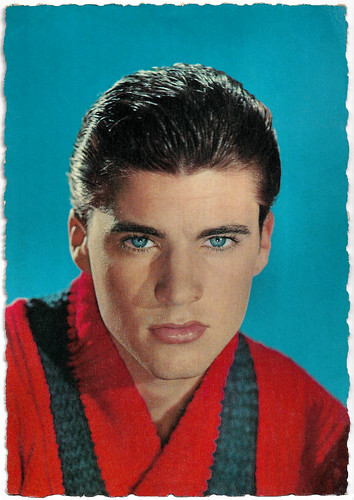
French postcard by E.D.U.G., no. 42.
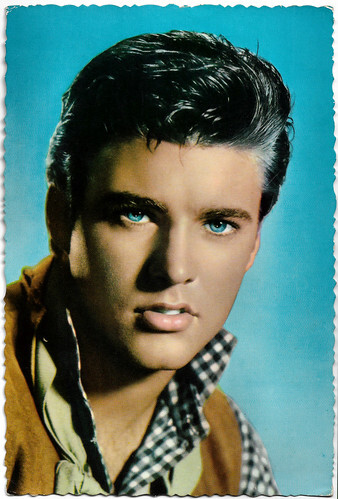
Spanish postcard by Archivo Bermejo, no. C 15, 1961.
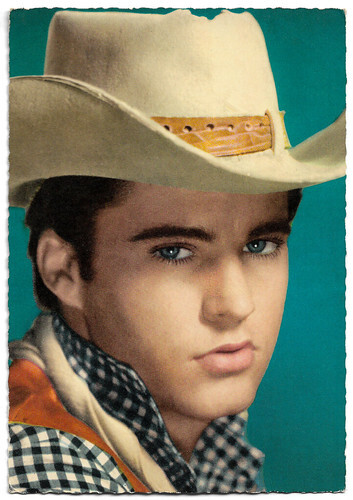
West-German postcard by ISV, no. H 65.
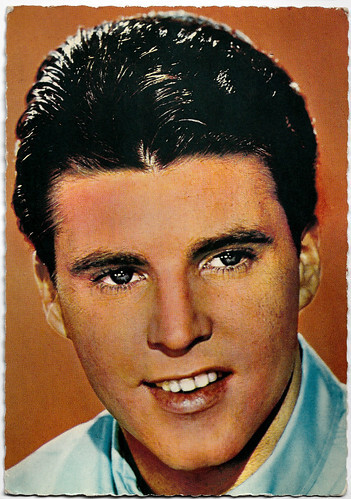
Dutch postcard, no. 504.
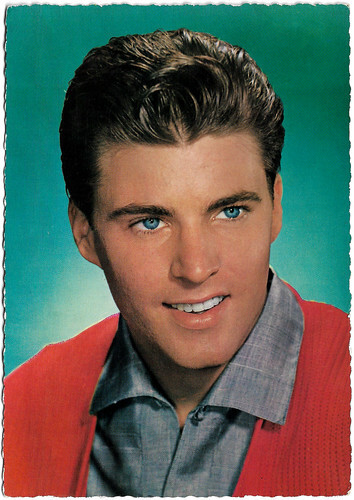
French postcard by E.D.U.G., no. 175.
Sources: Wikipedia (Dutch and German) and .

Dutch postcard, no. 961. Ricky Nelson in Rio Bravo (Howard Hawks, 1959).

Dutch postcard by Gebr. Spanjersberg N.V., Rotterdam, no. 5229.

Dutch postcard by N.V. v. h. Weenenk & Snel, Baarn. Ricky Nelson in Rio Bravo (Howard Hawks, 1959).
One of the first teenage stars in America
Eric Hilliard 'Ricky' Nelson was born in Teaneck, New Jersey, in 1940. His father, Ozzie Nelson, was a bandleader, and his mother, Harriet Hilliard, was a singer in his father's band.
As a child, Ricky and his older brother David performed in their parents' radio show (1940-1952), in the film Here Come the Nelsons (Frederick De Cordova, 1959), and in the television series 'The Adventures of Ozzie & Harriet' (1952-1966). All episodes of the series were written by Ozzie Nelson, who also directed and often incorporated Ricky's actual songs into the shows.
Ricky became one of the first teenage stars in America when his rock and roll career took off in 1957. His first single, which he wanted to impress his girlfriend with, was released in April 1957 by the Verve record company and had 'I'm Walkin' (originally by Fats Domino) as its B-side.
Nelson's cover version rose to #4 on the best-selling charts and reached #17 on the Billboard Hot 100. The A-side, featuring the song 'Teenager's Romance', was even more successful and rose to #2 on the best-selling charts and #8 on the Billboard Hot 100, respectively. His appearance with the songs on his parents' television show played no small part in the rapid success of his first record.
In the following years, he became extremely popular with well-known hits like 'Hello Mary Lou', 'Travelin' Man' and 'Poor Little Fool'. During the late 1950s and early 1960s, he had 29 Top 40 hits, and only Elvis Presley and Pat Boone sold more records in the United States. Compared to his success in the US, his international success remained rather modest. His most successful song in Europe was 'Hello Mary Lou'(1961).
Ricky Nelson also worked as an actor. In 1959, he starred in the film Rio Bravo (Howard Hawks, 1959) with John Wayne and Dean Martin, and he performed the songs 'My Rifle, My Pony and Me' and 'Cindy, Cindy'. He was nominated for a Golden Globe for Best Newcomer for his performance in the film. Alongside Jack Lemmon, Nelson starred in the comedy The Wackiest Ship In The Army (Richard Murphy, 1960).

Vintage postcard. Ricky Nelson in Rio Bravo (Howard Hawks, 1959).

West-German postcard by ISV, no. H 44. Ricky Nelson in Rio Bravo (Howard Hawks, 1959).

Vintage postcard. Ricky Nelson in Rio Bravo (Howard Hawks, 1959).
The first video clip ever made
With the release of the LP 'Rick is 21', Nelson dropped the "y" from his name and released under the name 'Rick Nelson' from September 1961. He made a promo clip for the hit 'Travelin' Man' (1961), which is considered the first video clip ever made. The promo clip consists of images of places that are sung about in the song.
In 1963 he signed a 20-year contract with Decca Records, but after 'For You' (1964) he had no more major hits. The 'British Invasion' of the English beat groups also meant a career break for him, as for many other teenage idols. In 1966, the last episode of the TV series 'The Adventures Of Ozzie And Harriet' ran, leaving him without an important mainstay of his success.
Nelson changed his musical style and went from Rock and Roll more into country music. His fans did not appreciate this very much. He took on two more roles in TV Westerns also starring his wife Kristin Harmon, The Over-The-Hill-Gang (Richard Murphy, 1969) starring Walter Brennan, and The Resurrection of Bronco Billy (James R. Rokos, 1970) starring Johnny Crawford.
Nelson wrote the song 'Garden Party' (1972), in response to the unwillingness of the public to grant him a new repertoire. The song promptly became a hit, Two years later, another modest success followed with 'Windfall'. In the 1970s and 1980s, he fell into oblivion, until 1985, when he successfully participated in a series of golden oldie concerts in England. This led to a similar tour in the southern United States.
During this tour, on New Year's Eve 1985, he died in a plane crash in Texas. His girlfriend Helen Blair and all the members of the Stone Canyon Band died with him. He was 45 years old. From 1963 to 1981, Nelson was married to Kristin Harmon, the older sister of actor Mark Harmon. Their twin sons, Gunnar and Matthew, later formed the pop group Nelson, which had a number one hit in America in 1990 with '(Can't live without your) love and affection'. Their daughter, Tracy Nelson, starred in the series Father Dowling Mysteries. Ricky Nelson was buried at Forest Lawn Memorial Park in Hollywood.

French postcard by E.D.U.G., no. 42.

Spanish postcard by Archivo Bermejo, no. C 15, 1961.

West-German postcard by ISV, no. H 65.

Dutch postcard, no. 504.

French postcard by E.D.U.G., no. 175.
Sources: Wikipedia (Dutch and German) and .
Published on March 06, 2022 22:00
March 5, 2022
26 black and white cards by Acin
Last week, EFSP presented a selection of colour postcards by Casa Filmului Acin from Romania, one of the best-known film postcard publishers from Communist Eastern Europe. Acin also produced countless black and white cards with scenes from European films of the late-1950s, 1960s and early 1970s. It's great that some of the classics of Ingmar Bergman, Luis Buñuel and Michelangelo Antonioni were included but also Spaghetti Westerns with Franco Nero and Bud Spencer & Terence Hill, Eurospy films, the Angélique adventures, and the Louis de Funès comedies.
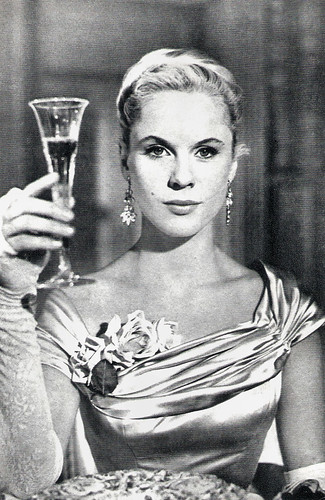
Romanian postcard by Casa Filmului Acin, no. 53. Photo: Bibi Andersson in Smultronstället/Wild Strawberries (Ingmar Bergman, 1957).
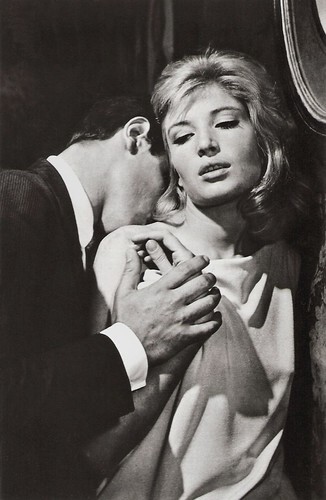
Romanian postcard by Casa Filmului Acin. Photo: Monica Vitti and Alain Delon in L'eclisse/The Eclypse (Michelangelo Antonioni, 1962).
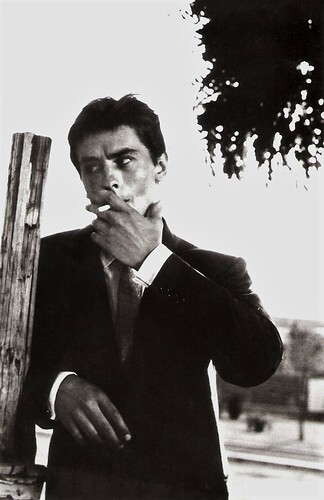
Romanian postcard by Casa Filmului Acin. Photo: Alain Delon in L'eclisse/The Eclypse (Michelangelo Antonioni, 1962).
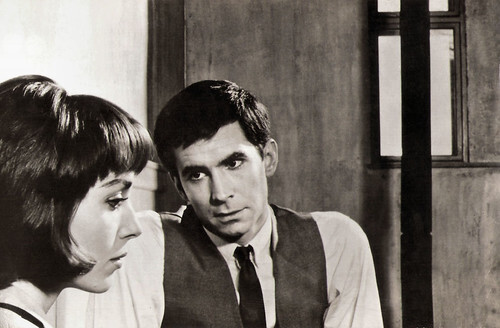
Romanian postcard by Casa Filmului Acin, no. 470. Photo: Elsa Martinelli and Anthony Perkins in Le procès/The Trial (Orson Welles, 1962). Sent by mail in 1972.
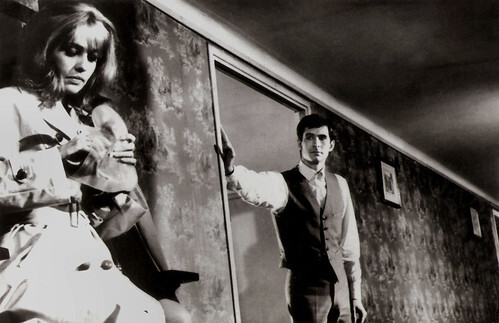
Romanian postcard by Casa Filmului Acin, no. 471. Photo: Jeanne Moreau and Anthony Perkins in Le procès/The Trial (Orson Welles, 1962).
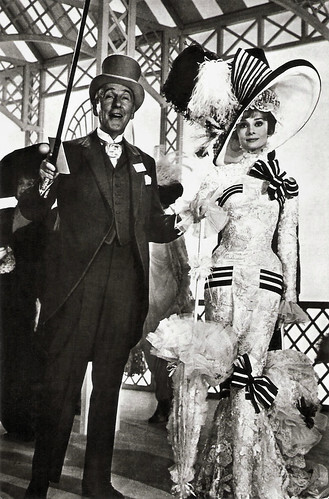
Romanian postcard by Casa Filmului Acin, no. 261. Wilfrid Hyde-White and Audrey Hepburn in My Fair Lady (George Cukor, 1964).
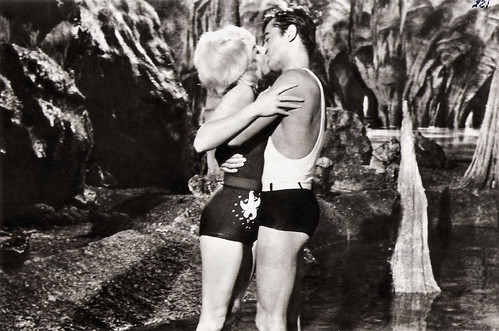
Romanian postcard by Casa Filmului Acin, no. 313. Photo: Alain Delon and Shirley MacLaine in The Yellow Rolls-Royce (Anthony Asquith, 1964).
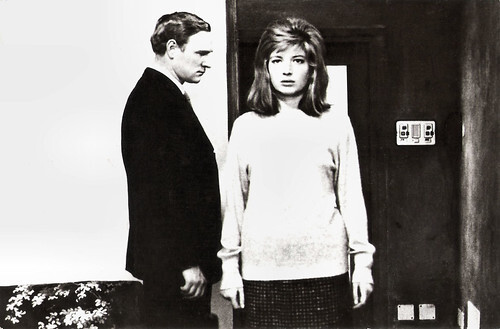
Romanian postcard by Casa Filmului Acin, no. 322. Photo: Monica Vitti and Richard Harris in Il deserto rosso/Red Desert (Michelangelo Antonioni, 1964).
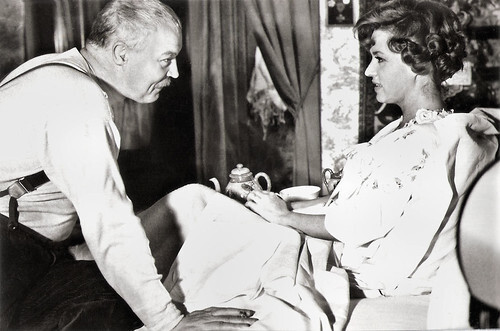
Romanian postcard by Casa Filmului Acin, no. 445. Photo: Daniel Ivernel and Jeanne Moreau in Le journal d'une femme de chambre/The Diary of a Chambermaid (Luis Buñuel, 1964).
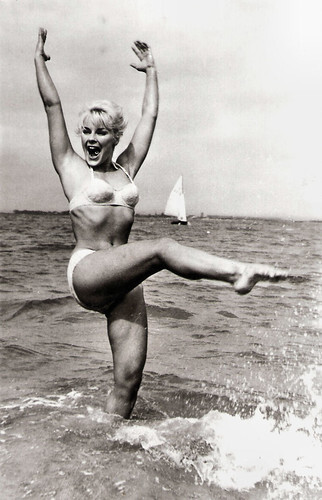
Romanian postcard by Casa Filmului Acin, no. 502. Elke Sommer .
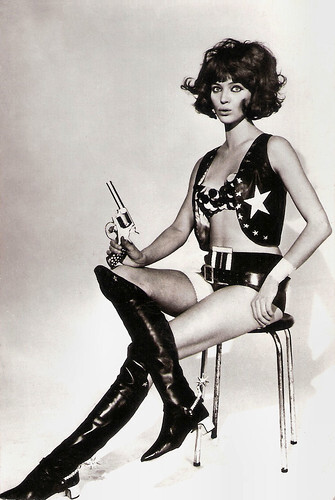
Romanian postcard by Casa Filmului Acin, no. 209. Anna Karina .
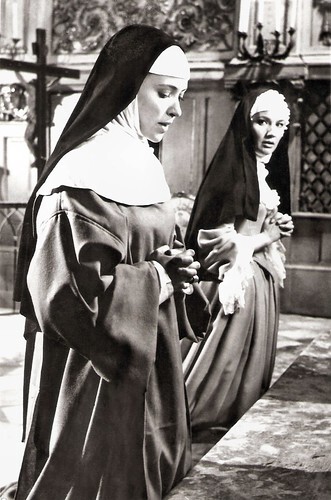
Romanian postcard by Casa Filmului Acin, no. 265. Photo: Anna Karina in La Religieuse/The Nun (Jacques Rivette, 1966).
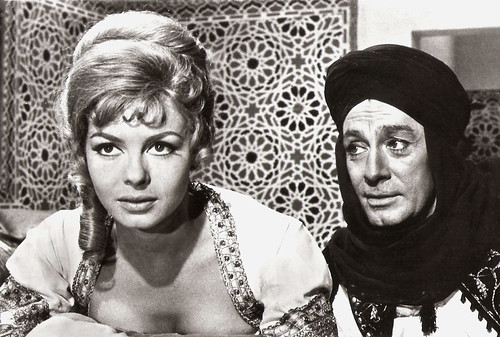
Romanian postcard by Casa Filmului Acin. Photo: Michèle Mercier and Jean-Claude Pascal in Angelique et le sultan/Angelique and the sultan (Bernard Borderie, 1966).
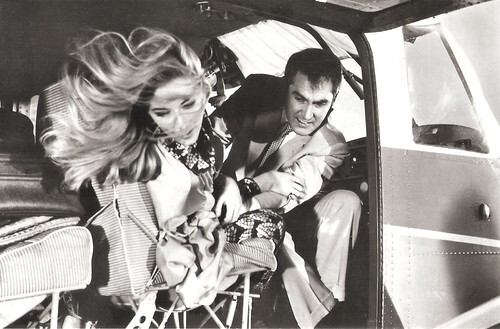
Romanian postcard by Casa Filmului Acin. Photo: Daniela Bianchi and Jacques Bergerac in Missione speciale Lady Chaplin/Operation Lady Chaplin (Alberto De Martino, Sergio Grieco, 1966).
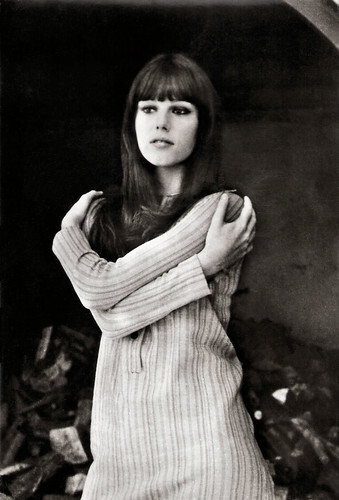
Romanian postcard by Casa Filmului Acin. Stefania Sandrelli.
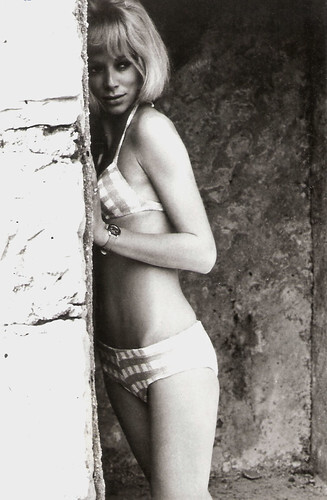
Romanian postcard by Casa Filmului Acin. Mireille Darc .
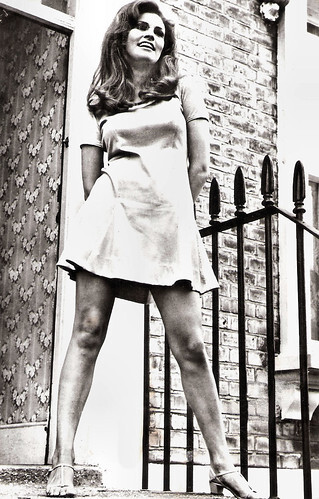
Romanian postcard by Casa Filmului Acin, no. 350. Raquel Welch at the set of Bedazzled (Stanley Donen, 1967).
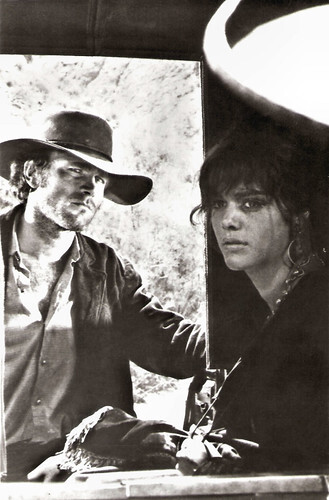
Romanian postcard by Casa Filmului Acin. Photo: Tina Aumont and Franco Nero in L'uomo, l'orgoglio, la vendetta/Man, Pride & Vengeance (Luigi Bazzoni, 1967).
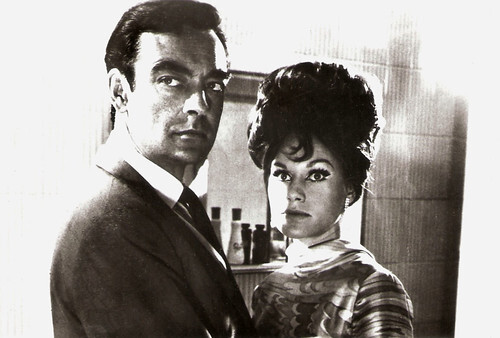
Romanian postcard by Casa Filmului Acin. Photo: Richard Johnson and Suzanna Leigh Deadlier than the male (Ralph Thomas, 1967).
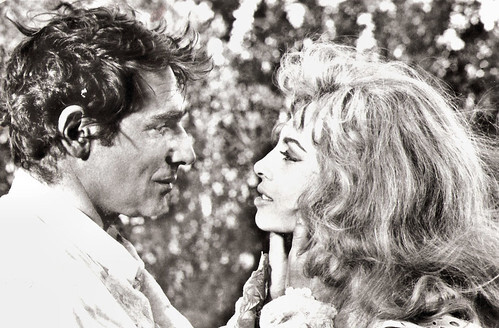
Romanian postcard by Casa Filmului Acin. Photo: Robert Hossein and Michèle Mercier in Indomptable Angelique/Untamable Angélique (Bernard Borderie, 1967).
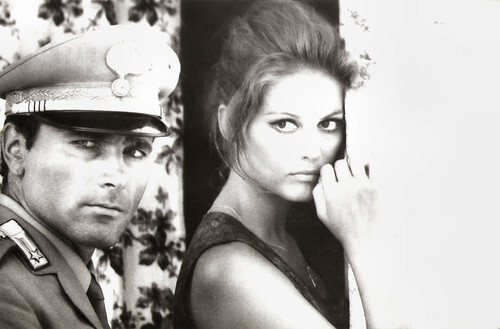
Romanian postcard by Casa Filmului Acin, no. 427. Photo: Franco Nero and Claudia Cardinale in Il giorno della civetta/The Day of the Owl (Damiano Damiani, 1968).
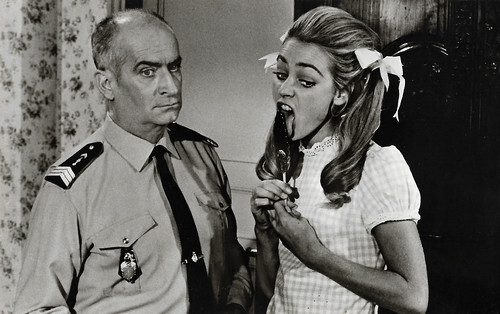
Romanian postcard by Casa Filmului Acin, no. 541. Retail price: 1,50 Lei. Photo: Louis de Funès and Geneviève Grad in Le gendarme se marie/The Gendarme Gets Married (Jean Girault, 1968).
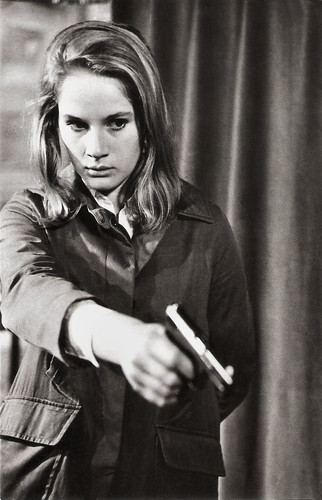
Romanian postcard by Casa Filmului Acin, no. 429. Dominique Sanda in Une femme douce/A Gentle Creature (Robert Bresson, 1969).
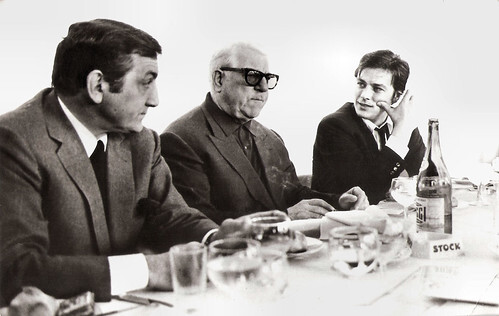
Romanian postcard by Cas Filmului Acin, no. 436. Photo: Lino Ventura , Jean Gabin and Alain Delon in Le clan des Siciliens/The Sicilian Clan (Henri Verneuil, 1969).
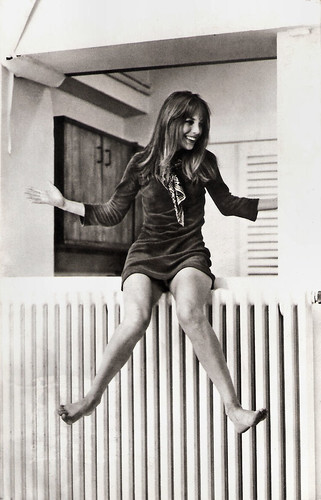
Romanian postcard by Casa Filmului Acin, no. 448. Photo: Jane Birkin in Slogan (Pierre Grimblat, 1969).
Romanian postcard by Casa Filmului Acin. Photo: Bud Spencer and Terence Hill in Continuavano a chiamarlo Trinità/Trinity is still my name (Enzo Barboni a.k.a. E.B. Clucher, 1971).
And check out our earlier post on Acin or visit Flickr where you can see more Acin postcards our Acin album or in the Casa Filmului Acin group.

Romanian postcard by Casa Filmului Acin, no. 53. Photo: Bibi Andersson in Smultronstället/Wild Strawberries (Ingmar Bergman, 1957).

Romanian postcard by Casa Filmului Acin. Photo: Monica Vitti and Alain Delon in L'eclisse/The Eclypse (Michelangelo Antonioni, 1962).

Romanian postcard by Casa Filmului Acin. Photo: Alain Delon in L'eclisse/The Eclypse (Michelangelo Antonioni, 1962).

Romanian postcard by Casa Filmului Acin, no. 470. Photo: Elsa Martinelli and Anthony Perkins in Le procès/The Trial (Orson Welles, 1962). Sent by mail in 1972.

Romanian postcard by Casa Filmului Acin, no. 471. Photo: Jeanne Moreau and Anthony Perkins in Le procès/The Trial (Orson Welles, 1962).

Romanian postcard by Casa Filmului Acin, no. 261. Wilfrid Hyde-White and Audrey Hepburn in My Fair Lady (George Cukor, 1964).

Romanian postcard by Casa Filmului Acin, no. 313. Photo: Alain Delon and Shirley MacLaine in The Yellow Rolls-Royce (Anthony Asquith, 1964).

Romanian postcard by Casa Filmului Acin, no. 322. Photo: Monica Vitti and Richard Harris in Il deserto rosso/Red Desert (Michelangelo Antonioni, 1964).

Romanian postcard by Casa Filmului Acin, no. 445. Photo: Daniel Ivernel and Jeanne Moreau in Le journal d'une femme de chambre/The Diary of a Chambermaid (Luis Buñuel, 1964).

Romanian postcard by Casa Filmului Acin, no. 502. Elke Sommer .

Romanian postcard by Casa Filmului Acin, no. 209. Anna Karina .

Romanian postcard by Casa Filmului Acin, no. 265. Photo: Anna Karina in La Religieuse/The Nun (Jacques Rivette, 1966).

Romanian postcard by Casa Filmului Acin. Photo: Michèle Mercier and Jean-Claude Pascal in Angelique et le sultan/Angelique and the sultan (Bernard Borderie, 1966).

Romanian postcard by Casa Filmului Acin. Photo: Daniela Bianchi and Jacques Bergerac in Missione speciale Lady Chaplin/Operation Lady Chaplin (Alberto De Martino, Sergio Grieco, 1966).

Romanian postcard by Casa Filmului Acin. Stefania Sandrelli.

Romanian postcard by Casa Filmului Acin. Mireille Darc .

Romanian postcard by Casa Filmului Acin, no. 350. Raquel Welch at the set of Bedazzled (Stanley Donen, 1967).

Romanian postcard by Casa Filmului Acin. Photo: Tina Aumont and Franco Nero in L'uomo, l'orgoglio, la vendetta/Man, Pride & Vengeance (Luigi Bazzoni, 1967).

Romanian postcard by Casa Filmului Acin. Photo: Richard Johnson and Suzanna Leigh Deadlier than the male (Ralph Thomas, 1967).

Romanian postcard by Casa Filmului Acin. Photo: Robert Hossein and Michèle Mercier in Indomptable Angelique/Untamable Angélique (Bernard Borderie, 1967).

Romanian postcard by Casa Filmului Acin, no. 427. Photo: Franco Nero and Claudia Cardinale in Il giorno della civetta/The Day of the Owl (Damiano Damiani, 1968).

Romanian postcard by Casa Filmului Acin, no. 541. Retail price: 1,50 Lei. Photo: Louis de Funès and Geneviève Grad in Le gendarme se marie/The Gendarme Gets Married (Jean Girault, 1968).

Romanian postcard by Casa Filmului Acin, no. 429. Dominique Sanda in Une femme douce/A Gentle Creature (Robert Bresson, 1969).

Romanian postcard by Cas Filmului Acin, no. 436. Photo: Lino Ventura , Jean Gabin and Alain Delon in Le clan des Siciliens/The Sicilian Clan (Henri Verneuil, 1969).

Romanian postcard by Casa Filmului Acin, no. 448. Photo: Jane Birkin in Slogan (Pierre Grimblat, 1969).
Romanian postcard by Casa Filmului Acin. Photo: Bud Spencer and Terence Hill in Continuavano a chiamarlo Trinità/Trinity is still my name (Enzo Barboni a.k.a. E.B. Clucher, 1971).
And check out our earlier post on Acin or visit Flickr where you can see more Acin postcards our Acin album or in the Casa Filmului Acin group.
Published on March 05, 2022 22:00
Paul van Yperen's Blog
- Paul van Yperen's profile
- 13 followers
Paul van Yperen isn't a Goodreads Author
(yet),
but they
do have a blog,
so here are some recent posts imported from
their feed.



